|
"India
the name which launched a thousand
ships, and which has fired the imagination of explorers for
ages, predates the emergence of Islam and Western Indology, by
centuries, if not millennia.
"
***
Ancient
nuclear blasts in India - By Alexander Pechersky
The
great ancient Indian epic, the Mahabharata,
contains numerous legends about the powerful force of a
mysterious weapon.
The
archaeological expedition, which carried out excavations near
the Indian settlement of Mohenjo-Daro in the beginning of the
1900s, uncovered the ruins of a big ancient town. The town
belonged to one of the most developed civilizations in the
world. The ancient civilization existed for two or three
thousand years. However, scientists were a lot more interested
in the death of the town, rather than in its prosperity. Researchers tried to explain the reason of the town's destruction with
various theories. However, scientists did not find any
indications of a monstrous flood, skeletons were not numerous,
there were no fragments of weapons, or anything else that could
testify either to a natural disaster or a war. Archaeologists
were perplexed: according to their analysis the catastrophe in
the town had occurred very unexpectedly and it did not last
long.
Scientists
Davneport and Vincenti
put forward an amazing theory. They
stated the ancient town had been ruined with a nuclear blast.
They found big stratums of clay and green glass. Apparently,
archaeologists supposed, high temperature melted clay and sand
and they hardened immediately afterwards. Similar stratums of
green glass can also found in Nevada deserts after every nuclear
explosion.
A
hundred years have passed since the excavations in Mohenjo-Daro.
The modern analysis showed, the fragments of the ancient town
had been melted with extremely high temperature - not less than
1,500 degrees centigrade. Researchers also found the
strictly outlined epicenter, where all houses were leveled.
Destructions lessened towards the outskirts. Dozens of skeletons
were found in the area of Mohenjo-Daro - their radioactivity
exceeded the norm almost 50 times.
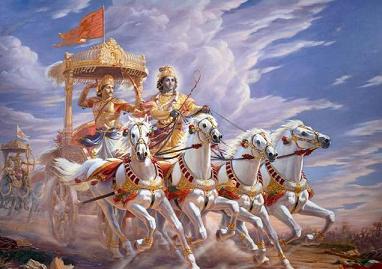
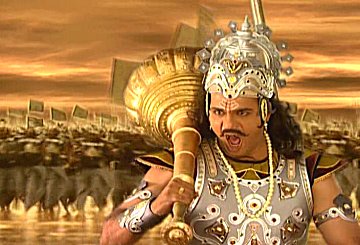
The
great ancient Indian epic, the Mahabharata, contains numerous
legends about the powerful force of a mysterious weapon.
(Artwork
courtesy of The Bhaktivedanta Book Trust International, Inc. www.krishna.com).
***
The
great ancient Indian epic, the Mahabharata, contains numerous
legends about the powerful force of a mysterious weapon. One of
the chapters tells of a shell, which sparkled like fire, but had
no smoke. "When the shell hit the ground, the darkness
covered the sky, twisters and storms leveled the towns. A
horrible blast burnt thousands of animals and people to ashes.
Peasants, townspeople and warriors dived in the river to wash
away the poisonous dust."
***
Modern
people divide the day into 24 hours, the hour - into 60 minutes,
the minute - into 60 seconds. Ancient Hindus divided the day in
60 periods, lasting 24 minutes each, and so on and so forth. The
shortest time period of ancient Hindus made up
one-three-hundred-millionth of a second.
(source: Ancient
nuclear blasts and levitating stones of Shivapur - By Alexander Pechersky
- pravda.ru.com).
For more refer to chapter on Vimanas
and War
in Ancient India). (For
more refer to chapter on Greater
India: Suvarnabhumi and
Sacred
Angkor).
Top of Page
“I
am a Hindu because it is Hinduism which makes the world worth
living.” – said Mahatma Gandhi
-
source: Young India
1-12-26.
India's
National Disgrace - Attack on Symbols of the Hindu
Universe
Arrest
of Kanchi Shankaracharya on Diwali - Secular duplicity?
An Unholy Mess
- Shock,
Anger across the World
"This
is clearly a political vendetta by unspiritual people designed
to denigrate Hindu Dharma. The consequences of it are grave for
the spiritual future of India and of the entire
world." - David
Frawley.
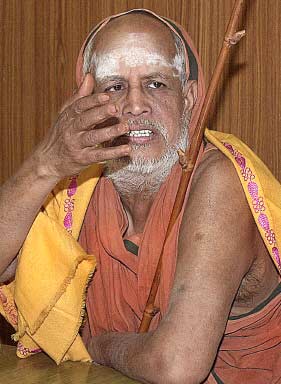
Kanchi Shankaracharya Jayendra Saraswati is one of the
most respected figures for Hindus.
More than the individual, the
institution of the Kanchi Kamakoti Peetham, of which he is the
reigning pontiff, stands tall as one of the symbols of the Hindu
universe as it was founded by Adi Shankara as the southern
boundary of Bharatvarsha.
Therefore, his arrest on seemingly
flimsy grounds amounts to unwarranted humiliation of a revered
shrine as well as its presiding head.
(For
more refer to chapter on Greater
India: Suvarnabhumi and
Sacred
Angkor).
***
Kanchi Shankaracharya Jayendra
Saraswati is one of the most respected figures for Hindus. More
than the individual, the institution of the Kanchi Kamakoti
Peetham, of which he is the reigning pontiff, stands tall as one
of the symbols of the Hindu universe as it was founded by
Adi
Shankara as the southern boundary of Bharatvarsha. Therefore,
his arrest on seemingly flimsy grounds amounts to unwarranted
humiliation of a revered shrine as well as its presiding head.
The Tamil Nadu Government does not realise that it is playing
with fire by pushing the frontiers of minorityism.
The usual excuses offered for arresting a person of relatively
less political consequence (which are always forgotten in the
case of those with the right contacts) are being advanced to
justify the humiliation meted out to this savant. The murder of
the Mutt's employee perhaps gave the J Jayalalithaa regime the
entry point to competitive Hindu-baiting
which promises to pay huge political dividends. To appease vote banks,
she had withdrawn the order against conversion and had even
toned down her earlier stated position on Ms Sonia Gandhi's
legitimacy in Indian politics. The manner in which the DMK was
baying for the Shankaracharya's blood in the aftermath of the
murder may have raised the political temperature to an
undesirable level, pushing Ms Jayalalithaa to a corner.
'Secular' revellers, meanwhile, are
living it up. The Imam of Jama Masjid has never appeared in
court to answer more than half-dozen summons against him. In
Kerala, Industries Minister Kunnhiali Kutty is accused of
involvement in a sex racket, but his position in the State
Cabinet is secure. To make doubly sure, Muslim League hoods are
going about terrorising journalists of Mathrubhumi from carrying
out their professional duty of questioning the double standards
of 'secular' governance. The CBI has been asked to discontinue
the prosecution of Congress leader Satish Sharma while the
income tax department has been stopped from booking
Mr Lalu
Prasad Yadav in a disproportionate assets case. The undermining
of civil society is getting more brazen with each passing day.
The Shankaracharya episode seems just the beginning of a
vendetta aimed at silencing the cultural opposition posed by
Hindu self-esteem.
Shankaracharya
tour programme was announced on the
Peetham's website well in advance and he never travels abroad.
So what was the necessity of putting him through a night-long
ordeal, and that too on the auspicious occasion of Diwali?
(source: Secular
duplicity - dailypioneer.com - November 15 2004).
Dalits
angered at Seer's Arrest
Tamil
Brahmins may or may not have come out in support of arrested
Jayendra Saraswathi, but sections of the underprivileged Dalit
classes have expressed anger at the treatment meted out to the
seer.
Among the first to come out on the
streets were members of the Hindu
Munnani, a Hindu group primarily comprising
Dalits. Activists of this group have
also clashed with police outside courts in Chennai and
Kanchipuram. They have also staked out in front of the Vellore
jail where the Shankaracharya has spent a week for his suspected
involvement in the murder of a former accountant of the
Kanchipuram mutt. Four Dalit hamlets in
Porayar of the Nagapattinam district, 600 km south of the Tamil
Nadu capital, are stunned by his arrest. In the pontiff's
birthplace, Irulneeki village, there is considerable anger among
the 150 Dalit families over the arrest of the Shankaracharya who
was reportedly in the process of making it a model village.
Jayendra Saraswathi formed the Chandrasekara Rural Development
Trust there to launch several development schemes.The trust is
credited with constructing 40 model group houses and a health
centre with two doctors and six paramedics to help. Supported by
the mutt, the Tamil Nadu government has also taken up a pilot
scheme for Dalit housing in the village.
Members of the scheduled tribe of 'Kattunanyakans', who are
scavengers by profession, received financial help from the
Shankaracharya to build a temple for the Amman mother goddess in
1992. Now Natesan, the village council
chief, tells journalists with tears in his eyes: "Shankaracharya
taught us to worship. When many still considered us
untouchables, he treated us with dignity". Similar
is the outpouring of protest in Rajivpuram, where another such
temple is under construction, thanks to funds from the
Kanchipuram mutt.
In
the Bhudanoor village, 200 Dalit families have stories about the
ways in which the Shankaracharya helped them.
The Shankaracharya has taken much flak for reaching out to
Dalits. Critics
accused him of breaking Hindu codes by blessing widows and
Dalits and allowing general access to the mutt and temples.
(source: No
reservations, Dalits back seer
- timesofindia.com).
For more information - refer to http://www.kanchi-sathya.org/
Kanchi
Acharya first pontiff to mingle with Dalits'
Cuddalore, Nov. 27 - The Kanchi
Sankaracharya, Sri Jayendra Saraswathi, is the first pontiff in
the Sankara Mutt lineage to mingle with the Dalits and other
downtrodden sections. Hence, his arrest is regrettable, Vai.
Balasundaram, State president of the Ambedkar Makkal Iyakkam,
said here today. He told presspersons that he did not want to go
into the details of the arrest as it was sub-judice. From
his association with the Acharya for the past several years, he
had learnt about the humane side of Jayendra Saraswathi, who had
contributed a great deal to the uplift of the downtrodden.
Without
any inhibitions the Acharya had stayed in a hut of a Dalit,
Chelladurai, at Ramancheri, near Thiruttani, recently and
offered his blessings. The Acharya had also
established the Ambedkar Maha Sabha for the welfare of the
Dalits.
(source:
Kanchi
Acharya first pontiff to mingle with Dalits -
hindu.com).
Dalit
Hindu Peoples’ Sabha Condemns
"
Kanchi
seer has to be released immediately. Arresting him at mid-night
and throwing him into jail like an ordinary criminal is
condemnable" said Dalit
Hindu Makkal Sabha.
"Besides
doing spiritual work. the Swamigal was carrying on the work of consolidation
of the society, Education, and health .the arrest has been carried
out just to put hurdles in this work
and to tarnish the image of the Mutt. The other reasons
are to appease the other religions the threats of the
anti-Hindu parties". "Arresting
a Hindu religious leader on false charges ,arresting him at
midnight and putting him in jail as an ordinary criminal has
evoked the opposition of the entire Hindu community. Hence
he should be released immediately. To show our opposition
we had demonstrated twice under the leadership of our
state leader Ganesh. If
the seer is not released immediately a massive demonstration
will be organized." the release of the Dalit Hindu
Makkal Sabha said. (Dinamalr:
21.11.04).
***
India Desecrated
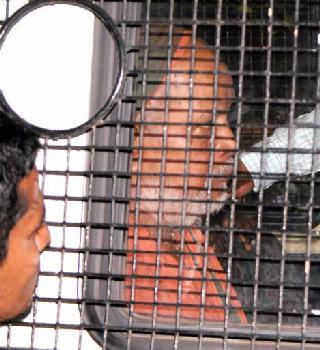
Can
the Pope be arrested like this?
The illiterate cub reporters of
various Indian TV channels are having a field day, mouthing inanities
against all that India has held sacred for millennia.
Refer to The
Criminal History of Papacy and Sex,
lies and videotape: turmoil at the
Vatican
and
Vatican
forced to acknowledge debauched behaviour of priests and nuns
and Victims
of pedophile Christian priests and
Pedophiles
and Priests: Anatomy of a Contemporary Crisis - By Philip
Jenkins.
***
One of the
greatest institutions of India that has stood for several
centuries as a bright symbol of the continuing authority of
dharma on this land has been desecrated. The event was meant to
be a slap in the face of all those Indians, who believe in
dharma and the civilisational traditions of India. It is a sad
commentary on the state of India, that in spite of this great
desecration, the nation continued to behave as if nothing has
happened.
Except for token protests from
certain foreseeable quarters, the nation has not stirred. The
reigning Sankaracharya of Kanchi Kamakoti Peetham is behind
bars. The illiterate cub reporters of
various channels are having a field day, mouthing inanities
against all that India has held sacred for millennia. Mr. N.
Ram, (Editor of The
Hindu) that arch-enemy of Hinduism, is gleefully pontificating
about the majesty of law. That epitome of the
superciliousness of modern educated Indians, the Congress
spokesman, Mr. Abhishek Singhvi, is pompously announcing the
great dictum that the Sanakaracharya has not only been arrested,
he shall also be punished if found guilty at the end of the
trial. The leader of the anti-Hindu atheistic movements, Sri
Karunanidhi, is saying that the occasion should be used for
making laws restraining all saintly persons in general.
(source: India
Desecrated
- Center for Policy Studies). Refer to The
Criminal History of Papacy and Sex,
lies and videotape: turmoil at the
Vatican
and
Vatican
forced to acknowledge debauched behaviour of priests and nuns
and Victims
of pedophile Christian priests and
Pedophiles
and Priests: Anatomy of a Contemporary Crisis - By Philip
Jenkins.
Can
the Pope be arrested like this?
Nischalananda
Saraswati, the Shankaracharya of Puri
"It
is a sad news for the country. It is a blow to the existence and
ideology of Hindus. The very existence of Hindus is at stake.
Who will be responsible for the humiliation meted out to the
pontiff if he is exonerated tomorrow?"
Ashok
Sampath, president, Hindu Makkal Kakshi, Chennai
"I
strongly condemn the action. The Sankara Mutt is a
2,500-year-old institution. No Shankaracharya would commit a
murder in the garbhagriha."
Praveen
Togadia, international secretary, Vishwa Hindu Parishad
"Can
the Pope be arrested like this? Will they arrest Imam Bukhari of
the Jamma Masjid on Eid as there are so many cases pending
against him?"
(source:
Can
the Pope be arrested like this? - rediff.com).
Can anybody in India imagine the
Cardinal being arrested on the X-mas eve or a Muslim cleric
being arrested on Eid day. We all know that Imam Bukhari of Jama
Masjid could not be touched despite half-a-dozen non-bailable
warrants of a serious nature. In a country where
even terrorists enjoy human rights, a Hindu seer is subjected to
extreme inhuman treatment. If the conspiracy is not defeated,
the loser will not be Jayendra Saraswati or the Kanchipeetham
but the entire Hindu society and India as well.
(source:
Unholy
Conspiracy - By Dina Nath Mishra - dailypioneer.com).
Refer
to The
Media Reality -
haindavakeralam.org.
Secularism as
a Tool of Adharma - By
Satya Sarma
None
of the human rights activists who keep their eyes peeled for
even the faintest transgression against the practice of faith
can spot religious persecution in India today. Such is their
secularism.
“The
law is the law,” they shrug their shoulders to say. What law?
Our secular laws are treacherous: full of loopholes for those
who harm society, but stern to punish those who work for its
benefit. Professional thieves, habitual murderers,
rabble-rousing rowdies, thugs and goondas – secularism
allows all these to write its laws, even laws that confer them
immunity. Now, when a fragile old man who has given up all
possessions and all allegiances except to the path of truth is
imprisoned arbitrarily, these very looters will point out to us
that it is all very legal. Who
are these people to judge a jagatguru? What are their bonafides?
How clear are their minds, how clean their hearts? What good
have they done in the world to show their credentials to sit in
judgment of our Swamigal? They are the talking puppets of a
blindfolded woman with empty scales.
(source: Secularism
as a Tool of Adharma - By
Satya Sarma - sulekha.com).
Tarnishing
the reputation of Hinduism and Indian culture
None of our
politicians, both Hindu and atheist, seems to care about
tarnishing the reputation of Hinduism and Indian culture, by
this inane display of vote bank politics. They openly call the
Shankaracharya names and demand the extinction of a 2500-year
tradition – that the Kanchi Mutt signifies. The public
prosecutor is especially vicious in calling the Acharya 'a
criminal who deserves no sympathy'. Pardon me if I sound dumb
but our law does presume everyone innocent until proven guilty.
Then why this witch-hunt? A cursory look at some of the facts
surrounding this drama makes for interesting reading.
(source:
The
Kanchi Mutt Controversy - By Thenali Raman - sulekha.com).
Refer to
Pope
Benedict Solves Mystery of Pedophile Priests . . . Sort of
- By Robert
Weitzel.
Outrageous
assault on Hindu Honour
Shankaracharya's arrest has pained for many
reasons. That the charges were cooked up, flimsy and
contradictory, that the concerned law enforcing personnel,
including the Public Prosecutor were absurd, abusive and
disparaging, that the victim was convicted and almost punished,
even before trial, by the media and the Chief Minister's
ill-advised statement in the Assembly were not the only reasons
for this pain.
Shankaracharya is a symbol. He is an
institution. He represents the sentiments of millions of Hindus
whose respect for him cuts across religious definitions, as he
is a pious, unassuming, and progressive savant. He is heading a
mutt founded by Adi Shankara and is its 69th Shankaracharya.
He succeeded Pujaniya Paramacharya Chandrashekarendra Saraswati,
whom many believed was a divine incarnation, indeed the greatest
spiritual luminary of our time. The present Acharya is his
disciple and like his guru, Shri Jayendra Saraswati's mission of
restoring the Vedic Hinduism to its great glory is no less
significant. He lighted millions of lives by his boundless
compassion.
He was one of the first
Acharyas of this age, who came out of the orthodox confines of
the mutt and worked among the people, in the Dalit bastis. He
even pronounced against caste, declaring that chaturvarna had no
Vedic sanction. He is a revolutionary saint. He trained Dalit
youth in temple rituals and declared them archakas giving them
the sacred thread. Unwaveringly he stood for the Ram
temple at Ayodhya and of late, he had acquired a universal
reputation as a messenger of peace and harmony. The arrest has shattered
this image. The chargesheet is a bundle of contradictions.
Everybody who knew the Shankaracharya and the mutt's standing
and reputation will swear that he has been framed.
(source: Outrageous
assault on Hindu honour - organiser.org).
Trampling
Indian Culture under the guise of Secularism
Whither Human
Rights?
The
Shankaracharya's "crime" is yet to be established. But
the "secular" cabal has already been proved guilty of
following double standards. The entire "human rights"
enterprise of the Leftists
is to help their ideological cousins in their goal to balkanize
India and rationalize the misuse of state against those who
believe in the spiritual traditions, the civil society and
integrity of India.
(source:
Offensive,
prima facie - By Balbir Punj - dailypioneer.com - November
18 2004 - edit page).
The indifference of the
English-speaking intelligentsia to this State assault on a
reputed Hindu religious leader, whose fundamental right to self-defence
has been grievously violated, shows the country's secular
ideology to be a travesty. For, a similar witch-hunt
against an imam or priest of comparable stature would certainly
have incurred the wrath of human rights watchdogs and radicals.
The ascent to power of the Congress-led coalition, propped up by
the communists, is marked by a return to minorityism,
manifesting itself as Hindu-baiting. The Left, in fact, has made
a career out of this. In today's intolerant
climes, the sanctity of Hindu pilgrimages and beliefs has been
sacrificed at the altar of arid secularism.
(source:
Sinister stirrings of intrigue -
By Anuradha Dutt - dailypioneer.com - December 2
2004).
The
humiliating arrest of the Kanchi seer is testing Hindu patience.
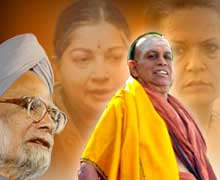 Why was the
Shankaracharya humiliated in this manner, and why didn’t the
Centre intervene to tell the Tamil-Nadu government to adhere to
Supreme-Court guidelines in the arrest and incarceration of
religious leaders? Both prime-minister Manmohan Singh and
Congress president Sonia Gandhi have separately and differently
washed their hands off the matter, but it won’t, frankly,
wash. Why was the
Shankaracharya humiliated in this manner, and why didn’t the
Centre intervene to tell the Tamil-Nadu government to adhere to
Supreme-Court guidelines in the arrest and incarceration of
religious leaders? Both prime-minister Manmohan Singh and
Congress president Sonia Gandhi have separately and differently
washed their hands off the matter, but it won’t, frankly,
wash.
The
PM said the Centre was not in the picture, and anyway, it was of
no concern to it. Only a non-politician, who has no
understanding of the ethos of this country, and its deep wedding
to faith, would make such a statement,...Nor
can Sonia distance the Congress from the episode, because the
Shankaracharya was arrested in Congress-ruled Andhra Pradesh.
“If the Andhra chief minister had insisted on the
Supreme-Court guidelines being followed,” said a Congress
stalwart, “the Tamil-Nadu government would have been stopped
in its tracks. Starting from the Brahmin and Kshatriya leadership across all political
parties, there is a deep sense of hurt and dismay. To this
writer’s knowledge, several upper-caste Congress leaders are
aghast at Jayalalithaa’s humiliation of the Shankaracharya to
square off M.Karunanidhi and win the non-Brahmin votes in Tamil
Nadu. But
they are unable to break out of the “secular” gridlock of
the Congress and speak their mind.(source:
The
humiliating arrest of the Kanchi seer is testing Hindu patience
- indiareacts.com).
Please refer to Kanchi
Conspiracy by Christians? - saag.org.
Where
is the US Council on International Religious Freedom?
Where
is the international response to the arrest of the Kanchi
Acharya? The USCIRF did
not stir a little finger. This merely supports the contention
that it is not meant for religious freedom per se, but for the
advancement of Christian fundamentalism. The BBC
called the Acharya a 'cleric'. Strictly speaking, this is true:
a cleric is a member of a religious order. But I have never
heard them call the Pope a cleric. It is always 'the pontiff' or
'the pope'. Why? I suggest that we should all call the Pope a
'cleric' from now on....
(source: Where
is the US Council on International Religious Freedom?
- By Rajeev Srinivasan).
The
silence of the Western media over the arrest like Sherlock
Holmes' dog that did not bark is eloquent ?
Shankaracharya
hit the Conversion
industry where it most hurt. He aimed at building a temple in
every Dalit village and in giving personal darshan in each
village. His Chandrasekharendra Maha Vishwavidyalaya, a Deemed
University, controls several educational and medical
institutions, which serve the villages and challenge missionary
monopoly in these sectors.
In
Tamil Nadu, the cognoscenti feel American evangelists planned
the whole sordid affair. Certainly the silence of the Western
media over the arrest like Sherlock Holmes' dog that did not
bark is eloquent. The American organization that monitors
freedom of religion abroad was upset with the anti-conversion
law and was dialoguing with the State government to undo it.
That President Bush
(Evangelicals are crediting God with securing
re-election victory for George W. Bush.) supports vigorous evangelism is no secret.
His disrespect for Hindu dharma
was on public display immediately after his re-election, when he
hosted an Iftaar and Diwali dinner at the White House
simultaneously, and attended only the former. The pathetic
excuse peddled by his staff was an insult to the worldwide Hindu
community and must be perceived as such by Hindus, regardless of
ideological predilections.
(source:
Justice
must be seen to be done - By
Sandhya Jain - dailypioneer.com
- Edit page - November 29 2004). For more refer to chapter on Conversion).
Refer to Their
Other "Dirty" Linen: Evangelism's Quest to Conquer the
World
- By S R Welch - secularweb.org and Evangelicals
for Bush
- By
Steven Waldman - nytimes.com).
This
could happen only to a Hindu religious leader
Politically,
this could happen only to a Hindu religious leader. It is
unthinkable that an Imam could ever be arrested in this country,
and never on Ramzan Day. An Archbishop could never be arrested
on Christmas Day.
But
a Shankaracharya could be arrested on Deepavali Day. This sums
up the content of secularism in India.
Someone said on television the other day, "There were no
disturbances following the arrest".
Does this not imply that it is a disqualification for the
Acharya that he has peaceful followers? Is the model for
religious leadership that of Shahi Imam who dared the Government
to arrest him and face the consequences?
(source: This
could happen only to a Hindu religious leader - By S
Gurumurthy - indianinfo.com).
George
Fernandes
who visited the Seer said, "All
kinds of human rights had been violated with the
Shankaracharya’s arrest.
The way the pontiff was arrested and treated defies all
norms. There has to be some decency and the arrest should be
according to law."
He told reporters: "There
is human rights violation in many ways. The Supreme Court has
given a decision as to how to deal with such persons. Apart from
the Supreme Court decision and his own status as a religious
head, the way he has been arrested defied every norm of
investigation."
(source:
Seer’s
arrest defies all norms: Fernandes - sify.com).
For more refer to rightliving.net.
'Seer
told us he was mentally tortured by police'
Kanchi
Seer Jayendra Saraswathi, has complained of "mental and
psychological torture" while in police custody and has
denied making any confessional statement.
"Though I was not physically tortured, I was mentally and
psychologically tortured during my police custody. The police
officials induced me to speak over mobile to several persons,
which I declined with folded hands," he was quoted as
saying by a five member delegation of NDA MPs, which called on
him at the Vellore Central Prison this afternoon.
They described reports that he made a confessional statement to
the police as a
"total lie."
Punj
said
that the police had unleashed a "reign of terror" in
Kancheepuram and people were afraid of speaking even in a closed
room. He charged the police with raking up many cases to create
evidence against the Seer in at least one case. "In
the Sankara Mutt at Kancheepuram and in that town, people are
terrified, and unable to speak as there is an atmosphere of
fear,"
Mutt officials were tortured by police, adding that under the
present circumstances, no fair trial was possible in Tamil Nadu.
The cases against the Seer should be transferred to some other
State.
(source: 'Seer
told us he was mentally tortured by police' - indiainfo.com).
Hinduism
in Danger: The Humiliation of Kanchi Acharya
"Why
on earth would the Sankaracharya order the murder of an
accountant? That seems to completely defy logic. The
Sankaracharyas live totally spartan lives and have no need for
money. Besides, even assuming somebody in the Kanchi Matham
wanted to sweep things under the carpet, it would have been so
much easier to just bribe somebody, rather than go out and
murder someone, especially murdering them in a temple and
desecrating the place.
The
sentiments of millions of Hindus do not matter to the Congress,
just as the sentiments of Sikhs didn't when they went on a
murderous rampage in 1984, nor when they appointed alleged
gang-leader Jagdish Tytler as a minister. And
where is the principal 'Hindu nationalist' party who should
speak up? In complete disarray. The Congress is once again
demonstrating that they are a party only for Muslims and
Christians. The foolish Hindus who voted for them deserve what
they get, I suppose. "
(source:
Hinduism
in Danger: The Humiliation of Kanchi Acharya
-
By Rajeev Srinivasan).
The
episode itself, with the unceremonious arrest of the venerable
religious leader on an auspicious day, after a yagna,
by commandos,
was a rude jolt.
The
midnight arrest of Shankaracharya is against all norms of civilized
conduct leave alone the code prescribed by the Supreme
court for taking into custody any alleged suspect.
The decorum and courtesy of civil behaviour that ought to
be shown to respected religious head of one of the
most venerated religious monastic institution of the hoary
Bharat was not shown.
(source:
H
H Sri Jayendra Saraswathi – A Victim of Gutter Politics of
Tamil Nadu – By Laura Kelly).
Denying
Fundamental rights?
Mr Jethmalani observed that
preventing the Kanchi seer from speaking to his lawyers after
his arrest amounted to denying him his fundamental right. Noted
Supreme Court lawyer and a former law minister Ram Jethmalani's
arguments before Justice R. Balasubramaniam on Saturday failed
to move the Madras High Court to even grant the Hindu religious
leader house arrest or permission to be kept in hospital. A
hurriedly convened meeting of the Bharatiya Janata Party's state
core committee here on late Saturday demanded that public
prosecutor K. Doraisamy be removed from his job for describing
the pontiff in court "as a criminal" and
"subjecting him to needless humiliations". Jethmalani
had argued that the detention of the seer in jail for 24 hours
was "like a death sentence".
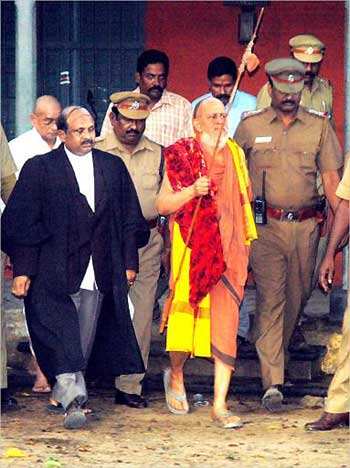
Politically
motivated arrest - Denying Fundamental rights
"The
manner of this arrest is like arresting the Pope during
Christmas mass at the Vatican."
Refer to The
Criminal History of Papacy and Sex,
lies and videotape: turmoil at the
Vatican
and
Vatican
forced to acknowledge debauched behaviour of priests and nuns
and Victims
of pedophile Christian priests and
Pedophiles
and Priests: Anatomy of a Contemporary Crisis - By Philip
Jenkins.
"The
Shankaracharya was arrested in a Congress-ruled state on Diwali
day. The Finance Ministry froze 142 bank accounts of the Mutt
and not a single Congress leader from Sonia Gandhi down to their
district level president uttered a word against the arrest. He
was put in a jail with other criminals. It was pointed out to
the government that when political leaders like Sheikh Abdullah,
Jaiprakash Narayan and Morarjee Desai were arrested, they were
not lodged in jail."
'The
circumstantial evidence pointed quite clearly towards the
Christian lobby that was working against him. The Shankaracharya
had been going to Dalit enclaves and consecrating their temples
and thereby restricting the influence of the Christians who had
looked upon the Dalits as being a fertile ground for conversion.
Obviously, all this had the blessings of Sonia Gandhi who is a
nominee for the Christian lobby."
Refer to ‘Aryan
invasion theory is British-created falsehood’ -
interview with Subramanian Swamy. His latest book
titled 'Hindus Under Seige'
Refer
to The
Media Reality -
haindavakeralam.org.
***
"The
accused was not informed about the arrest. Police whisked him
away and local counsel was not allowed to meet him (Friday). The
arrest was made in an objectionable manner in another state. He
was arrested at 10 p.m. on Thursday, remanded to judicial
custody at 6 a.m. on Friday and taken to Vellore jail. The
procedures prescribed under law had been deliberately violated
and the same was tainted and mala fide," Jethmalani had
said.
After
Saturday's scuffle before the High Court, the courts here fear
that they will be the targets of agitating supporters of the
Shankaracharya whose arrest has drawn the
ire of Hindu groups and evoked protests from political leaders,
including those like former prime minister Atal Bihari Vajpayee.
Arrest
politically vindictive, says seer's counsel
Dismissing as "baseless" the charges
against Kanchi Shankaracharya Jayendra Saraswathi, arrested on
Thursday in connection with a murder, his counsel on Friday
alleged that the action was "politically
vindictive". "The math is no way connected with
the incident (murder). The charges are baseless and based on the
confession by third party. We will seek redressal in law,"
advocate Y Thiyagarajan told reporters soon after the Acharya
was remanded to 15 days judicial custody by a magistrate in
Chennai on Friday.
Janata
Party president Dr Subramaniam
Swamy today said the step was a
reckless infringement of his personal liberty. "Therefore,
if later the Sankaracharya is acquitted by court, then this
arrest will not only be a reckless infringement of his personal
liberty, but also an unforgivable affront to the Hindu
community", he said. He
also condemned DMK president M
Karunanidhi for expressing
"glee" in the episode. Condemning
Karunanidhi for his statement, Swamy sought to know whether the
DMK chief would also support the extradition and arrest of LTTE
supremo V Prabhakaran, "held guilty by the Supreme
Court" in the Rajiv Gandhi assassination case.
Sonia
Gandhi blamed for Shankaracharya's arrest
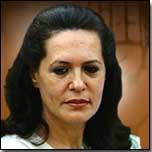 The Vishwa Hindu Parishad (VHP) leader Ashok Singhal
has held Congress president Sonia Gandhi responsible for the
arrest of Shankaracharya Jayendra Saraswathi of Kanchipuram.
"It is quite apparent that the Shankaracharya has been
framed in a criminal case. The
fact that he was arrested from Congress-ruled Andhra Pradesh
further exposes the political motivation behind it,"
Singhal said in Ayodhya on Friday night.
"We
are not going to tolerate this action, which is evidently
motivated by none other than Sonia Gandhi who is presently the
de facto super prime minister of the country," he said. The Vishwa Hindu Parishad (VHP) leader Ashok Singhal
has held Congress president Sonia Gandhi responsible for the
arrest of Shankaracharya Jayendra Saraswathi of Kanchipuram.
"It is quite apparent that the Shankaracharya has been
framed in a criminal case. The
fact that he was arrested from Congress-ruled Andhra Pradesh
further exposes the political motivation behind it,"
Singhal said in Ayodhya on Friday night.
"We
are not going to tolerate this action, which is evidently
motivated by none other than Sonia Gandhi who is presently the
de facto super prime minister of the country," he said.
Drawing
a comparison between the status of Shankaracharya and the Pope,
Singhal accused Gandhi of attempting to "Christianise"
Indian society and the Left of spreading an "anti-Hindu
agenda" through the Congress chief. (Refer
to Congress
leadership cleared seer’s arrest).
Indian
English Language Media waging a sophisticated battle against
Hindus?
A sophisticated battle to demean the
Acharya
(The Times of India under Of High
Priests and their Lust for Power - timesofindia.indiatimes.c...923547.cms)
and support this arrest began, as soon as the arrest
happened - it seems very pre-planned and the din of this
victimization through the media will only increase over the next
few days.
The Real
Shankaracharya
While
the mainstream media sensationalizes the latest newsmaker, often
indulging in misrepresentation,
let us try to examine the Shankaracharya in the eyes of millions
of his followers. The
Shankaracharya is a sanyasi.
Sanyas, as all history books will tell you, is the last stage
prescribed by the Hindu way of life. The current Shankaracharya,
however, like others in his monastic lineage, did not live the
other stages before dedicating his life to asceticism. He was
divined by the previous Shankaracharya as the successor to the
title, at whose behest he was given away to the Math by his
father.
As
a 19-year-old boy, he stood in hip-deep waters and embraced
asceticism, pledging detachment from every material pursuit.
Ever since, he has eaten minimally for subsistence, not slept on
a comfortable bed and not indulged in any sensual pleasure. He
has no next of kin; he severed ties even with his parents. Austerity
in the absolute sense. For more than 50 years, he has
lived such a life in complete public view. He
is a scholar of wide attainments and great versatility who has
mastered the Rig Veda, the Dharma shastras, the Upanishads under
all the Veda Shakas, Vyakarana,
Vedanta, Nyaya and Tarka
shastras through the course of his life.
(source: The
Real Shankaracharya - By Shoba Vasudevan - rediff.com).
Travesty
of Justice
The law usually considers an accused
"innocent until proven guilty". However, in the case
of Hindus -- and Hindus alone -- in India, it appears that the
accused is "guilty until proven innocent". This is
what has happened in the case of the Kanchi Acharya. In the case
of others, it is "innocent even after proven guilty".
This merely proves that if you are a non-Hindu, you are always
innocent by definition.
(source: Media
waging a sophisticated battle against Hindus - saag.org
and The
presumption of guilt - saag.org).
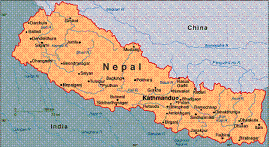
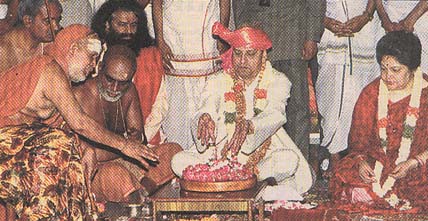
Nepal
king Gyanendra Bir Bikram Shah and queen Komal Rajya Lakshmi
performing 'guru pada puja' (a ritual worship of the preceptor)
under the guidance of the Shankaracharya of Kanchi peeth, Sri
Jayendra Saraswathi, at Kamakshi temple in New Delhi.
(For
more refer to chapter on Greater
India: Suvarnabhumi and
Sacred
Angkor).
***
Nepal's religious leaders from the Hindu
community were unanimous in saying that a man like the
Shankaracharya could not have committed the crime and urged
India to accord him the respect during investigation that his
stature demanded Prakash Sharan Mahat, Nepal's minister of state
for foreign affairs.
Nepal
greet Shankaracharya’s arrest with disbelief
Kathmandu: Nepal's prominent Hindu leaders
expressed shock and amazement at the arrest of a top Hindu
religious leader in India, saying religion should not be mixed
with politics.
"We say religion should guide all
aspects of life, from politics to business," he said.
"But in this case, it is politics that is guiding
religion."
"We can't believe that a man of his stature would do such a
thing," said retired army general, Bharat Keshar Simha,
president of Nepal's World Hindu Federation (WHF), a Hindu group
with close ties to India and elsewhere. Nepal
is the only Hindu country in the world and its king is regarded
as the sovereign of Hindus all over the world.
The arrested Shankaracharya came to Kathmandu in 1988 to attend
the Second World Hindu Conference. He has paid several visits to
Nepal and is revered by its royal family. "We
can't believe that a man of his stature can even contemplate
(murder)," said Basanta Chaudhury, head of the
Pashupatinath Area Development Trust, the Kathmandu-based
organisation entrusted with the upkeep of the shrine.
Nepal's religious
leaders from the Hindu community were unanimous in saying that a
man like the Shankaracharya could not have committed the crime
and urged India to accord him the respect during investigation
that his stature demanded Prakash Sharan Mahat, Nepal's minister
of state for foreign affairs. “The
Shankaracharya is a towering personality and commands Nepal's
respect. But the law must be allowed to take its
course.” Leading Nepalese industrialist Rajendra Khetan, who
heads the Nepal Britain Chamber of Commerce, said the business
and industrial lobby in Nepal was concerned about the arrest and
is likely to petition the Indian government.
Calling his arrest as a conspiracy hatched by
"Christian" Sonia Gandhi, leader of the ruling
Congress party in India, Indian communist parties and the Pope,
the Hindu
Jagran Manch, Nepal said
a man of the Shankaracharya's stature should be treated with the
deference he is entitled to until proved guilty.
(source:
Nepal
greet Shankaracharya’s arrest with disbelief -
newindpress.com and Hindu
organisations in Nepal pray for Shankaracharya's release).
Muslim
clerics rise to seer's defence, want him freed
Condemning
the arrest of Hindu pontiff Shankaracharya Jayendra Saraswathi,
various Muslim clerics on Monday came out in his support,
demanding his immediate release and dropping of all charges
against him. In their statement, Muslim
leaders said putting a "senior religious leader" of
this stature with other criminals in jail was "highly
deplorable".
They referred to reports that he was not being provided his
traditional food. "His age (70) factor has not been taken
into account. Such treatment is not even given to hardened
criminals. The Shankaracharya is a
global leader," the statement said. They joined in
demanding the immediate release and withdrawal of all cases
against the pontiff.
(source:
Muslim
clerics rise to seer's defence, want him freed - newindpress.com).
Why Shankaracharya's arrest was in bad
taste
I support
the basic principle that everyone is equal before the law. But
why is there one treatment for a Laloo Prasad Yadav and another
for a Jayendra Saraswati? I hope the courts sort out the mess as
quickly as possible, not just the murder of Sankararaman but
also the original charges raised by the victim about criminal
misuse of the Kanchi Kamakoti Peetham's funds. But
given the way in which the prime minister, the Union home
minister, and the chief minister of Andhra Pradesh rushed to
excuse themselves, it seems those three worthies at least have
no great confidence in the case against Jayendra Saraswati!
(source:
Why
Shankaracharya's arrest was in bad taste - By T V R Shenoy
- rediff.com).
'Kanchi
seer's arrest has shaken Hindu psyche'
New age guru
Sri Sri Ravi Shankar
on
Saturday said that the arrest of Kanchi Shankaracharya in a
murder case has "shaken Hindu psyche" and appealed to
the people not to turn it into a communal issue.
"His
holiness has appealed to the people to keep calm and not to make
the present crisis that Hinduism is going through into a
communal issue. He said the news of the Kanchi seer's arrest on
Diwali day has shaken the Hindu psyche", the guru's Art of
Living foundation said in a statement from Rishikesh in
Uttaranchal. "Saints cannot even
think of committing such a crime. At a time when such an
accusation has been made, all that one can say is that saints
should keep a watch on people around them", the
statement quoted the spiritual teacher as saying.
A
blot on Indian Culture and Civilization
Kanchi
Seer's arrest sparks nationwide protests
Terming the seer's arrest as "a
blot" on the great Indian culture and civilization.
"India
is a religious country. Injustice and humiliation to religious
gurus cannot be tolerated. We have the tradition of holding them
in the highest possible esteem," Atal
Behari Vajpayee said amidst thunderous applause from
a 10,000-strong crowd at Parliament Street.
"Everybody
is pained at the kind of treatment that is being given to the
Shankaracharya. Can't we have a uniform set of yardsticks for
all the religious heads?" Echoing a similar view, Asaram
Bapu said the countrymen would no longer bow
before injustice. "Hindu sahishnu hai, per kayaar aur
moorkh nahi hain. (Hindus are tolerant,
but that doesn't mean they are cowards and fools). History is a
testimony to this fact. We are distressed but we will not let
our distress last too long,"
Sudhanshuji
Maharaj
said: "Even in independent India, the institution of
great religious belief and attachment has come under attack. It
is a humiliation of the Hindu society. In such a situation, one
can't give sermons for peace.
Speaking on the occasion, former Prime
Minister Chandrashekhar said: "Whatever
is happening is bad omen for the country's future. Let us face
this grave situation jointly. One should not forget that any
move to damage the country's tradition ultimately leads to the
nation's disintegration. The arrest of the Shankaracharya should
be seen in this context."
Recalling his meeting with the Shankaracharya, former Defence
Minister George Fernandes said: "I have no words
to describe the kind of mental agony he is passing through. He
feels the Government finished in one hour what he got in 50
years. I was not allowed to talk to him much by the police and
jail officials. We will, however, ensure the truth comes out.
For this, we will go even for a movement."
Joining the fast,
former President R Vekatraman
said: "The Shankaracharya of the
Kanchi Mutt represents the most ancient tradition of India. A
lot of social work is done by the Shankaracharya to help the
needy from all religions. Shankaracharya Jayendra Saraswati
preached and practiced religious co-existence. His arrest has
agitated the people across the globe."
Numb stupefaction gives way to anger
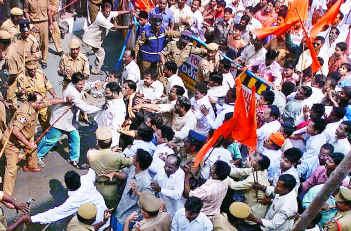 The arrest of Kanchi seer Jayendra Saraswathi in a
murder case today sparked widespread protests across the country
with saffron outfit VHP vowing to avenge the step terming it as
a grave attack on Hindus. Enraged over Pontiff's arrest, several
Hindu organisations staged sit-ins and day-long fasts, held
protest marches and blocked traffic prompting police to use
force to scatter protesters in Andhar Pradesh. In the national
capital, VHP activists staged a demonstration vowing to avenge
seer's arrest and seeking Presidential intervention to secure
his release. The arrest of Kanchi seer Jayendra Saraswathi in a
murder case today sparked widespread protests across the country
with saffron outfit VHP vowing to avenge the step terming it as
a grave attack on Hindus. Enraged over Pontiff's arrest, several
Hindu organisations staged sit-ins and day-long fasts, held
protest marches and blocked traffic prompting police to use
force to scatter protesters in Andhar Pradesh. In the national
capital, VHP activists staged a demonstration vowing to avenge
seer's arrest and seeking Presidential intervention to secure
his release.
Addressing the activists, VHP working president Ashok
Singhal termed the arrest of the greatest spiritual figure in
the world as a "grave an attack on the Hindu
community". He equated the action
with the destruction of Somnath Temple centuries ago and said
"we will avenge this attack."
The Kanchi Shankaracharya, Jayendra
Saraswati, is clearly the victim of a deep conspiracy to
stigmatise not just him but the institution of the Kanchi
Kamakoti Peetham which he heads. Only time will reveal the
extent of the compulsions which led the Tamil Nadu Chief
Minister, Ms J Jayalalithaa, to sanction the vendetta against a
seer who is held in great esteem by millions of Hindus.
Congress
silence screams at a time when the Shankaracharya may be
subjected to third degree methods by the police to extract
"confessions" by a force focussed more on defaming the
seer than in catching the real murderers of Shankaraman.
In characteristic style, the Tamil Nadu Government has attempted
a trial by media.
Refer
to The
Media Reality -
haindavakeralam.org.
Character
assassination
The
way the polity, media and the police is handling Jayendra
Saraswathi and more than him the revered Kanchi Mutt is vicious.
It is no more an investigation. It has turned into persecution.
The assassination complaint against him has descended into
character assassination.
Never in the history of
India has an institution of high reverence been so recklessly
and disrespectfully dealt with. Compare this with
what happened when the Islamic institution of Deoband at Nadwa
revered by millions of Muslims was raided, by the Central and
state police, in the 1990s for harbouring ISI agents, an act
endangering national security. The raid was called off midway,
yes midway, and Narasmha Rao, the then Prime Minister, had to
send two of his senior ministers, one a Hindu and another a
Muslim, to apologise to Ali Mian, the head of the Nadwa
institution. So the law takes `its course' at Kanchi and
`another course' at Nadwa.
(source: Will
the Chief Minister have a look at what is happening? - By S
Gurumurthy - newindpress.com).
‘They
were waiting for an opportunity to punish him’ - Interview
with Senior Supreme Court lawyer M N Krishanmani
Senior
Supreme Court lawyer
Krishanmani,
who represents the current Shankaracharya of Kanchi, Jayendra
Saraswati, in the Sankararaman murder case, believes the seer is
being victimised by people who may not be in agreement with his
unorthodox ways, including his involvement in areas like health
and education. As
far as the case is concerned, I sincerely feel that all the
allegations are foisted on him. He is completely innocent. So
far, there is no material (evidence) to prove his involvement.
There is only one truth in the whole episode, there was some
conflict between Sankararaman and the Kanchi Mutt. That is all.
Everything else in the Shankaracharya matter is totally untrue
-- lies to implicate him in the matter out of vindictiveness.
(source: Secular
duplicity - dailypioneer.com - November 15 2004 and Arrest
politically vindictive, says seer's counsel and
Nepal
greet Shankaracharya’s arrest with disbelief and
Shankaracharya
incident hits headlines in Nepal and
Muslim
clerics rise to seer's defence, want him freed - newindpress.com and Kanchi
Seer's arrest sparks nationwide protests
and Numb
stupefaction gives way to anger and
Kanchi
seer's arrest has shaken Hindu psyche and The
Real Reason For The Arrest
and Shame!
and Seer's
arrest premature, says Swamy
and Seering
slight - dailypioneer.com - Edit Desk - Sunday November 21 2004
and ‘They
were waiting for an opportunity to punish him’ - Interview
with Senior Supreme Court lawyer M N Krishanmani -
rediff.com).
***
Trial
By Media?
Giving
him the benefit of doubt - By Tavleen Singh
 Never
in all my years as a journalist have I seen as shameful a trial
by the media as that of the Sankaracharya of Kanchipuram.
Obsessed as most Indian analysts are with our imaginary war
between 'secularism' and 'communalism' most opinion on the
subject of the Sankaracharya's arrest has been polarised into
one or other of these camps. Never
in all my years as a journalist have I seen as shameful a trial
by the media as that of the Sankaracharya of Kanchipuram.
Obsessed as most Indian analysts are with our imaginary war
between 'secularism' and 'communalism' most opinion on the
subject of the Sankaracharya's arrest has been polarised into
one or other of these camps.
Shoddy
investigation
This
is not about religion and it is not about secularism. It is
about making sure that under our justice system people continue
to be considered innocent till proved guilty.
If
the police can use the media to try, and condemn, someone as
important as the Kanchi Sankaracharya can you imagine what they
could do to an ordinary citizen?
Why
in the middle of the night? Why on Diwali? Nobody
knows.
(source:
Giving
him the benefit of doubt - By Tavleen Singh - cybernoon.com). Refer
to The
Media Reality -
haindavakeralam.org.
Ashamed To Be A
Tamilan -
By Prakash M
Swamy
For
the first time in my life, I am ashamed to be from the state of
Tamil Nadu and a media person having trained and worked in the
city of Madras, now called Chennai. I have always felt that I am
a proud citizen of Tamil Nadu, land of great saints and savants,
freedom fighters and scholars. The state is now going to dogs,
literally.
(source:
Ashamed
To Be A Tamilan - By Prakash M Swamy).
Cry,
my beloved India - By Francois Gautier
 I
am a Westerner and a born
Christian, but even I am ashamed at what is happening in India
since Sonia Gandhi,
a Westerner and Christian, became the de facto ruler of
this ancient and extraordinary country of 850 million Hindus and
125 million Muslims. I
am a Westerner and a born
Christian, but even I am ashamed at what is happening in India
since Sonia Gandhi,
a Westerner and Christian, became the de facto ruler of
this ancient and extraordinary country of 850 million Hindus and
125 million Muslims.
Something terrible is happening
here. On the one hand, you have the Shankaracharya
one of the most respected Hindu leaders, arrested like a
criminal on one of Hinduism's most sacred days, even as
politicians who have more corruption cases against them than
anybody else and others who may even have blood on their hands
are made ministers and strut around with security guards in tow.
The tarnishing of the Kanchi mutt's
image is nearly complete. Will it ever be able to recover its
sanctity, even if the Shankacharya is found not guilty?
On the other hand you see a quack like Benny
Hinn, who has no standing even in the United
States, come openly to India, a country with an overwhelming
Hindu majority, to deride idol worship and paganism and convert
the poor and the gullible. The beauty of it all is that Sonia
Gandhi does not have to say or do anything. She does not have to
instruct the Tamil Nadu police to arrest the Shankaracharya or
tell Chief Minister Dharam Singh of Karnataka to attend Benny
Hinn's show. Just being where she is, at the top of India's
political hierarchy, is enough to ensure that her silent wishes
are fulfilled. Everybody is bending over backwards to please
her, even anticipating her wishes! The Benny Hinn show points to
not only a renewed effort at Christianization
of India -- something which even the British
and the Portuguese
could not do -- and a targeting of Hindu spiritual leaders, but
also the Westernisation of the subcontinent.
(source: Cry,
my beloved India - By Francois
Gautier - rediff.com). http://www.francoisgautier.com/).
A
Neurotic Chief Minister?
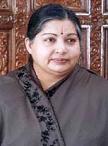 The Kanchi Acharya is confronting not just a
neurotic Chief Minister and a hostile state but also
a section of the judiciary which is, to put it mildly, not
Caesar’s wife. He is also confronting a section of the state
police, specifically, the SP of Kancheepuram who has been damned
by the Madras High Court itself and who has had a non-bailable
warrant issued against him. The Chief Minister of course has
several cases pending against her with regard to acquiring
government property and amassing wealth disproportionate to her
known sources of income. So, which
among these worthies is qualified to judge the Acharya?
The Kanchi Acharya is confronting not just a
neurotic Chief Minister and a hostile state but also
a section of the judiciary which is, to put it mildly, not
Caesar’s wife. He is also confronting a section of the state
police, specifically, the SP of Kancheepuram who has been damned
by the Madras High Court itself and who has had a non-bailable
warrant issued against him. The Chief Minister of course has
several cases pending against her with regard to acquiring
government property and amassing wealth disproportionate to her
known sources of income. So, which
among these worthies is qualified to judge the Acharya?
(source:
Equal
before which law? - vigilonline.com). Also
refer to The
Crucifixion of Jayendra Saraswathi – By Kalyan Sundaram -
sulekha.com.
Silent
Hurt of the Hindus - By S.
Damodaran
Disgusting Double Standards
Millions of Hindus
across the globe watched in disbelief the drama of the Kanchi
Sankaracharya being arrested and sent to jail on alleged murder
charges. However, the media, in India,
has vaxed eloquent on "no one being above the law". But
the reaction of the people at large was one of shocked
disbelief. However, this time around, I
think the media-secularist cartel have gone overboard and have
made some serious miscalculations.
But like most educated Indians, I am
disgusted with the double standards the country is used to
witnessing. From the Nehruvian-Stalinist who masquerade as
secularists to the communist & regional parties who survive
only on caste politics, they have committed innumerable acts to
destroy our collective heritage - the Hindu civilization.
If a politician of
this species is arrested, he /she immediately gets admitted in a
hospital and gets royal treatment. But
it is perfectly legitimate to put a Hindu divine figure,
worshipped by millions, in prison on mere suspicion. That is
their brand of "secularism". It is the considered view
of millions of Indians that if we apply the law on them, their
breed would be extinct in quick time.
In post independence India, Hindu
bashing is a favorite past time for almost every one in public
life - including some Hindus themselves. There are
too many instances to even recount. These pseudosecular
politicians base their moves on the following logic. Hindu
society is extremely selfish. Its innumerable subdivisions only
make it easier to play the old "divide and rule" game.
Secondly, Hindu bashing pays handsome rewards - from vote bank
politics to media coverage and even "international
respectability".
The politicians may have brilliantly schemed a theatrical event
to divide Hindus. But they certainly did not foresee the
response to the arrest. Conspicuously absent, however, were
burning of public transport and closing down of business
establishments. Millions of Hindus all over the world grieved in
silence, praying for the ordeal to end. The arrest rallied
people from all walks of life. Former president R Venkataraman
who broke tradition, former prime Ministers Vajpayee and
Chandrashekar, were seen voicing their protest against the
arrest. People who were not directly associated with the Kanchi
Mutt, former civil servants, students, professionals in every
walk of life, young and old, men and women, high caste and low
castes have expressed their disgust. Never
before have the Hindus risen silently to grieve a violation of
their heritage. Unwittingly, the arrest has catalysed the coming
together of this disparate and often incoherent body.
There is also another miscalculation. A very large portion of
the electorate is young - post 1970 generation. These youngsters
and have grown up being influenced more by economics than
"anti-Brahmin" rhetoric. In hindsight, the arrest of the Seer has made a very
important contribution to redifing Hindu identity. Never before
has the silent hurt of the Hindus found such unified expression.
(source: Silent
Hurt of the Hindus - By S. Damodaran.
The author is a US
based Banker).
Hanged Before Hearing
- By Balbir Punj
Outlook
pronounced him guilty even before the trial!
The report is based on half-truths and rumours. Innuendoes and
baseless allegations levelled by known enemies of the math
and the police have been produced with suitable exaggerations as
part of a 'journalistic investigation'. The magazine has
happily swallowed the Tamil Nadu government's version hook, line
and sinker. Suddenly, the trigger-happy policemen who are devil
incarnates while dealing with isi agents have turned into
paragons of virtue.
The 'secularists' vie with each
other to speak for the 'human rights' of Naxals, terrorists of
various hues and Bangladeshi infiltrators. They quote the fine
print of law to bail them out of tight situations. Here, a
centuries-old, respected institution has been targeted. In the
process, a 70-year-old diabetic seer (who is revered by
millions) has been victimised for political ends. No questions
are being asked. Why? Because all this has the obvious approval
of the 'secularists'. Much to Outlook's disappointment, former
president R. Venkataraman has condemned the treatment meted out
to the seer. A host of religious and political leaders, across
party, caste and ideological lines—including Prime Minister
Manmohan Singh, ex-PM Chandra Shekhar, George Fernandes and
Mulayam Singh Yadav—have expressed their anguish over the
framing of the seer. Millions of Shankaracharya followers are
hurt but they suffer in silence. If the Shahi Imam (against whom
two dozen unexecuted warrants are pending) were arrested, his
followers would have been on the warpath. Is having peaceful
followers a disqualification? This is as presumptuous as saying
the RSS is Brahmin-dominated. The RSS
is less Brahmin-dominated than the IAS, the Marxist JNU, the
'secular' media or the Congress. It's vile to reduce
Hindus to one caste. In fact, many of those working
against Hindu interests with jehadi vehemence—from E.M.S.
Namboodiripad to Nehru—have been Brahmins. But again, to use
Brahmins as a disparaging epithet is to show disrespect towards
India's spiritual and intellectual traditions.
From the disturbing demographic changes
revealed in the last census to the humiliation heaped on the
Shankaracharya, many 'great Hindu ordeals' are in the making.
These can never be salubrious to the health of the
pluralist/secular structure of India.
(source:
Hanged
Before Hearing
- By Balbir Punj - outlookindia.com). Clueless
reporting by Western Press - Religious
Leader's Arrest in Killing Incites Holy Men and Hindu
Nationalists Across India – By Amy Waldman- nytimes.com
- Note: Whatever
happened to word alleged? This word is used by media when
perpetrators are minority for sure. But it is conveniently left
out in this headline).
Will
the `secular' media heed Justice Reddy's warning?
Justice Reddy says that the
"only provocation for the petitioner appears to be the
recent unfortunate happenings in relation to a seer'' of Kanchi
mutt. The judge describes the Matt as
"an ancient, prestigious, glorious and reputed institution
with almost 2500 years' history.'' He says that the petitioner
was `swayed' by the media and ``did not want to lag behind in
the unprecedented process of denigration of the religious
institution.'' That is, the denigrating petition was provoked by
the media.
The judge says further it is "sad
and sorrowful that an institution of such glory that withstood
foreign invasions and social revolutions'' over the past 2500
years "is virtually targeted and persecuted in an organised
manner in an independent country.''
Who are all involved in the process of denigration? Justice
Reddy answers. "Not only individuals, but also a section of
the institutions, such as the State and the Press, appears to be
determined to belittle and besmirch the Peetam.'' Justice Reddy
also says "the role of courts, though indirect, is by no
means insignificant.''
He notes that ``the proponents of human
rights, fair play and dignity to the individuals and
institutions have maintained stoic silence.'' He goes on to say
that ``a
powerful section is celebrating it or watching it with
indifference.'' Justice Reddy says this `perfidy' against the
mutt has `shocked' the country and beyond.
(source: Will
the `secular' media heed Justice Reddy's warning? - By S
Gurumurthy - newindpress.com).
Will
Hindus ever rise?
- By Swapan Dasgupta
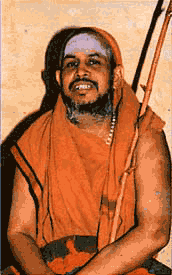 The
Shankaracharya of Kanchi, a powerful symbol of the Sanatan
Dharma,
was arrested on the night of Diwali and charged with murder. He
was produced in court the next day, dubbed an "undeserving
criminal" by the Public Prosecutor and remanded in police
custody. He was allowed no privileges and lodged in an ordinary
jail. When he returned to court three days later, he was mocked
for his aversion to rahukalam and his unwillingness to sign
documents
. As
devotees recoiled in horror, police sources fed a hungry media
with "evidence" of his mendacity. He was
accused of facilitating cash payments to supari killers, of
being in telephonic contact with goons and even of plotting an
escape by helicopter to Nepal. The
Shankaracharya of Kanchi, a powerful symbol of the Sanatan
Dharma,
was arrested on the night of Diwali and charged with murder. He
was produced in court the next day, dubbed an "undeserving
criminal" by the Public Prosecutor and remanded in police
custody. He was allowed no privileges and lodged in an ordinary
jail. When he returned to court three days later, he was mocked
for his aversion to rahukalam and his unwillingness to sign
documents
. As
devotees recoiled in horror, police sources fed a hungry media
with "evidence" of his mendacity. He was
accused of facilitating cash payments to supari killers, of
being in telephonic contact with goons and even of plotting an
escape by helicopter to Nepal.
Regardless
of what happens in the trial, the anti-Hindus have proceeded on
the assumption that there is no worthwhile Hindu sentiment. A
Hindu nation, divided along caste, regional and denominational
lines, it is believed, will stomach any indignity. There
is disquiet that the Shankaracharya was treated shabbily and
there is pain that a premier Hindu institution has been brought
into disrepute. But equally, there is astonishing passivity.
What
we witnessed last week is either a wake-up call to Hindus or
proof that we can be kicked around with impunity. The lessons
are up to us.
(source:
Will
Hindus ever rise?
- By Swapan Dasgupta - dailypioneer.com - Sunday
November 21 2004).
Hindu
sentiments under attack: said Puri Sankaracharya
Nishchalanand Saraswathi
Bhopal: Puri
Sankaracharya Nishchalanand Saraswathi on Tuesday launched a
scathing attack on political parties and the media, alleging
that "battering of Hindu sentiments has become an ideal
principle of the day".
"Is anybody's image totally protected in this country? Is
there one person who is safe from character assassination?"
he asked, speaking on the Sankararaman murder case and the media
coverage on Kanchi seer Jayendra Saraswathi's arrest.
The Puri Sankaracharya, who is on a two-day visit to Bhopal,
said, "For political parties, the
easiest way to remain in power is to attack Hindu sentiments.
Their chief ideology is to batter Hindus and keep occupying the
seat of power. This very attitude is a threat to the nation. A
political party can rule only if the country survives. But who
will rule, if the country does not survive?"
(source: Hindu
sentiments under attack: said Puri seer -
timesofindia.com). Refer
to The
Media Reality -
haindavakeralam.org.
At
last there is a judge with a conscience!
The
Hon’ble Sri Justice L Narasimha Reddy – Writ Petition No.
23220 of 2004
It
is rather sad and sorrowful that an institution of such glory,
that withstood foreign invasions, and social revolutions from
time to time spread over past 25 centuries, is virtually
targeted and persecuted in an organized manner, in an
independent country. Not only individuals but also a section of
institutions, such as, the State and Press, appear to be
determined to be belittle and besmirch the Peetham. The perfidy
caused to it has shocked almost everybody in the society,
cutting across the religions and borders of the country. The
role of the Courts, though indirect, is by no means
insignificant. Proponents of human rights, fair play and dignity
to the individuals and institutions have maintained stoic
silence. A powerful section is either celebrating it or is
watching it, with indifference.
(source:
At
last there is a judge with a conscience! -
saag.org).
Absolutely
no evidence: says Supreme Court
Kanchi
Shankarcharya Jayendra Saraswati is a free man again. Two months
after he was arrested for his alleged involvement in the
Sankararaman murder case, the Supreme
Court on Monday granted him bail while criticising the nature of
evidences around which the entire case was built. The
apex court's decision, coupled with its serious observations
against the approach of the police in the case, is a major
setback to the Jayalalithaa Government.
"There is absolutely no evidence
or material collected so far in the investigation which may
indicate that the Shankaracharya had ever shown any resentment
against the deceased for having made allegations against either
his personal character or the discharge of his duties as
Shankaracharya of the mutt", they said, adding,
"apparently after keeping quiet for three years, it does
not appeal to reason that he decided to have Sankararaman
murdered."
(source: Absolutely
no evidence: says Supreme Court - dailypioneer.com and
saag.com).
Refer to The
Criminal History of Papacy and Sex,
lies and videotape: turmoil at the
Vatican
and
Vatican
forced to acknowledge debauched behaviour of priests and nuns
and Victims
of pedophile Christian priests and
Pedophiles
and Priests: Anatomy of a Contemporary Crisis - By Philip
Jenkins.
Central
Government hoodwinked the nation by denying everything.
Centre
must intervene
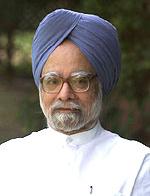 Eighty two crore Hindus had barely heaved a sigh of relief at
the Supreme Court’s order to grant bail to Shankaracharya
Jayendra Saraswati on January 10, when they received another
shock with the news of the arrest of the junior Shankaracharya,
Vijayendra Saraswati, in the same case. Prime
Minister Manmohan Singh’s disclosure about the letter he wrote
to Tamil Nadu Chief Minister J Jayalalithaa on the possible
consequences of Vijayendra Saraswati’s arrest proves that New
Delhi was privy to Chennai’s strategy. Eighty two crore Hindus had barely heaved a sigh of relief at
the Supreme Court’s order to grant bail to Shankaracharya
Jayendra Saraswati on January 10, when they received another
shock with the news of the arrest of the junior Shankaracharya,
Vijayendra Saraswati, in the same case. Prime
Minister Manmohan Singh’s disclosure about the letter he wrote
to Tamil Nadu Chief Minister J Jayalalithaa on the possible
consequences of Vijayendra Saraswati’s arrest proves that New
Delhi was privy to Chennai’s strategy.
But
the Centre hoodwinked the nation by denying everything.
Clearly, the motive behind the arrest
of the junior Shankaracharya soon after the release of the elder
seer on bail, is to paralyse the mutt management, intimidate its
employees and find approvers for the fake police stories. Not
only the 820 million Hindu religionists but also people
belonging to other faiths are disturbed at the highhandedness of
the Tamil Nadu Government. In all likelihood, the people’s
anger may take violent shape, the responsibility for which will
rest squarely with the Tamil Nadu Government and the Centre.
Therefore, we the undersigned, feel that if the Central
Government is not in tune with the State Government, it must at
once intervene and get the junior Shankaracharya released so
that the religious activities of the mutt may continue
unhindered in the absence of the senior Shankaracharya.
Signed
by - Ram Gopal, Maj. Gen VDS Karnik (Retd), DK Mittal, Shridhar
Pant, RK Ohri, KR Phanda, Priyadarsi Dutta, Wing Commander SC
Sahni (Retd), Atul Joshi, Anirban Banerjee
(source: Centre
must intervene - dailypioneer.com
- Letters received on Monday, January 17, 2005).
Top of Page
Petition
and Protests Against the arrest of
Shanakaracharya
Some
Comments from the Petition:
"This
is an offense to the great dignity and authority of the
Shanakaracharya peeths. It means spurning and riding roughshod
over an office that was sanctified and crowned by the most
exalted saints of India and the Vedic Tradition.
""The
manner of this arrest is like arresting the Pope during
Christmas mass at the Vatican." It is only in India one
dare to irritate majority communities. "
By
keeping quiet on a matter of great national interest, the Prime
Minister and the President are bringing disgrace to the position
they are occupying. If the Tamil Nadu CM's personal vendetta
against a person of highest purity and integrity is not nibbed
even at this late hour, it may plunge the country into a
immesasurable catastrophe. Please act now. This is the last
straw on the camel's back. Instead
of upholding Indian culture we are trampling it under the guise
of 'secularism'! Please conduct the trials with the
grace due to the Pope of the Vatican!'
This
is a 9/11 for all Hindus who believe in Sadgurus. This arrogant
behavior of the police only smacks of total corruption shaping
into vengeance by officials
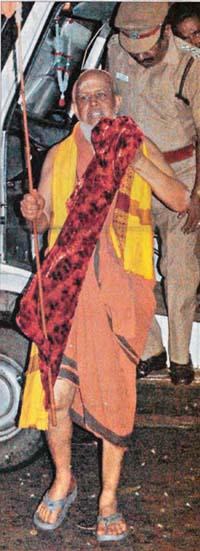 George Barselaar -
"The karmic repercussions of such actions will be the
eventual downfall of the party, and all involved in this
shameful act against a holy personage who stands in the lineage
of Shankaracarya." George Barselaar -
"The karmic repercussions of such actions will be the
eventual downfall of the party, and all involved in this
shameful act against a holy personage who stands in the lineage
of Shankaracarya."
Mark Ciganovic - "As
a Traditionalist Pagan I find the treatment of the Kanchi
Shakaracharya to be reprehensible, this reminds me of the dark
days of Europe in which pagan hierophants were persecuted under
a newly established Christian regime. This should be seen for
what it is, as an attack upon the Vaidika Dharma."
Michael L. Rayborn Jr -
"I am also protesting the arrest of Sri Jayendra Saraswati.
I hail to the Gods and Goddesses of the Northlands, whom are in
my blood and bones. Sri Jayendra has not only the right but the
DUTY to serve the Gods and teachings of his ancestors and I find
it deplorable that he is being arrested by his own government
for fullfilling his most honorable duties and commitment to his
Gods and his Ancestors. Those that have arrested him are
traitors to their own people, placing the teachings and beleifs
of a Semetic god and his teachings before the ones of their
ancestors. Its despicable."
Michelle
(Sadhana) Foster has posted: “The
way crimes are investigated and prosecuted in India is
shocking--as in this case of the arrest of Sri Jayendra
Saraswati Swamiji. The action of arresting him is clearly
politically motivated, and especially shocking since he is a man
of integrity and so much involved in trying to find a peaceful
resolution to the temple/mosque situation in Ayodhya.
Please note that your actions (and
inactions) are being witnessed around the world--I
live in California--and your actions are an embarrassment to the
people and government of India in much the same way that
President George W. Bush is an embarrassment to the American
people. Try the truth for a change; it
is both refreshing and healthy for all involved--especially in
the case of such a holy man.”
"This
is a masked effort to besmirch and denigrate Hindu religious
heads, and that way to demoralize the Hindus, demolish their
self-esteem, make them feel small in their own minds. Thereby
the process of de-hinduizing India would be deemed to have
proceeded a significant step forward. The
manner in which this arrest was done reeks of politics. This is
an internationally planned and executed to undermine the Hindus.
The attack on the Shankaracharya is not the attack on an
individual but is a veiled political attack to degrade the Hindu
society and its tradition. The Kanch Mutt and Seer has always
been working towards the weaker sections of the society. This
has made the religious conversions even harder for the Muslims
and Christians. So, we all
Hindus need to be united. Har Har Mahadev."
"
Let all Hindus realize what the real issue is. Shankaracharya is
only the immediate victim of a well-planned and systematic plot,
which is to make all Hindus feel small, pitiful and despicable
in their own eyes. That way De-Hinduization of Bharatvarsha is
expected to gain some extra momentum. It looks as if North
Indian Hindu common men and women think of this matter as
nothing more than another 'madrasi' caper. Therein lies the
Achilles heel of Hindu believers. They have little or no feeling
of solidarity with their fellow religionists. For this reason
therefore, Hinduism would slowly but surely wither away in India
to be replaced in the not - too- distant future most likely be a
polity at least partly Islamic or Christian."
Dr
Rangesh S Gadasalli: "A super Catholic PM, a
gutless PM and a battle scared President with the help of
antinational Communists, Anti Hindu Dravidian slave parties are
destroying India. Better get things under control before the
Queen of Italy gets help from overseas to take India back to the
year 1946!"
Ravinder
Gupta: " It is a sorry state of affairs when the
criminals become ministers and the most revered Hindu Spiritual
leader is treated like a criminal. There are many criminal cases
against Shahi Imam of Delhi's Jama Masjid but the government has
no guts to arrest him. Perhaps India is the only independent
country in the world where the majority community is treated
like dirt. Govt controls many Hindu temples and diverts the
donations to Mosques, Madrasas and Chuches. This is the height
of unfairness. Oh my country-men, perhaps we are not really
free. We need another independence movement so all citizens can
be treated equally. Jai Bharat."
Dr.
Satyanarayana Gavarasana: "Arrest of Sri Jayendra
Saraswati Swamiji is an insult to the
Hindus all over the world. He is a source of
spiritual solace to the multitude and his contribution to the
growth of Hindu charity knows no bounds and I wonder how he can
be treated as an ordinary individual and branded unjustly as a
"criminal." No one can be called a criminal till a
court renders a judgement. A person is
presumed innocent till proven guilty. How, then, the Public
Prosecutor can characterise Swamiji as a criminal? If foisting a
case in a court makes one a criminal, then how come a large
number of Central Ministers, who are accused of crime, remain as
honourable ministers?"
"The
arrest and humiliation of a widely respected seer is
reprehensible. He is not above the law of the land. But he, by
the respect he has in the society and by the position he
occupies as a religious head, sure deserves better treatment
This is an outrage against Hindus, regardless of the innocence
or guilt of Swamiji. "When
Jayalalitha was arrested in broad daylight and Karunanidhi was
arrested, the media called them an assault on Fundamental
rights. They were accomplished politicians cum
criminals. The media kept quiet now.
The media is hand in glove with criminals in framing the
innocent and the powerless."
If
"no one is above the law" argument is used, then why
have Laloo Prasad Yadav and Imam Bukhari not been arrested so
far. Clearly in our "secular" India, some are more
equal than others. "
Its
a big shame on Indians, have we lost all our human values. I
feel ashamed for what Tamil Nadu Government and police are
doing."
(source:
http://www.petitiononline.com/mod_perl/signed.cgi?dharma1&1
http://www.petitiononline.com/dharma1/petition.html. Note:
Comments are no longer available at the above sites).
Please Sign Petition -
http://www.petitiononline.com/dharma1/petition.html
and rightliving.net
and http://hccanadacom.nationprotect.net).
Letter
to Chief Justice of India: Request to Transfer the
Shankaracharya case out of Tamil Nadu - indiacause.com.
A
TIME TO FIGHT BACK. THE FIGHT IS ON!! - By Kalidasan -
weblog-sulekha.com).
Supreme
Court asks TN police to pinpoint evidence
New Delhi, Jan. 6. (PTI): The Supreme Court, which began hearing
on the Kanchi Sankaracharya's bail plea in the Sankararaman
murder case, today repeatedly asked the Tamil Nadu police to
"pinpoint" the evidence linking the seer to the
offence.
Repeated queries by a Bench headed by
Chief Justice R C Lahoti evoked little response from the counsel
for the Tamil Nadu Government which is opposing the bail.
"We only want to know whether you have a case against the
Sankaracharya and if so, what are the pieces of evidence against
him, apart from the motive arising from the letters written by
the deceased levelling wild allegations against the
pontiff," the Bench asked.
Appearing for Sankaracharya, senior
advocate Fali Nariman sought to drill holes in the prosecution
theory linking the seer to the murder and said even on basic
facts like payment of money to the assailants, the Tamil Nadu
police has been changing its stand.
(source:
Supreme
Court asks TN police to pinpoint evidence and
hindu.com).
Refer
to The
Media Reality -
haindavakeralam.org.
***
Protests
Why was a 71- year old Holy Saint
Shankaracharya (revered by a billion Hindus), sent to a prison
cell on the night of Diwali (Hinduism’s most celebrated and
auspicious festival? Protest outside the
Indian
High Commission in London on Thursday 18th November
2004 13:30 to 16:30 hours.
Protest
in New York about Kanchi atrocity, Nov. 30th. Protest
Demonstration in New York City by Hindus in America Supported by
VHP of America in front of the Indian Consulate, E
63rd St from 12:30 to 2:30 pm on November 30th, Tuesday to
protest the mistreatment and arbitrary imprisonment of Kanchi
Sankaracharya HH Jayendra Saraswati Swami. For more information:
Narain Kataria 718-478-5735, Coordinator/Organizer.
(source: http://www.hinduhumanrights.org/
and http://rajeev2004.blogspot.com.
More Facts about the arrest - http://www.saag.org/BB/view.asp?msgID=9043.
Kanchi
Shankaracharya Arrest Case - Full Coverage - http://www.indiacause.com/Cause/C30_Shankaracharya.htm
Pro-Sankaracharya
demonstration held in New York
Indian-Americans
have demonstrated in front of the Indian
Consulate General seeking the immediate release of
Sankaracharya of the Kanchi Kamakoti peetham. About 150 people,
braving cold weather, raised slogans and held placards. Nearly
30 organizations were represented in the two-hour demonstration
held yesterday afternoon. "No
justice for Hindus in India," "Hindu saints in jails,
criminals in government" and "He should be treated
innocent till proven guilty" were some of the
slogans raised and written on placards. A few leaders such as
Dr. Narinder M. Kukar, former head of the trustees' board of the
Association of Indians in America;
A. V. Raghunath, an individual closely associated with the
Sankaracharya Mutt and based in neighboring Long Island; and Uma
Mysorekar, head of the Ganesh temple in
the Flushing neighborhood of Queens, were among the
speakers. The demonstrators submitted a memorandum to Consul
General P. Rath on the occasion. "The
state government of Tamil Nadu and the central government should
heed carefully the growing discontent and anger of the global
Hindu community," Narain Kataria, main
coordinator of the protest demonstration, said. "This
is not secularism; it is simply anti-Hinduism,"
he charged. The demonstrators also said the law should take its
own course and a "trial by (news)
media should not be held." Organizers claimed up
to 250 people not only from across New York but also from
neighboring states attended the gathering.
(source:
Pro-Sankaracharya
demonstration held in New York - hinduismtoday.com).
Names
of various supporting organizations
The sidewalks of the prestigious
Fifth Avenue near Central Park, right in the heart of New York
City, reverberated with the slogans: “Santon
Ka Apmaan -- Nahin Sahenge, Nahin Sahenge”, “Hindu
Persecution -- No More, No More”, “Enough is Enough”, and
“Release our Shankaracharya -- Right Now, Right Now”.
Alliance of Sindhi Associations- American Institute of Yoga and
Arts, New Jersey. American Telegu Association (ATA) - Arya Samaj
of New York - Bharat Sevashram Sangh of N.A., New Jersey -
Chinmaya Mission -DISHA, N.J.- Divya Dham, Queens, New York
Indian American Friendship Council - Indian American
Intellectuals Forum - International Center for Cultural Studies
(ICCS) - International Federation of Bangladeshi Hindus &
Friends - International Hindi Association, New York -Foundation
for the Advancement of Arts and Sciences from India, Inc. (ARSI)
- Gayatri Samiti, New Jersey -Gujarat Foundation, New Jersey -
Hindu Center of New York - Hindu Garjan -Hindu Sevika Samiti
-Hindu Students Council -Hindu Swayamsevak Sangh -Hindu Temple
Society of North America -HinduUnity.Org. - Kanchi Kamakoti Seva
Foundation -Kerala Hindus of North America -Hindu Interfaith
Council Against Defamation (HICAD) - Mahagauri Balagokulam,
Queens -Malyali Hindu Mandalam - Natraj Cultural Group -
Overseas Friends of BJP -Om Kriya Yog, N.J.- Overseas Sindhu
Sabha -Satya Narayan Mandir -Sikh Sangat of America -Sindhi
Circle -U.P. Association of Mid-Atlantic (UPAMA) - Vishwa Hindi
Samiti -Vishwa Hindu Parishad of America -Yogakshema
America, Inc.
The Protest was attended and
addressed by prominent physicians, college professors, and other
heads of cultural and religious organizations. The atmosphere
was charged and electrifying. The emotional outburst was seen to
be believed. All the present community as well as religious
leaders unequivocally condemned the illegal and shocking
confinement of a Shankaracharya, one of the highest and the most
revered seats of the Hindu Dharma.
(source: Hindu
Unity.org).
Protests
in NY against Kanchi seer's arrest
Expressing
"outrage" over the arrest of Kanchi Sankaracharya
Jayendra Sarswathi, several Hindu
religious and political organisations and the Sikh
Sangat of America held a
demonstration near the Indian
consulate in New York demanding
the seer's release.
"Hindus
believe that the arrest of the Sankaracharya is motivated by a
sinister design to demoralise them in general and to frighten
and terrorise seers into submission," the demonstrators
told reporters on Tuesday during the two-hour protest. The
demonstration was led by Vishwa Hindu
Parishad of America and 'friends
of BJP'. In a memorandum addressed to consul general
Pramathesh Rath, the demonstrators said Hindus in America are
"deeply disturbed and shocked" at the
"disrespectful and legally suspect" manner in which
Jayendra Saraswathi was summarily arrested and remanded to
prison.
Swamiji's
arrest, it said, is symptomatic of a "multi-pronged
attack" soon to spread against potentially all Hindu
leaders espousing the cause of Hindutva. "This is a
sinister attempt to frighten and terrorise other Hindu pontiffs
into submission," it added. The manner in which the Tamil
Nadu police and the public prosecutor have tried to portray the
Sankaracharya as a "professional killer" smacks of
political partisanship. It said.
(source: Protests
in NY against Kanchi seer's arrest - indianexpress.com).
25
organisations in California protest Acharya's imprisonment
More than 25 Bay Area
organizations came together at the Town Hall meeting, an
initiative taken by the Hindu Swayamsevak Sangh (HSS), Sunnyvale
Hindu Temple and the Vishwa Hindu Parishad of America (VHPA) at
the Sunnyvale Hindu Temple
on Sunday (November 21) afternoon to condemn the recent arrest
and the unlawful detention of the respected Shankaracharya of
Kanchi Kamakoti Pitham, His Holiness Sri Jayendra Saraswati
Swamigal.
Representatives from the various supporting religious, social as
well as cultural organizations expressed utter shock and dismay
over the targeted attack on the very edifice of the Hindu
religion. “No historical person has
ever exercised a deeper and a stronger influence on the Indian
thought and spirituality than the Shankaracharya and the recent
developments in India are nothing less than shameful,”
said a visibly upset Deepa Murti, one of the 300 plus people who
attended the meeting.
(source: 25
organisations in California protest Acharya's imprisonment -
orgaiser.org).
HAF
Expresses Distress over the Arrest of the Sankaracharya of
Kanchi
The
Hindu American Foundation - HAF expresses great
distress over the arrest of one of the most widely admired and
respected Hindu spiritual leaders, the Sankaracharya of Kanchi,
Pujya Shri Jayendra Saraswati. The
Sankaracharya has been an inspiration and guide to Hindus
throughout the world. Further, he has led important reforms in
India and within Hinduism, particularly in uplifting socially
and economically depressed communities and in expanding the role
of the Sankara Mutt to encompass education and healthcare across
India. The callous disregard for the Sankaracharya's personal
health, his spiritual duties and his standing among Indians and
Hindus worldwide is shocking and reprehensible. Various reports
that his ill-treatment by local officials was politically
motivated are disturbing.
HAF is distressed by demands from some political leaders that
the state government of Tamil Nadu assume management of the
Kanchi Mutt, similar to its management of most major Hindu
temples in the state. This inequitable treatment of Hindu
institutions, a policy that has never been applied to
institutions of other religions in India, is fundamentally
flawed and in need of reform. The Kanchi Mutt must be allowed to
maintain its autonomy during this crisis and beyond. HAF calls
on the government of the state of Tamil Nadu to ensure a fair
and independent judicial process that treats the Sankaracharya
with the dignity he deserves for his years of selfless service
to all of the people of India. HAF will continue to closely
monitor these events and stands united with organizations
representing numerous spiritual and religious traditions
worldwide that have voiced their collective agony over these
events.
(source: HAF
Expresses Distress over the Arrest of the Sankaracharya of
Kanchi - hinduismtoday.com).
Top of Page
India
is secular because the Hindu is secular.
‘Divided’
Hindu Keeping India together is a matter of pride
The lack of a popular reaction among Hindus
following the Kanchi Sankaracharya’s arrest has made “Hindu
passivity” a fashionable phrase among the commentariat again.
Depending on their ideological proclivity, commentators have
either been wistful or snide about the majority community not
taking to the streets or even conducting agitated conversations
in drawing rooms. Both sides have noted the “fragmentation”
of Hindus along caste and region;
That Hinduism is not a monotheistic religion and
that it is as much cultural, and therefore susceptible to many
near-independent variations, as a religious one, have also been
noted. In fact, while a pan-Hindu reaction informed by
religiosity is rare, Hindu subsets can react strongly to
“attacks” on their specific cultural iconography. But this
“divided” Hindu society should not be a target of hand
wringing or sneering.
Given
this, Hindu-majority India is a wonderful exception. Wonderful
because this is not a rich country. Wonderful because we do not
have the long history of state’s steady advance against
organised religion as in Europe. Wonderful
because this is true despite pandering to organised minority
vested interests that Jawaharlal Nehru started and has been
carried on ever since. And this is possible because Hinduism is
not a proselytising, evangelical, let’s-kill-for-god kind of
religion. It is possible because although most Hindus
are social conservatives, they feel private space is big enough
to practice their religious and cultural rituals. Hindus do not
in general like preaching, they do not in general like being
preached to — and thank god, or rather, thirty three millions
gods (the number of deities said to be in the Hindu pantheon)
for it.
There’s a dogged liberal,
individualistic streak in this religion so full of orthodox
rituals. So, Hindus don’t protest en masse because one of
their religious leaders has been arrested. That may not have
been the case had the shoe been on another denomination. That
makes it even more important that the Hindu is what he is.
India
is secular because the Hindu is secular.
(source:
‘Divided’
Hindu Keeping India together is a matter of pride -
thestatesman.org).
Top of Page
Did Man Reach The Moon Thousands Of
Years Ago? - By John Winston
Indications of the reality of ancient space travel do come
from widely separated parts of the world. Written and oral
tradition is widespread - and, it seems, reliable.
There is a tendency in scientific circles nowadays to regard
ancient documents and even mythology and folklore - as sources
of history. Anthony Roberts expresses it this way: "Legends
are like time-capsules that preserve their contents through ages
of ignorance." In regard to some of the chronicles cited hereafter, internal
evidence will carry its own proofs of authenticity. My first source is an old manuscript described by James
Churchward, the English scholar who wrote decades before people
spoke of artificial satellites and spaceships. (For
more refer to chapter on Glimpses V).
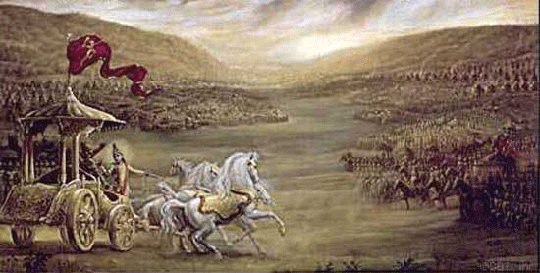
The Mahabharata
describes "two storey sky chariots with many windows,
ejecting red flame, that race up into the sky until they look
like comets . . . to the regions of both the sun and the
stars."
(For
more refer to chapter on Greater
India: Suvarnabhumi and
Sacred
Angkor).
***
1 - India: Vehicles that could revolve around the earth
(i.e., satellites): "Their fuel is drawn from the air in a
very simple and cheap way. The motor is something like a modern
turbine: it works from one chamber to another and does not stop
or stall unless switched off. If nothing happens it continues to
function. The ship in which it is built could revolve as long as
it liked around Earth, only falling when the parts of which it
is made were burnt up.
2 - India: Philosophers and scientists who orbited the earth
"below the moon and above the clouds" are spoken of in
the ancient Surya Siddhanta.
Giant satellites made of shiny metal and turning about an
axis are described in detail in ancient Sanskrit texts, right
down to their dimensions and interiors, as well as smaller craft
that fly between them and the earth.
The Mahabharata
describes "two storey sky chariots with many windows,
ejecting red flame, that race up into the sky until they look
like comets . . . to the regions of both the sun and the
stars."
Other references speak of:
* Pushan sailing in golden ships across the ocean of the sky
* Garuda (a celestial bird) carrying Lord Vishnu in cosmic
journeys
* Aerial flights "through the region of the sky
firmament which is above the region of the winds"
* The Ancients of Space Dimensions.
(source: Did
Man Reach The Moon Thousands Of Years Ago? - By John Winston
-
For more refer to chapter on Vimanas
and War
in Ancient India).
Top of Page
Their
Other "Dirty" Linen: Evangelism's Quest to Conquer the
World
Each year Americans
contribute millions of dollars through corporate-giving
campaigns and Sunday tithes to support the
"faith-based" humanitarian work of overseas Christian
missions. Though most private donors and corporate
sponsors are unaware of it, overseas missions in certain parts
of the world have long been embroiled in scandals involving
allegations of predatory behavior towards the vulnerable.
Their
outrage, vented from halfway across the globe, rarely reaches
English-language media at all.
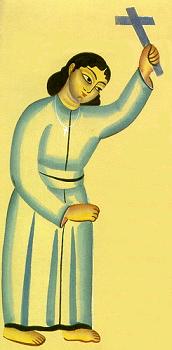 Evangelism
is waged in earnest in a large swath of the underdeveloped world
spanning from North Africa to East Asia. Missionary strategists
call this region the "Unreached
Bloc" or the "Last frontier." In the rural backwaters and isolated tribal hamlets of countries
like India, missionaries routinely peddle the fruits of
generosity--food and medicine--as "inducements" for
conversion to Christianity. When these allurements fail,
more-aggressive means may be employed, not barring fraud and
intimidation. As we shall see below, in India at least,
"harvesting" souls has become an end that justifies
almost any means. Evangelism
is waged in earnest in a large swath of the underdeveloped world
spanning from North Africa to East Asia. Missionary strategists
call this region the "Unreached
Bloc" or the "Last frontier." In the rural backwaters and isolated tribal hamlets of countries
like India, missionaries routinely peddle the fruits of
generosity--food and medicine--as "inducements" for
conversion to Christianity. When these allurements fail,
more-aggressive means may be employed, not barring fraud and
intimidation. As we shall see below, in India at least,
"harvesting" souls has become an end that justifies
almost any means.
This
subordination of humanitarian service to proselytizing is a
matter of theology--evangelical Christians believe they hold a
divine mandate, their "The
Great
Commission" from God, to spread their creed. But
it is also a matter of policy. During his 1998 visit to India,
for example, Pope
John Paul II
bluntly stated that the Christianization of Asia is "an
absolute priority" for the Catholic Church in the new
millennium. He openly
likened the Vatican agenda for that region to its conquest of
the Americas in the sixteenth and seventeenth centuries. His
language, says Sanal Edamaruku, founder of New Delhi-based
Rationalist International, leaves little room for
interpretation, even among secular and progressive-minded Indian
citizens. "It is, in fact, not the fantasy of [Hindu
nationalists]," he states, "but hard reality ... nothing
less than the conversion of ... the Hindus of the world is
targeted."
In
India, considered one of the richest "harvest grounds"
in the Unreached Bloc, the methods employed by missionaries like
Paul have stirred seething bitterness and resentment among the
"heathen" public. Perhaps
no mission tactic galls more bitterly than the intentional
targeting of any society's most vulnerable members--its
children.
Catholic priests had been instructed to learn something of
medicine in order to gain access to the bedsides of sick Hindu
(and Muslim) children. There, on the pretext of administering
medicine, the priests secretly baptized the children before they
died. What is troubling are the reports that this practice continues
today, with formulas of baptism whispered and holy water
sprinkled surreptitiously over non-Christian patients even in
the hospices of such well-known orders as the Missionaries
of Charity.
Both
Rome and its Protestant competitors have been particularly
aggressive in efforts to convert the tribals.
Exploiting customs that make female children economic burdens on
their families, missionaries reportedly induce tribal mothers to
relinquish baby girls shortly after birth. Often the mothers are
promised that rich Westerners will adopt their daughters and
they will live a "much better life." The mother is
typically paid about $70 for her child, which is then adopted by
Western parents for a "donation" of $2,500.
There is an irony to
the notion of tribal "orphans," according to Arvind
Neelakandan, a volunteer with the Vivekananda Kendra (VK), a
Hindu nonprofit that works among the tribals. In most tribal
communities, Neelakandan explains, "Orphans as we know them
are nonexistent"; parentless children are typically cared
for by their extended family. But, he explains, missionaries
will "fleece money from their foreign donors by projecting
these very same children as 'orphans'" in fundraising
campaigns. The practice of allurement,
or providing "inducements" to the poor in return for
their conversion to Christianity, is quite common, and one that
many missionaries readily admit using. It is also nothing new.
In the days of the Portuguese invaders, the Jesuits simply paid
Hindus by the hundreds to participate in mass baptisms. Today's
methods are more subtle.
The
tribal village of New Tupi lies in a deep, forested valley in
the northeastern state of Arunachal Pradesh. It also borders the
district of Nagaland, where a guerilla war between Naga
separatists and the Indian government has ground on for years. A
Protestant missionary started a primary school in New Tupi and
actively evangelized there for a number of years. Response to
his ministry was lukewarm, however, and villagers report that
their pastor was feeling pressure to move on to greener "unreached"
pastures. Failing to uproot the people from their traditional Vaishnavite
faith (a monotheistic branch of Hinduism) apparently became a
prestige issue with him, so as a last resort he played what
could be called his "trump card."
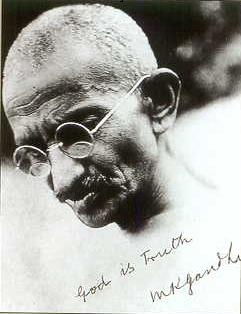 The
pastor of New Tupi began preaching a new sermon. According to
villagers, he told them to "get converted within one and a
half months," or else "everybody will be in
trouble." In his warning he allegedly invoked the name of
the National Socialist Council of Nagaland, or NSCN, the
gun-toting insurgents in nearby Nagaland who, as locals know
well, indulge in kidnapping and extortion. The people of New
Tupi clearly got the pastor's message: Convert to Christianity
now, or terrorists may soon arrive at your doorstep.
Sadly, this is not solely the behavior of a few
renegade clergy. The
pastor of New Tupi began preaching a new sermon. According to
villagers, he told them to "get converted within one and a
half months," or else "everybody will be in
trouble." In his warning he allegedly invoked the name of
the National Socialist Council of Nagaland, or NSCN, the
gun-toting insurgents in nearby Nagaland who, as locals know
well, indulge in kidnapping and extortion. The people of New
Tupi clearly got the pastor's message: Convert to Christianity
now, or terrorists may soon arrive at your doorstep.
Sadly, this is not solely the behavior of a few
renegade clergy.
Displaying
the "neurosis of the
converted," as V.
S. Naipaul terms it, many ex-Hindu converts seek
to demonstrate their faithfulness to their new creed by
affecting open hostility toward the faith they abandoned. This
hostility is usually expressed through contemptuous labeling:
calling Hindus "heathens" and Hinduism
"demonic" or "evil." Too often, contempt
manifests as physical aggression: disrupting Hindu festivals,
harassing recalcitrant family members or neighbors, and
desecrating Hindu temples and relics.
The
notion of conversion as such is alien to Hinduism. Recognizing
this, Mohandas
Gandhi criticized the practice
in no uncertain terms: "I strongly resent these overtures
to utterly ignorant men," he once protested, criticizing
missionaries who, in order to gain converts, "dangle
earthly paradises in front of them [dalits]
and make promises to them which they can never keep."
It
is not widely advertised in the West that Gandhi,
that icon of compassion and self-sacrifice, detested
proselytizing. In his Collected Works, he states categorically
that "the idea of conversion ... is the deadliest poison
which ever sapped the fountain of truth."
If missionaries could not conduct service for its own sake, he
said, if the price of their charity was conversion, he preferred
that they would quit India altogether.
(source: Their
Other "Dirty" Linen: Evangelism's Quest to Conquer the
World
- By S R Welch - secularweb.org).
For more refer to chapter on Conversion
and Missionaries
in India - By Arun Shourie
and Adi
Deo Arya Devata. A Panoramic View of Tribal-Hindu Cultural Interface
- By Sandhya Jain and
Religious
freedom for Bush and for Christian
missionaries
– by Krishna
-
sulekha.com and Crisis
in the Catholic Church - Pope's
Contradictions – By Hans Kung
-
Spiegel.de
and
Harvesting
Our Souls: Missionaries,
their design, their claims - By Arun Shourie).
Top of Page
South
Korea's Ayodhya (Ancient India) connection
 What's South Korea's Ayodhya connection? To get the answer,
pay a visit to the picturesque banks of river Saryu in the holy
city. Here one will find a monument in memory of an Ayodhya
princess who is believed to have 'mothered' a dynasty in South
Korea. What's South Korea's Ayodhya connection? To get the answer,
pay a visit to the picturesque banks of river Saryu in the holy
city. Here one will find a monument in memory of an Ayodhya
princess who is believed to have 'mothered' a dynasty in South
Korea.
It has been an affair that resurfaced after a lapse of almost
2000 years in the year 2001. Mayors of Ayodhya and Kim-Hae city
in South Korea had signed a Sister City Bond in March 2001.
The origin of the historical ties can be traced back to the
middle of the first century AD. According to Sam Kuk Yusa, the
ancient history of Korea, Queen Huh, wife of legendary King Suro,
who founded the Karak Kingdom, was born in Ayodhya.
Queen Huh was a princess of the
kingdom. Her father, the king of Ayodhya, on receiving a divine
revelation, sent her on a long sea voyage to the Karak kingdom
in southern Korea to marry King Suro, states the lines inscribed
on the plaque at the monument in Ayodhya.
 The monument in memory of Hwang Huh is built in Korean tradition
using a three-metre high stone weighing 7,500 kg, specially
shipped from South Korea.
The clan that descended from the Ayodhya princess Huh and
South Korean King Suros, today known as Kim-Hae-Kim clan, has a
little over six million Huh descendants in the Republic of South
Korea.
The monument in memory of Hwang Huh is built in Korean tradition
using a three-metre high stone weighing 7,500 kg, specially
shipped from South Korea.
The clan that descended from the Ayodhya princess Huh and
South Korean King Suros, today known as Kim-Hae-Kim clan, has a
little over six million Huh descendants in the Republic of South
Korea.
The Kim-Hae-Kim clan has countless illustrious members
including many presidents and premiers.
The memorial site in Ayodhya has become a place of pilgrimage
for members of the clan.
While unveiling the monument Bong Ho-Kim, president of the clan
society, Republic of Korea had said: "Ayodhya being
birthplace of our great Queen Huh, has acquired the status of a
place for pilgrimage to over six million descendants."
(source: South
Korea's Ayodhya connection - timesofindia.com).
According to
a history book written in the 11th century in Korean
language, “History of Three Kingdoms”, in the year 48 AD, an
Indian princess by name Hur Hwang-ho (her Korean name), came to
Korea from Ayodhya and married King Kim Suro of the ancient
Korean Kingdom of Kaya which is now the Kimhae city.
Kimhae City is the birthplace of this kingdom and thus has a
historical link with Ayodhya. The clan of Kimhae Kims wants to
perpetuate this memory.
(source: Festivities
organized to honor Indian princess).
In
48 AD, Queen Suro or Princess Heo Hwang-ok is said to have made
a journey from Lord Ram's birthplace to Korea by sea, carrying a
stone which calmed the waters. The stone is not found anywhere
in Korea and is now a part of crucial evidence that the princess
belonged to the city of Ayodhya in India.
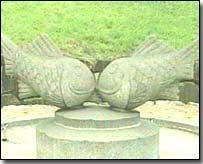 "This stone is
only found in India, proof that it came from there to
Korea," said Song Weon Young, city archeologist of Kimhae,
a city near the big industrial town of Pusan. People of Kimhae
were so fascinated by these links that they started research on
it several years ago. "This stone is
only found in India, proof that it came from there to
Korea," said Song Weon Young, city archeologist of Kimhae,
a city near the big industrial town of Pusan. People of Kimhae
were so fascinated by these links that they started research on
it several years ago.
They also ran into a symbol of the Kaya Kingdon with two fish
kissing each other, similar to that of the Mishra royal family
in Ayodhya. The Princess is said to have given birth to 10 children,
which marked the beginning of the powerful dynasty of Kimhae
Kims. Kim Dae Jung, a former President also belongs to the same
family name.
But even at the centre of these links
lies a strong sense of commercial exchange between Korea and
India.
The stone represents Kaya's cultural
heritage which did not stay in one place, and the stone
indicates that commercial exchange has been on since the Queen
came from India.
Thousands of miles away from Ayodhya, the stone is a small piece
of history. The people in the city seem quite proud of their
links with India, especially because Queen Suro gave rise to the
Kim dynasty, a powerful family name in the country.
(source:
Carved
stones: Historic
India-Korea links discovered
-
ndtv.com).
South
Koreans may have Indian genes
- A genetic discovery in South Korea has claimed that Koreans
could have an Indian ancestor 2000 years ago.
The findings have
gained interests in the backdrop of the popular romantic legend
of an Indian princess married to a Korean king of the Great Gaya
dynasty. According to the legend, the Korean king from Southeast
Korea, Kim Su-ro, married an Indian princess, Heo Hwang-ok, from
the ancient Indian kingdom of Ayodhya.
The stories say that Heo travelled by ship to Korea. The Great
Gaya dynasty ruled Southeast Korea till 562 AD. In fact, Heo is
still a common family name in Korea.
The researchers now say that the myth could turn out to be true,
according to the daily. More studies are in the offing. The
genetic study at Gimhae tomb focused on the mitochondrial DNA in
the human remains.
(source: South
Koreans may have Indian genes - economic
times.indiatimes.com). (For
more refer to chapter on Greater
India: Suvarnabhumi and
Sacred
Angkor).
Top of Page
Ancient
Sanskrit Pictograph near Sedona, Arizona?
Gene
Matlock, author of India
Once Ruled the Americas and who has written books and articles on the possibility of an
ancient Indian presence in the Americas, visited my web site and
was amazed at the resemblance of the pictograph to characters in
ancient Indian Sanskrit literature. He too saw these red
markings as eastern symbols. And in correspondence, Gene points
to a possible Sanskrit origin of this pictograph.
 Although
its exact birth date is controversial, many scholars agree that Sanskrit
may be one of the oldest languages and systems of writing on
earth. Even if we consider the later date attributed to
“classical” Sanskrit (1000 B.C.E.) it becomes apparent that
the dating of Sanskrit or its Indo-Aryan predecessor language could
possibly coincide with the appearance of the Sanskrit look-alike
pictograph at Palatki. If Sanskrit is actually much older, then
the written language may have been established in the world before
the appearance of the pictograph at Palatki. Either way, a
traveler from the Indian subcontinent who may have made his/her
way to Arizona and Palatki, could have had an awareness or
knowledge of Sanskrit or pre-Sanskrit symbols. Native peoples
who established contact with such visitors may then have
acquired knowledge of-or at least familiarity with-Sanskrit
spiritual symbols such as this, the AUM represented at
Palatki. Perhaps they would have included these symbols in
pictographs at a spiritually important site such as Palatki as
they would other powerful symbols. Or perhaps this symbol was
contributed by the ancient visitors themselves. Although
its exact birth date is controversial, many scholars agree that Sanskrit
may be one of the oldest languages and systems of writing on
earth. Even if we consider the later date attributed to
“classical” Sanskrit (1000 B.C.E.) it becomes apparent that
the dating of Sanskrit or its Indo-Aryan predecessor language could
possibly coincide with the appearance of the Sanskrit look-alike
pictograph at Palatki. If Sanskrit is actually much older, then
the written language may have been established in the world before
the appearance of the pictograph at Palatki. Either way, a
traveler from the Indian subcontinent who may have made his/her
way to Arizona and Palatki, could have had an awareness or
knowledge of Sanskrit or pre-Sanskrit symbols. Native peoples
who established contact with such visitors may then have
acquired knowledge of-or at least familiarity with-Sanskrit
spiritual symbols such as this, the AUM represented at
Palatki. Perhaps they would have included these symbols in
pictographs at a spiritually important site such as Palatki as
they would other powerful symbols. Or perhaps this symbol was
contributed by the ancient visitors themselves.
(source: Ancient
Sanskrit Pictograph near Sedona, Arizona? - Lost
Civilization and Hidden mysteries).
Top of Page
Abrahamic
Monopoly over God ?
To
some, God is private property
Christians,
Jews and Muslims claim to "own" God (though
not all members of these religions make this claim). Native
Americans, though, seem not to have this sense of ownership of
God and the earth. Rather, they tend to feel "owned"
by God, even as they "owe" the earth for their
existence. Two widely divergent worldviews.
"People
who think of God as a warrior may become warriors themselves,
whether in a Christian crusade, a Muslim jihad, or an
apocalyptically oriented militia. People who think of
God as righteous are likely to emphasize righteousness
themselves, just as those who think of God as compassionate are
likely to emphasize compassion. People who think God is angry at
the world are likely to be angry at the world themselves."
- says Author Marcus Borg, The
God We Never Knew.
If religion turns some
men into beasts, what have we done to prevent these beasts from
usurping the power of the State to promote their dire
objectives? Very little. For about fifteen hundred years, these
‘beasts’ kept Europe in darkness. Thanks to Christian
dogmatism, it was a felony for a professed Christian to question
the tenets of his faith. The Reformation, the
Renaissance and the Age of Reason finally broke the spell of
religion in Europe. “Thou shalt not
kill,” commands the Old Testament. With what result?
Christians killed the Pagans.
And the Muslims killed the kafirs.
All through history, the most ‘sanctified’ form of murder
has been of those who refused to convert.
“What
has degraded religion to a theatre of cruelty and barbarity,”
says Valson Thampu, an Indian Christan leader, “is the
ownership mentality of the devotees vis-a-vis their respective
gods. Yet the truth is that a God owned exclusively by a segment
of the human species is no God,” he asserts.
In his book, Perennial
philosophy - Aldous
Huxley indeed gives due respect to Hinduism,
Buddhism and Taoism stating clearly that History centric
religions indeed are driven by conquest mentality and hence
potential for violence exists all the time because of “ Market
share “ and conversion mentality.
The Transcendentalists influenced by eastern religions, particularly
Hinduism, they
looked beyond Christianity and the Bible. The
Transcendentalists, as they were called, believed in the direct
experience with the divine in each individual, unity with
nature, and a duty for religious individuals to
provide prophetic witness to the social issues of the day. Ralph
Waldo Emerson articulated these beliefs in his
Harvard Divinity School address in 1839.
(source: http://www.godquest.org/quotes.htm
and To
some, God is private property - By M.S.N. Menon -
organiser.org and http://www.cucw.org/uudev.htm).
A
Profound Arrogance?
Missionary
theology is explicitly based on the assumption of superiority of
Christianity over the religions of the world. Since
Christianity is the only way to salvation, all deviants are cast
into the fires of everlasting hell. The world is
polarized into saved and sinner, free and condemned. Hence the
imperative to convert to save. Even the usually liberal Vatican
Council II has arrogated to itself the authority to assign to
Hinduism a mere ray of truth, reserving for itself the full
truth. Thus the council declares: All must be converted...all
must be incorporated into Him by baptism and into the Church
which is His body.
The
fact is that missionary Christianity
has been so obsessed
with its own truth, it has failed to
recognize even the possibility that others may have their truth.
It has been so engrossed in proclaiming, announcing and sending
that it seems to have permanently lost the compassion and love
to listen and receive. In its profound
arrogance it anointed itself the teacher of humanity and has
steadfastly refused to learn from others. In the more
than 150 years that Hindus have lived in this region, has
Christianity learned anything from Hinduism? Hindus
have been important only as objects of evangelism. Hinduism is
still an "area of darkness" to many.
(source: Christianity
and Hinduism: Domination or Dialogue? - Swami Aksharananda
- peopleunitedforreligiousfreedom.org/
and Crisis
in the Catholic Church - Pope's
Contradictions – By Hans Kung
-
Spiegel.de
.
Clash
of Abrahamic Faiths?
History-Centric religions are
necessarily exclusivist and cannot really accept other religions
as valid. The world is
being drawn toward universal conflict by the competing
History-Centric stories of Christianity and Islam. They cannot
both be right, and their answer is to do their best to destroy
their competitor. The results will become progressively more
catastrophic as time goes on.
Emerson,
Whitman and Thoreau
wanted to replace these History-Centric faiths with
an a-History-Centric belief system that was exemplary rather
than emissary. Doing so on a wide scale is the only hope for a
way out of the clash between the Abrahamic traditions. I am very
surprised to learn that there are ANY who deny history-centrism
in Christianity. It seems patently obvious. There may be some
liberals who advance a non-history-centric interpretation of
Christianity, but even they would have to admit that their's is
an interpretation at odds with that professed by most believing
Christians.' This
raises the following question: Why are liberal Christians in
denial of the History-Centrism of Christianity without which
their system collapses?
(source: Myth
of Hindu Sameness - By Rajiv Malhotra - sulekha.com).
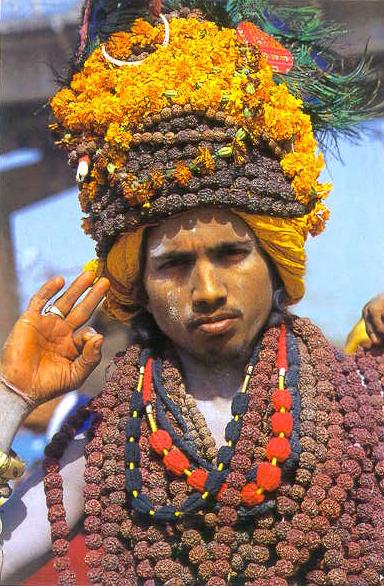
The Transcendentalists influenced by eastern religions, particularly
Hinduism, looked beyond Christianity and the Bible. The
Transcendentalists, as they were called, believed in the direct
experience with the divine in each individual, unity with
nature.
(For
more refer to chapter on Greater
India: Suvarnabhumi and
Sacred
Angkor).
***
How
to deal with Pesky Evangelicals: 'Who's
That Knocking on the Door?
A Buddhist's (and Hindu) Guide to Evangelical Christianity - By Ven.
Shravasti Dhammika from Australia.
We reproduce this extract below via courtesy of
Buddhist Times:
"About six months ago there was a knock on my door and I
opened it to find two evangelicals Christians there. I knew they
were evangelicals because they had that fake friendly smile on
their faces, which all evangelicals have when they are trying to
convert someone.
 This was the third time that month that evangelists had come
knocking on my door and disturbing me so I decided to teach them
a lesson. 'Good morning' they said. 'Good morning' I replied.
'Have you heard about the Lord Jesus Christ'? They asked. 'I
know something about him but I am a Buddhist and I'm not really
interested in knowing more' I said. But like all evangelists,
theytook no notice of my wishes and proceeded to talk about their
beliefs.
This was the third time that month that evangelists had come
knocking on my door and disturbing me so I decided to teach them
a lesson. 'Good morning' they said. 'Good morning' I replied.
'Have you heard about the Lord Jesus Christ'? They asked. 'I
know something about him but I am a Buddhist and I'm not really
interested in knowing more' I said. But like all evangelists,
theytook no notice of my wishes and proceeded to talk about their
beliefs.
So I said, 'I don't think you are qualified to speak to me about
Jesus'. They looked very astonished and asked, 'Why not'?
'Because', I said, 'you have no faith'. 'Our faith in Jesus is
as strong as a rock' they insisted. 'I don't think it is' I said
with a smile. 'Please open your Bible and read the Gospel of
Mark, chapter 16, verse 16, 17 and 18' I said and while they
flicked through their Bibles I went quickly inside and came out
again.
One of them found the passage and I asked him to read it out
loud. It said, 'He who believes and is baptized will be saved
but he who does not believe shall be condemned. And these signs
will follow those who believe in my name. They shall cast out
devils, they shall speak in tongues, they will handle snakes and
if they drink poison it will not hurt them and they will lay
hands on the sick and they will recover'.
When he finished I said, 'In that passage Jesus says that if you
have real faith you will be able to drink poison and not die'. I
took a bottle of Lankem from behind my back, held it up and
said, 'Here is some poison. Demonstrate to me the strength of
your faith and I will listen to anything you have to say about
Jesus'.
Evangelical Christians are often
predicting that the world is going to end very soon and Jesus is
going to come again. When I was 18, I remember very
distinctly that the Jehovah's Witnesses came to our house and
told me that the world was going to end in 1975. If you find any
old Watch Tower or Awake magazines from that period you will see
many articles about the world ending in 1975. Of course they
were wrong, just as they were wrong when they predicted that the
world was going to end in 1895 and again in 1914. In
the 1990's many churches were claiming that the world was going
to end in 2000.
Some naive and impressionable people
were frightened enough to believe this nonsense and converted to
Christianity.
One day I met three young men who told me that they were doing
part time work for a man on the 5th floor. One day as we sat
having lunch together the subject got on to religion and they
told me that their boss believed that the world was going to end
in 2000.
One of them was obviously a little frightened by this
possibility and asked me what I thought about it. 'It is
complete nonsense' I said. 'I don't believe it and I guarantee
that your boss doesn't really believe it either.' 'Oh but he
does' the three boys said. They told me that he had books on the
subject and he had showed them passages in the Bible proving
that the world was going to end in nine years. 'I tell you, your
boss doesn't really believe that', I said. I laughed at him.
'You Christians are so confused and lacking in awareness that
you don't know what you believe' I said. 'You have no right to
doubt the depth of my faith' the man said, now a little annoyed.
I said, 'I can prove that you don't really believe the end of
the world and Jesus' return. 'Prove it then'! I challenged.
'Absolutely'! said the man. 'The Bible
predicts it and I believe it will happen'. 'Okay' I said. 'I
have a friend who is a lawyer. I will ask him to come here
tomorrow and you and I will draw up a proper legally binding
contract in which you will agree to give me all your property -
your house, your business and all your assets - in the year
2001. Do you agree to do that'?
The man was flabbergasted. He didn't know what to say. 'Come
on', I said. 'If you are right, and you insist you are, in 2001
I will be in hell and you will be in heaven with Jesus where you
wont need all your worldly goods'. 'This is just silly' said the
man now very flustered.
(source: A
Buddhist's Guide to Evangelical Christianity - By Ven.
Shravasti Dhammika - saag.org). Refer to Ven.
Dhammika's latest work is entitled '
Who's That Knocking on the Door? A Buddhist's Guide to
Evangelical Christianity and to the chapter on Conversion).
(For
interesting article refer to to Bush's
Conversion Agenda for India: Preparing for the harvest
andReligious
freedom for Bush and for Christian
missionaries
– by Krishna
-
sulekha.com and
Eastward,
evangelical soldiers! By Vijay Prashad - frontline.com and
Their
Other "Dirty" Linen: Evangelism's Quest to Conquer the
World
- By S R Welch - secularweb.org
and
Religious
Conversion – Is it Anti-National? and Crisis
in the Catholic Church - Pope's
Contradictions – By Hans Kung
-
Spiegel.de
and
The
Conversion Agenda - By Rajiv Malhotra).
Top of Page
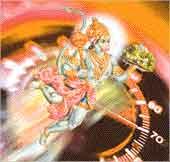 Hanuman
flew at 660 km per hour in the Epic of Ramayana Hanuman
flew at 660 km per hour in the Epic of Ramayana
According
to Berkeley professor Robert
P
Goldman, who is
professor of Sanskrit at the University of California at
Berkeley, said the Sanskrit scholars, who lived between 1200 and
1800 AD, were not "prepared to swallow anything" and
went through the texts carefully. In
a lecture in New Delhi titled aptly, "How fast do
Monkeys Fly? How Long do Demons Sleep?" where he read
commentaries on Sanskrit epic poetry, Goldman said ancient
scholars like Nagoji Bhatta, Govindaraja, Maheshwara Teertha,
Satyateertha and Madhava Yogendra tried to "track down the
narrative" and explain through "scientific
reasoning" the seeming exaggerations in the works.
Reciting
extracts of Sanskrit couplets in a singsong manner from the
works of these scholars, Goldman explained the meanings and the
finer nuances of the language to the audience at India
International Centre.
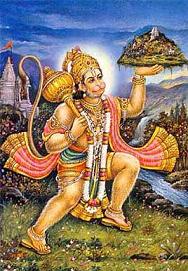 According
to him, the commentators have painstakingly chronicled
day-to-day events of the Battle of Lanka, the 6th book of the
Ramayana. They have done meticulous calculations of the lunar
calendar to explain how many hours could have elapsed between
the slaying of Kumbhakarna to the vanquishing of Meghnad, or
even if the war with Ravana lasted just one night or 'sapta
ratras' (seven nights). According
to him, the commentators have painstakingly chronicled
day-to-day events of the Battle of Lanka, the 6th book of the
Ramayana. They have done meticulous calculations of the lunar
calendar to explain how many hours could have elapsed between
the slaying of Kumbhakarna to the vanquishing of Meghnad, or
even if the war with Ravana lasted just one night or 'sapta
ratras' (seven nights).
One
important question that these scholars raised was how long could
Hanuman have taken to fly to the Himalayas - to the Mahodaya
mountain to fetch the life-giving herb for Lakshmana - from
Lanka, where the battle was raging?
"How
fast do monkeys fly? It was a matter of scholarly reasoning for
the commentators," said Goldman. Some
of them worked it down to a speed of roughly 660 km an hour
considering Hanuman first brought the mountain to Lanka and then
flew back all the way to put it back in its place. "Hanuman
was quite ecologically conscious," said Goldman.
He
said, the Ramayana and Mahabharata are "living texts"
since they are part of the Indian way of life - they are shown
on TV, the "Ramlila" is enacted every year and on
Dussehra, the effigies of Ravana, Kumbhakarna and Meghnad are
burnt.
(source: Hanuman
flew at 660 km per hour - timesofindia.com and How
fast do monkeys fly - in Ramayana?
-
hindustantimes.com.
For more refer to chapter on Vimanas
and War
in Ancient India). For more
on R P Goldman refer to chapter on Quotes341_360).
(For
more refer to chapter on Greater
India: Suvarnabhumi and
Sacred
Angkor).
Top of Page
Arabic Vedic
roots?
Note:
A recent archeological find in Kuwait unearthed a gold-plated
statue of the Hindu deity Ganesh. A Muslim resident of Kuwait
requested historical research material that can help explain the
connection between Hindu civilisation and Arabia.Glancing
through some research material recently, I was pleasantly
surprised to come across a reference to a king Vikramaditya
inscription found in the Kaaba in Mecca proving beyond doubt
that the Arabian Peninsula formed a part of his Indian Empire.
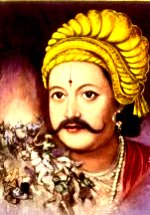 The
text of the crucial Vikramaditya
inscription, found inscribed on
a gold dish hung inside the Kaaba shrine in Mecca, is found
recorded on page 315 of a volume known as 'Sayar-ul-Okul'
treasured in the Makhtab-e-Sultania library in Istanbul, Turkey. The
text of the crucial Vikramaditya
inscription, found inscribed on
a gold dish hung inside the Kaaba shrine in Mecca, is found
recorded on page 315 of a volume known as 'Sayar-ul-Okul'
treasured in the Makhtab-e-Sultania library in Istanbul, Turkey.
Rendered in free English the inscription says:
"Fortunate
are those who were born (and lived) during king Vikram's reign.
He was a noble, generous dutiful ruler, devoted to the welfare
of his subjects. But at that time we Arabs, oblivious of God,
were lost in sensual pleasures. Plotting and torture were
rampant. The darkness of ignorance had enveloped our country.
Like the lamb struggling for her life in the cruel paws of a
wolf we Arabs were caught up in ignorance. The entire country
was enveloped in a darkness so intense as on a new moon night.
But the present dawn and pleasant sunshine of education is the
result of the favour of the noble king Vikramaditya whose
benevolent supervision did not lose sight of us - foreigners as
we were. He spread his sacred religion amongst us and sent
scholars whose brilliance shone like that of the sun from his
country to ours. These scholars and preceptors through whose
benevolence we were once again made cognisant of the presence of
God, introduced to His sacred existence and put on the road of
Truth, had come to our country to preach their religion and
impart education at king Vikramaditya's behest."
For
those who would like to read the Arabic wording I reproduce it
hereunder in Roman script:
"Itrashaphai
Santu Ibikramatul Phahalameen Karimun Yartapheeha Wayosassaru
Bihillahaya Samaini Ela Motakabberen Sihillaha Yuhee Quid min
howa Yapakhara phajjal asari nahone osirom bayjayhalem. Yundan
blabin Kajan blnaya khtoryaha sadunya kanateph netephi bejehalin
Atadari bilamasa- rateen phakef tasabuhu kaunnieja majekaralhada
walador. As hmiman burukankad toluho watastaru hihila
Yakajibaymana balay kulk amarena phaneya jaunabilamary
Bikramatum".
(Page
315 - Sayar-ul-okul).
[Note:
The title 'Saya-ul-okul' signifies memorable words]
A
careful
analysis of the above inscription enables us to draw the
following conclusions:
1. That the ancient Indian empires may have extended up to the
eastern boundaries of Arabia until Vikramaditya and that it was
he who for the first time conquered Arabia. Because the
inscription says that king Vikram who dispelled the darkness of
ignorance from Arabia.
2. That, whatever their earlier faith, King Vikrama's preachers
had succeeded in spreading the Vedic (based on the Vedas, the
Hindu sacred scriptures)) way of life in Arabia.
3. That the knowledge of Indian arts and sciences was imparted
by Indians to the Arabs directly by founding schools, academies
and cultural centres. The belief, therefore, that visiting Arabs
conveyed that knowledge to their own lands through their own
indefatigable efforts and scholarship is unfounded.
(source: Vedic Middle East - http://www.salagram.net/VWHMid-East.html
and http://www.hinduism.co.za/kaabaa.htm.
For
more refer to chapter on India
and Egypt).
Top of Page
Hindu News
Service Launched
November 6, 2004: Sarve
Samachar was formally launched today online at
"source." Sponsored by the Viraat Hindu Sabha, the
site is the first automated Hindu news portal available on the
internet, delivering content from over 30 online newspapers,
news agency and other sources. The site uses technology similar
to Google News to automatically crawl and index fresh content
every 30 minutes. In addition, the site employs a unique metric
based on the popularity and date to highlight only the most
relevant and interesting content. Besides aggregation of news
headlines, the site also collects the latest articles, columns,
editorials from across the web.
(source: Hindu
News Service Launched - hinduismtoday.com).
Top of Page
Toile -
India's design"Les Indiennes" inspired the style
Toile, is the subtly elegant
printing technique that tells stories in engraving-like detail. Pronounced
twal, is an abbreviation of toile de Jouy. The name comes from
Jouy-en-Josas, France, where the first plant to commercially
produce this type of printing was established in 1760.
 In medieval and early
modern France, people [of rank and wealth] wore fabrics such as
silk and velvet that were rarely printed. During the sixteenth
century, Portuguese navigators opened the trade routes to India
and introduced Europe to Indian painted cottons. By the end of
the seventeenth century, the Indiennes
- brightly printed Indian cotton fabrics that were lighter than
velvet, and washable - were famous and widely used for clothing. In medieval and early
modern France, people [of rank and wealth] wore fabrics such as
silk and velvet that were rarely printed. During the sixteenth
century, Portuguese navigators opened the trade routes to India
and introduced Europe to Indian painted cottons. By the end of
the seventeenth century, the Indiennes
- brightly printed Indian cotton fabrics that were lighter than
velvet, and washable - were famous and widely used for clothing.
In 1686 Colbert's
mercantilist and protectionist policies forbade the import of
foreign fabrics, with highly prejudicial results for the French
fabric industry. This embargo lasted for 73 years, but
it was unable to stop the success of the Indiennes.
Although
we think of it as French, toile's founding father was Francis
Nixon of Ireland, who, inspired by printed fabrics from India,
created the first toile fabric in 1752. His techniques quickly
spread to England and then France -- the country that gave the
style its name and assured its place in design history.
The
mother of all toiles is Toile de Jouy -- the brain-child of
Christophe Philippe Oberkampf who established a manufactory for
printed cottons in Jouy-en-Josas (a town near Versailles) in
1760. The idea was to emulate the printed cottons of India while
keeping the process (and profits) at home in France. And
it was an unbridled successIn
1806, the Emperor and Empress, Napoleon and Josephine, one day
surprised Oberkampf with a visit to the factory, nor did
Napoleon fail to ask a thousand questions after his usual
manner. So pleased was the Emperor that he made of Oberkampf a
member of the Legion of Honor, supplying him with the decoration
which he detached from his own coat. Napoleon came again—this
time with the new Empress, Marie Louise.
(source: http://www.w-w-d.com/toile.html
and
http://www.oldandsold.com/articles06/draperies-19.shtml
and http://www.fabricmuseum.org/toiles_intro.html
).
Chintz
The
painted cloths from India were rich in color, and full of
ancient tradition in design. The manner of making them was
intricate, requiring not only talent but infinite patience and
the employment of several arts. And these charming exotics that
were spread before those lovely ladies of Europe in the
Seventeenth and Eighteenth Century, are the ancestors of the
mountains of chintz that fill our shops today.
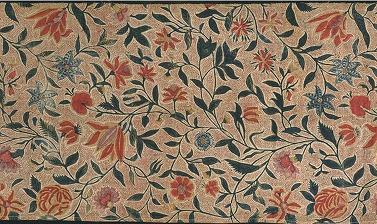 Palampores, or bed covers, they
called the oblongs from India, and at this time the most favored
design for these was the Tree of Life, a straying meander of
slender branches all aflower with blooms of many kinds, the
tree-trunk small and planted in a pyramid of rocks. But its
exquisite tones and shades were impossible to describe, also the
symbolism of the border which reaches back to far antiquity. In
France as in England the first imported cottons from India
arrived in the second half of the Seventeenth Century and
awakened at once the desire for possession in the breast of
every person of wealth or social consequence. The more they
bought, the more the returning ships brought to them. And the
greater the consumption of this artistic novelty, the less was
the demand for French silks and woolens. Palampores, or bed covers, they
called the oblongs from India, and at this time the most favored
design for these was the Tree of Life, a straying meander of
slender branches all aflower with blooms of many kinds, the
tree-trunk small and planted in a pyramid of rocks. But its
exquisite tones and shades were impossible to describe, also the
symbolism of the border which reaches back to far antiquity. In
France as in England the first imported cottons from India
arrived in the second half of the Seventeenth Century and
awakened at once the desire for possession in the breast of
every person of wealth or social consequence. The more they
bought, the more the returning ships brought to them. And the
greater the consumption of this artistic novelty, the less was
the demand for French silks and woolens.
It became therefore the pleasure
and duty of domes-tic print weavers to protest, and of the State
to pass laws of prohibition. Between 1686 and 175o no less than
thirty decrees were issued in France in restraint of the use of
printed cottons. But prohibition fails to exclude. There is a
naughtiness in human nature, a half-humorous rebellion that
makes us snatch at things denied. All the well planned
restrictions of France failed to abolish the use of printed
cottons.
Indian
prints were ever very high in price. All who appreciated could
not afford them. Thus it came that French textile workers set
about making an imitation to sell at low cost. The
origin of chintz is a Hindu word which signified colored or
flowered—chint. In the time of Samuel Pepys it was
so spelled ("bought a chint for my wife"), and only
later was an s added which time changed to z.
(source: http://www.oldandsold.com/articles06/draperies-19.shtml).
Top of Page
Guru-varsham
150: The year of Sree Narayana Guru
(1856 - 1928).
The apostle
of social equality, the Guru had preached 'One caste, one
religion and one God for mankind.' SNDP Yogam is the social arm
of the powerful Ezhava community, who were the first to be
awakened by the teachings of Sree Narayana and to be inspired
into a spirit of mass militancy to eradicate their social
disabilities.
This was partly because the great Guru was born in that
community and partly because the Ezhavas constituted the largest
single community among the downtrodden masses in Kerala.
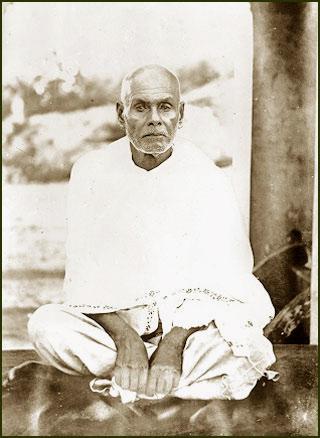 So who was
Sree Narayana Guru? Here's a short introduction to this
personage, the preamble from a brief biography I wrote. The Guru
ought to be much better known than he is. His message, of the
remarkable renaissance and reformation that is possible in
Hinduism, is of great merit at this time when the sanatana
dharma is under withering attack. So who was
Sree Narayana Guru? Here's a short introduction to this
personage, the preamble from a brief biography I wrote. The Guru
ought to be much better known than he is. His message, of the
remarkable renaissance and reformation that is possible in
Hinduism, is of great merit at this time when the sanatana
dharma is under withering attack.
Today, a
bare one hundred years later, it is truly unbelievable that this
was what Kerala -- or to be more precise, the princely states of
Travancore and Cochin -- were like at one time, within living
memory. Today Kerala is a model of egalitarianism, perhaps the
only place in India where overt casteism and discrimination are
completely absent. A mass movement forced the Maharaja of
Travancore to make an epoch-making 'Temple Entry Proclamation'
on November 12, 1936, throwing open all temples to all Hindus.
What had
changed was the mindset of the masses. They realised the evils
of casteism. This metamorphosis required a true revolution. And
this revolution was inspired and catalysed by a most unlikely
revolutionary: a traditional Saivite vedantin, a practicing
ascetic and monk who composed innumerable devotional songs in
Sanskrit, Tamil and Malayalam. That great revolutionary was Sree
Narayana Guru.
When one
talks about the Guru, one is forced to use superlatives, and to
compare him with a galaxy of notables. The greatest Hindu
reformer to come out to Southern India since the incomparable
Adi Sankara. The greatest and most successful champion of the
rights of oppressed Hindus in the twentieth century, more
successful than the much better known Mahatma Gandhi and
Babasaheb Ambedkar.
The one who
overturned the entire social system of Kerala, but without
creating severe animosities and reverse oppression as E V
Ramaswamy Naicker did in Tamil Nadu. The radical reformer whose
clarion call of self reliance and self improvement strikes a
chord in the oppressed anywhere in the world. The man whose
ideals inspired the great Malayalam poet Kumaran Asan's clarion
call:
mattuvin chattangale! allenkil mattum
athukalee ningalethan!
Reform, change the rules!
Else those very
Rules will be your downfall!
The Guru
brought to the oppressed of Kerala the same realisation: that
they were human beings, worthy of respect and consideration.
And the fact that Sree Narayana Guru was able to do this
entirely within the framework of Hinduism is truly remarkable.
One of Hinduism's greatest strengths has always been its
capacity for renewal, renaissance, reform: and in this instance,
the power of the personality of one great saint was enough to
cleanse Kerala's Hinduism of the accumulated dross of centuries.
This has its
own great lesson for India: the ancient civilization of our
nation, the oldest and greatest of all civilisations, perhaps
the only one that has survived more or less intact the attacks
of determined outsiders, is indeed sanatana, eternal.
Whenever the civilisation is under great stress, individuals
arise who, by the power of their personalities, are able to
revitalise society and renew it.
It is
remarkable that Hinduism, alone amongst the world's currently
numerically dominant religions, is susceptible to reform. It can
be reformed, and indeed it may need to be reformed
periodically. It is astonishing that in historical times, every
1,200 years or so, with amazing regularity, Hinduism has indeed
reformed itself. Extrapolating from the past, it is now time for
yet another Golden Age for the sanatana dharma, after
it has been cleansed of a millennium's excrescences.
(source: Guru-varsham
150: The year of Sree Narayana Guru - By Rajeev Srinivasan -
rediff.com). For more
refer to chapter on Caste System).
Top of Page
For
Hindus an alarming growth of minority population
The demographics of politics
When the Muslim vote bank frowns,
politicians get into a frenzy. Reacting with alacrity to Muslim
ire at Census revelations of the community's steep growth rate,
the UPA Government reverted Commissioner JK Banthia to his
parent cadre for not consulting the Union Home Ministry before
releasing data on religious demography. Congress president Sonia
Gandhi jumped into the fray, promising an inquiry into so-called
statistical errors, and the message heard loud and clear across
the country was that there is be no public space for the
legitimate concerns of the Hindu community.
Certainly the "adjusted" figures have a higher
comfort value. They show that instead of the decadal growth rate
of Muslims increasing by 1.5 per cent in 2001, it actually fell
by 3.6 per cent. Yet these figures surely hide the true extent
of India's Muslim population, as both Jammu & Kashmir and
Assam are States with a high Muslim population. Hence, when the
figures for both States are added, we will have to admit having
a much higher total Muslim population in the country, and a
higher percentage of Muslims to the total population. This
reality cannot be evaded.
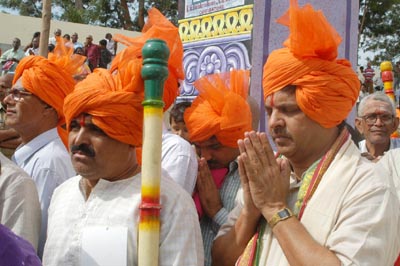 Hindus have long had a latent fear
that the Muslim community will exterminate it from its homeland
through demographic aggression in the form of over-breeding and
illegal immigration. There is a secret dread, articulated by
former Director General of Police, Mr R K Ohri (Long March of
Islam, 2004), that Hindus in India will meet the fate of the
Christians in Lebanon and parts of the Balkans, where sharp
demographic changes over a span of a few decades reduced the
majority community to minority status. The warning is not
without merit. The population of indigenous religious groups in
the country has steadily fallen in percentage terms over the
past 110 years, from 1881 to 1991, and this trend has
accelerated after Partition. The present controversy over
Islamic injunctions against family planning has only added to
Hindu discomfort. Hindus have long had a latent fear
that the Muslim community will exterminate it from its homeland
through demographic aggression in the form of over-breeding and
illegal immigration. There is a secret dread, articulated by
former Director General of Police, Mr R K Ohri (Long March of
Islam, 2004), that Hindus in India will meet the fate of the
Christians in Lebanon and parts of the Balkans, where sharp
demographic changes over a span of a few decades reduced the
majority community to minority status. The warning is not
without merit. The population of indigenous religious groups in
the country has steadily fallen in percentage terms over the
past 110 years, from 1881 to 1991, and this trend has
accelerated after Partition. The present controversy over
Islamic injunctions against family planning has only added to
Hindu discomfort.
The Census 2001 statistics have attracted so much attention
partly on account of the security and economic implications of
illicit immigration from Bangladesh, and partly because the
growth rate of most native religious groups has stagnated or
declined. The Muslim community scored poorly on development
indices such as literacy and employment, and virtually confined
its contribution to the national kitty to demographics. This has
understandably frightened the Hindu majority, especially since
the Minister of State for Home, Mr Sriprakash Jaiswal, went so
far as to demand a ban on release of population figures of
different religious groups. Some politicians even foolishly
asked the rationale behind collecting such figures.
Actually, as Dr JK
Bajaj of the Centre for Policy Research, Chennai, has pointed
out, this is not the first time that the Census has released
data on the relative population of different religious groups.
Right from the first Census of 1871, data regarding religious
demography has been made public and is in fact, the most keenly
awaited census data.
Since independence, Hindus as a community have been declining
in percentage terms. In 1951, Hindus comprised 85 percent of the
population. By 1961 itself they had fallen to 83.4 per cent;
they were 82.7 per cent in 1971 and 80.5 per cent in 2001. In
sharp contrast, the Muslim community stood at 9.7 per cent of
partitioned India's population in 1951, but rose steadily to
10.7 per cent in 1961, 11.2 percent in 1971 and 13.4 per cent in
2001. The missing censuses of Jammu & Kashmir (1991) and
Assam (1981) hardly detract from this trend. The situation is
especially alarming when we look at particular States. In Kerala,
Muslims comprised 17.9 per cent of the population in 1961, but
were a formidable 24.7 per cent by 2001. In Assam, Muslims
comprised 25 per cent of the population in 1961, but were 30.9
per cent in 2001. In West Bengal, Muslims rose from 20 per cent
in 1961 to 25 percent in 2001. In Maharashtra, they marched from
7.6 per cent in 1961 to 10.6 per cent in 2001. These increases
in percentage are unlikely to be reversed in the coming decade.
Conversely, the proportion of Hindus has declined in each state.
(source:
The
demographics of politics - By Sandhya Jain - dailypioneer.com
- September 20 2004).
Top of Page
In
Shiva’s temple, pillars make music
Shiva
is the Destroyer in the Hindu trinity. But here he is Lord
Nellaiyappar, the Protector of Paddy, as the name of the town
itself testifies — nel meaning paddy and veli meaning fence in
Tamil. Prefixed to nelveli is tiru,
which signifies something special — like the exceptional role
of the Lord of Rhythm or the unique musical stone pillars in the
temple.
Temples
often have columns portraying dancing damsels or musicians
playing their instruments, but rarely
do the mute pillars themselves make music. In the
Nellaiyappar temple, gentle taps on the cluster of columns hewn
out of a single piece of rock can produce the keynotes of Indian
classical music.
“You
can hear the saptha swarangal (the seven basic notes) come like
a wave as it were from the stone pieces,” says a senior
priest.
“Hardly
anybody knows the intricacies of how these were constructed to
resonate a certain frequency. The more aesthetically inclined
with some musical knowledge can bring out the rudiments of some
rare ragas from these pillars,” he adds.
The
Nelliyappar temple chronicle, Thirukovil Varalaaru, says the
nadaththai ezhuppum kal thoongal — stone pillars that produce
music — were set in place in the 7th century during the reign
of Pandyan king Nindraseer Nedumaran.
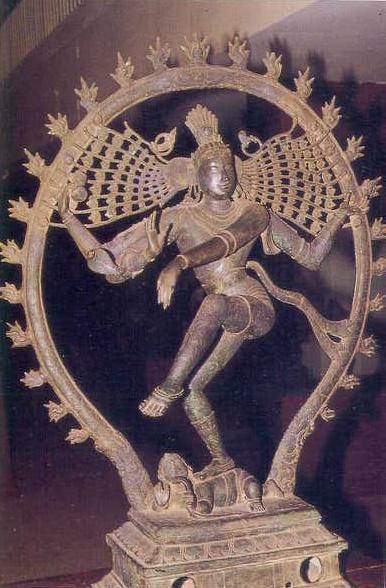
Shiva
is the Destroyer in the Hindu trinity. But here he is Lord
Nellaiyappar, the Protector of Paddy, as the name of the town
itself testifies — nel meaning paddy and veli meaning fence in
Tamil. Prefixed to nelveli is tiru,
which signifies something special — like the exceptional role
of the Lord of Rhythm or the unique musical stone pillars in the
temple.
(For
more refer to chapter on Greater
India: Suvarnabhumi and
Sacred
Angkor).
***
Archaeologists
date the temple before 7th century and say it was built by
successive rulers of the Pandyan dynasty that ruled over the
southern parts of Tamil Nadu from Madurai. Tirunelveli, about
150 km south of Madurai, served as their subsidiary capital. The rulers following Nedumaran made some additions and
modifications, but left the 10 musical stone pillars in front of
the main Shiva shrine untouched. Each
huge musical pillar carved from one piece of rock comprises a
cluster of smaller columns and stands testimony to a unique
understanding of the “physics and mathematics of sound”,
temple authorities said.
In
all, there are 161 such small pillars that make music in the
Nada Mani Mandapam before the main shrine of Lord Nellaiyappar,
the chronicle says.
Two
equally impressive musical pillars adorn the shrine dedicated to
Goddess Gandhimathi Ambal in the temple complex spread over
nearly 14 acres.
To
pilgrims, as awe-inspiring as the deity are the isai thoongal,
meaning musical pillars in Tamil.
In
the South though, several temples boast of such pillars, like
those at Azhavar Thirunagari, Tenkasi, Kalakaadu, Kuttralam,
Shenbagarama Nallur, Suseendaram near Kanyakumari,
Thiruvananthapuram and Madurai.
But
the pillars of Tirunelveli stand out.
“What
is unique about the musical stone pillars in the Tiruelveli
Nellaiyappar temple is the fact you have a cluster as large as
48 musical pillars carved from one piece of stone, a delight to
both the ears and the eyes,” says the chronicle, citing local
Tamil poet Nellai M.S. Shankar. The
first is called Shruti pillar as it can produce the basic notes
— the swaras on the basis of which the Theavarm (collection of
devotional hymns) and the Vedas would be rendered. Second
is the Gana thoongal, which can generate basic tunes that make
classical ragas like Harahara Priya. The third variety is the
Laya thoongal, pillars that produce taal (beats) when tapped. The
pillars at the Nellaiyappar temple are a combination of the
Shruti and Laya types, Shankar said.
“This
is an architectural rarity and a sublime beauty to be cherished
and preserved,” he adds.
(source: In
Shiva’s temple, pillars make music - By M.
R. Venkatesh
-
The Telegraph Date: July 26, 2004).
Top of Page
When
US votes, Desis have a say...
Droves of Indian American political activists have campaigned
feverishly to get the South Asian vote out and make a difference
in the presidential elections on Tuesday.
The activists - both Democrats and Republicans -
have made a pitch especially in swing states like Ohio, Florida
and Pennsylvania as well as in Michigan.
Kumar
Barve, majority leader in the Maryland State Assembly, was last
seen in Michigan and Ohio rallying Indian Americans to vote for
Kerry.
"I can tell you there is a sharp increase in the number of
South Asians that are voting this time around," Barve said.
Ramesh Kapur, chair of the Indo-American
Leadership Council of the Democratic National Committee,
is in Ohio in his last ditch effort to bring in the
vote in this crucial swing state for both candidates.
" There are 50,000 Indians in Ohio and 80 per cent of them
are registered and I believe 75 per cent are going to vote for
Kerry. They are fed up with the Iraq war and the double
standards on democracy when it comes to Pakistan. They think
President Bush is putting the Christian
Coalition front and centre, and
they don't like (Attorney General John) Ashcroft," said
Kapur, who lives in Kerry's home state of Massachusetts.
"
Regardless of who wins the US presidential election on
Tuesday, it is a historic one because it is expected to bring so
many hitherto apathetic Americans to the polling booths. Notorious
for being one of the lowest voting democracies in the world,
the US is now going to witness what many observers think is
going to be the largest turnout in recent history. That's
historic not just for the country, but for the numerous
minorities that go to make up the diverse social fabric in
deciding who occupies the White House.
(source:
When
US votes, desis have a say
- timesofindia.com). For
more refer to The
Rise of the Religious Right in the Republican Party
and Religious
freedom for Bush and for Christian
missionaries
– by Krishna
-
sulekha.com and
Crisis
in the Catholic Church - Pope's
Contradictions – By Hans Kung
-
Spiegel.de
and
The
Republic Of Fear: Xenophobia
forced the white American to endorse Christian fundamentalism
- outlookindia.com
and 'Religious
bullying' at US academy
-
BBC
and Eastward,
evangelical soldiers! By Vijay Prashad - frontline.com.
Also
refer to Why
aren’t more Indians Americans Republicans? - By
Amitabh
Pal).
***
" Life on
Earth is just a side show, only a small part in a larger Cosmic
act."
Christian
Fundamentalism?
A Hindu priest
from Parma, Ohio, delivered the opening prayer to the House in
conjunction with Indian Prime Minister Atal Bihari Vajpayee
addressing a joint meeting of Congress. The guest of Rep.
Sherrod Brown, D-Ohio, Venkatachalapathi Samuldrala was the
first Hindu ever to give the House invocation. Reaction
of the Religious Right:
 “While it is true that the United States of
America was founded on the sacred principle of religious freedom
for all, that liberty was never intended to exalt other
religions to the level that Christianity holds in our country's
heritage. Our Founders expected that Christianity -- and no
other religion -- would receive support from the government as
long as that support did not violate peoples' consciences and
their right to worship. They would have found utterly incredible
the idea that all religions, including Paganism, be treated with
equal deference. As
for our Hindu priest friend, the United States is a nation that
has historically honored the one true God. Woe be to us on that
day when we relegate him to being merely one among countless
other deities in the pantheon of theologies.” “While it is true that the United States of
America was founded on the sacred principle of religious freedom
for all, that liberty was never intended to exalt other
religions to the level that Christianity holds in our country's
heritage. Our Founders expected that Christianity -- and no
other religion -- would receive support from the government as
long as that support did not violate peoples' consciences and
their right to worship. They would have found utterly incredible
the idea that all religions, including Paganism, be treated with
equal deference. As
for our Hindu priest friend, the United States is a nation that
has historically honored the one true God. Woe be to us on that
day when we relegate him to being merely one among countless
other deities in the pantheon of theologies.”
- Family
Research Council - Culture
Facts Newsletter - 9/21/2000 (commenting
on a Hindu priest giving the opening prayer in the House of
Representatives).
Bridget Fisher, spokeswoman for Rep. Brown, noted that there are
1.4 million Indian-Americans in the country and it is ``unfortunate
that the Family Research Council interprets the Constitution to
say that religious freedom means Christian supremacy.''
(source:
Christian
Extremism - atheism.about.com and The
American Religious Right and Jesus
is Lord and Hindu
Prayer in Congress Criticized
- beliefnet.com). Also refer to Our
Founding Fathers and Christianity and Quotes
from the US Founding Fathers
and Religious
freedom for Bush and for Christian
missionaries
– by Krishna
-
sulekha.com and
Crisis
in the Catholic Church - Pope's
Contradictions – By Hans Kung
-
Spiegel.de
and Religious
Right Group’s Attack on Hindu Prayer in Congress ‘reeks of
religious bigotry’ says AU
and Spiritual
adultery:
A
case of infidelity in the public square - By Timothy
Lamer and The
Deist Roots of United States of America).
For
interesting articles refer to Bush's
Conversion Agenda for India: Preparing for the harvest
and Religious
Conversion – Is it Anti-National? and Eastward,
evangelical soldiers! By Vijay Prashad - frontline.com and
The
Conversion Agenda - By Rajiv Malhotra and My
Brush with Evangelists - By Savita Sarvate.
Refer to Attacks
on Christian
Churches are Self-Inflicted - By
Sarath
Bulathsinghala).
***
Coming to pray and demolish your
temples
Those
happy outside Bangalore for being spared the shenanigans of
Benny Hinn's so-called 'faith healing', better watch out.
Another rabidly communal Christian team is touring India these
days. Its mission? To visit prominent
Hindu temples in India and pray for its destruction.
Sounds
too radical? Well, the missionaries of Southern Baptist, who are
behind this mission, are always.
The
website of the International Mission Board (IMB), a branch of
the infamous Southern Baptist Convention, has called for
American Southern Baptist missionaries to visit Hindu temples in
India and pray for its destruction.
The
mission assignment entitled 'Jericho
Prayerwalk' (The missionary assignment can be viewed
online at: http://going.imb.org/vim/Step_1/Details.asp?JobID=74546
has called for missionaries to visit
'one of the holiest temples' once a day (at differing times) to
walk around the complex praying specifically that the walls will
collapse like the walls of Jericho in Joshua. In other
words, missionaries should pray that all the local Hindus
convert to Christianity and that their temple will be destroyed.
In
the past, the Southern Baptist
Convention distributed 30,000 copies of a handbook
just before Deepavali (in 1999), stating that 'Hindus
seek power and blessing through the worship of gods and
goddesses and the demonic powers that lay behind them.' The
missionaries are set to arrive in India by 31 January. The whole
programme will continue till 31 December. Obviously, these
people are prepared for a long-drawn mission. So, from next
week, if you find some firangi type praying in a temple,
you can understand that his intention is anything but holy.
(source:
Coming
to pray and demolish your temples - newstodaynet.com). http://going.imb.org/vim/Step_1/Details.asp?JobID=74546
Top of Page
Indian
American Scientists Account for 16% of DOD Research
Indian immigrants in America account for less than 0.75% of
the U.S. population but their contribution to U.S.
Department of Defense (DOD) research is more than
twenty times their population base -- according to a survey
conducted October 2004 for Indolink.
The
survey, involving a detailed analysis of awards from Small
Business Innovation Research (SBIR) programs announced for
fiscal year 2004, and funded by agencies such as the Army, Navy,
Air Force, DARPA
(Defense Advanced Projects Research Agency), and BMDO (Ballistic
Missile Defense Office), revealed that 75 out of 470 research
projects, or 16% of the total research effort, was by scientists
and engineers of Indian origin. A similar survey of the Small
Business Technology Transfer (STTR) programs funded by the DoD
for 2003 showed that Indian Americans were involved in 25%, of
the research programs for the Missile Defense agency.
Overall
the study reveals that Indian American scientists are playing
key roles in transforming the US military into a smarter force
for the 21st century. This
is the first time that the Indian American contribution to U.S.
defense-related research has been quantified.
In
most instances the Indian American researchers we’ve monitored
are academic scientists, with small business enterprises of
their own, and utilizing the services of younger post-doctoral
fellows and graduate students, also of Indian origin, for their
research efforts.
Working
in areas ranging from homeland security to missile technology,
advanced ceramics and munitions, while at the same time linking
with other university-based researchers, these scientists are
forging ahead in both classified as well as unclassified
research to help maintain America’s superiority in military
technology.
(source:
Indian
American Scientists Account for 16% of DOD Research
- indolink.com).
Top of Page
Ethnic Cleansing of the Hindus?
Apocalypse
(Almost) Now
If the latest in the
"Left
Behind" series of evangelical thrillers is
to be believed, Jesus will return to Earth, gather
non-Christians to his left and toss them into everlasting fire:
These are the best-selling novels for adults in the United
States, and they have sold more than 60 million copies
worldwide. The latest is "Glorious
Appearing," which has Jesus
returning to Earth to wipe all non-Christians from the planet.
It's disconcerting to find ethnic cleansing celebrated as the
height of piety.
People have the right to believe in a racist God, or a God
who throws millions of nonevangelicals into hell. I don't think
we should ban books that say that. But
we should be embarrassed when our best-selling books gleefully
celebrate religious intolerance and violence against infidels.
That's not what America stands for, and I doubt that it's what
God stands for.
If
America's secular liberals think they have it rough now, just
wait till the Second Coming.
The
"Left Behind" series, the best-selling novels for
adults in the U.S., enthusiastically depict Jesus returning to
slaughter everyone who is not a born-again Christian. The
world's Hindus, Muslims, Jews and
Agnostics, along with many
Catholics and Unitarians, are heaved into everlasting fire: "Jesus
merely raised one hand a few inches and . . . they tumbled in,
howling and screeching."
Tim
LaHaye and Jerry
Jenkins, are the
co-authors of the series "Left Behind"
(source:
Apocalypse
(Almost) Now - nyorktimes.com and Jesus
and Jihad - nytimes.com). For more refer to chapter on Conversion
(Note: The
End-of-Time is coming, which is a precisely defined and
predetermined event: Christ will return to Earth and will take
back to Paradise all those who have Saved themselves as per the
procedure indicated above. All
others will suffer the most unimaginable atrocities from Christ,
which are described in gory details in Biblical canons such as
Apocalypse.
-
History-Centric
Faiths
http://www.sulekha.com/expressions/column.asp?cid=305972).
***
Saudis to fund 4,500 new madrasas in
South Asia
The
Saudi royal family has cleared plans to construct 4,500 madrasas
in India, Bangladesh, Nepal
and Sri Lanka at a cost of $ 35 million to promote “modern and
liberal education with Islamic values”, and the Saudi embassy
in New Delhi is pushing this somewhat tentatively with the Union
HRD ministry and Minorities Commission. The money is proposed to
be canalised through nine Jamaat Ulema organisations in the four
countries, and the project is targeted to take off in February
2005, although Saudi diplomats could
not explain how teaching “liberal Islam” in India or the
other South-Asian countries would alter negative European and
generally Western thinking about the religion. Saudi
Arabia but particularly the ruling family has come for severe
attack in the West, with a class-action suit filed against for
9/ 11, while the Nobel laureate, V.S.Naipaul,
has called for the destruction of the kingdom for promoting
jihad.
(source:
Saudis
to fund 4,500 new madrasas in South Asia -
indiareacts.com).
***
Pastor to spread
the Gospel throughout India and save 1 Billion souls from
Damnation!


Know
Jesus or go to Hell says Pastor Paul Crouch.
Pastor to spread
the Gospel throughout India and save 1 Billion souls from
Damnation!
***
Pastor
Paul Crouch looked into the camera and told his flock
that Trinity
Broadcasting Network
needed $8 million to spread the Gospel throughout India and save
1 billion souls from damnation. Crouch,
head of the world's largest Christian broadcasting network, said
even viewers who couldn't afford a $1,000 pledge should take a
"step of faith" and make one anyway.
The Lord would
repay them many times over, he said. "Do you think God
would have any trouble getting $1,000 extra to you
somehow?" he asked during a "Praise-a-thon"
broadcast from Trinity's studios in Costa Mesa. The network's
"prayer partners" came through once again, phoning in
enough pledges in one evening to
put Christian programming on 8,700 television stations across
India. TBN was not short
on cash. In fact, it could have paid for the India expansion out
of the interest on its investment portfolio. But
at TBN, the appeals for money never stop. Nor does the flow of
contributions.
(source:
Pastor's
Empire Built on Acts of Faith, and Cash -
yahoo.com). For
interesting article refer to to Bush's
Conversion Agenda for India: Preparing for the harvest
and Manifest
Destiny and The
Bible Slavery Quiz - Landoverbaptist.org and Religious
Conversion – Is it Anti-National? andReligious
freedom for Bush and for Christian
missionaries
– by Krishna
-
sulekha.com and Eastward,
evangelical soldiers! By Vijay Prashad - frontline.com and
Crisis
in the Catholic Church - Pope's
Contradictions – By Hans Kung
-
Spiegel.de and Their
Other "Dirty" Linen: Evangelism's Quest to Conquer the
World
- By S R Welch - secularweb.org
and
The
Conversion Agenda - By Rajiv Malhotra).
Refer to Attacks
on Christian
Churches are Self-Inflicted - By
Sarath
Bulathsinghala).
Note:
Conversion essentially stems from
fanatical views of proprietary ownership of God and the right
path to him.
***
A
Tiny Christian minority - The Church
is the second largest land owner in India?
Tens
of billions of dollars worth of land in India is owned by the
Church, and in Mumbai, the Church is the second largest land
owner, the largest being the Indian military. Most of
this land was given under land grants by the British to the
Church, and by subsequent Indian governments. Such generosity to
a minority religion followed by only 2.5% of the Indian
population has gone unreported. Given
the foreign controlled nexus of the various Churches, this is
tantamount to giving billions of dollars to subsidiaries of
foreign entities that are engaged in social re-engineering of
Indian society. The US government has never
contemplated such generosity towards minority religions,
especially those controlled from overseas.
(source: The
Axis of Neocolonialism - By
Rajiv Malhotra - sulekha.com).
For more refer to chapter on Conversion
***
NLFT - The
Christian Al-Qaeda
The
Baptist Church of Tripura was initially set up by proselytizers
from New Zealand 60 years ago. Despite their efforts, even until
1980, only a few thousand people in Tripura had converted to
Christianity. Then the Church
used one of its most efficient and time-tested weapons of
evangelisation -- creating racial and ethnic divide among the
people. In the aftermath
of one of the worst ethnic riots, engineered by the Church, the NLFT
was born -- but not without the midwife role of the Baptist
Church. From its very inception, the NLFT has been advancing the
cause of Christianity through armed persuasion. Every
trace of indigenous culture is being eliminated through violent
means. Every resisting group is made to bleed its way to
extinction.
The NLFT has been an active
partner of the Baptist Church in winning converts to the
Christian creed. They have killed tribal priests to threaten
communities and effect mass conversions. But those tactics have
obviously backfired. In 2001 alone, the NLFT
killed more than 20 Hindus who refused to 'accept the love of
Christ'. They also torched to death a Hindu family
sleeping in a hut6. In 2001, community chiefs and
religious heads of 19 tribes formed the 'Tribal Culture
Protection Committee' to counter the threat posed by the NLFT.
Despite the NLFT taking all possible steps to enforce
conversions, the conversions are still slow. Frustrated, the
NLFT has now begun an all out war against Hindu tribals. They
have issued fatwas against
infidel activities. These fatwas
prohibit people from celebrating festivals like Durga Pooja and
Makar Sankranthi, listening to Indian music, watching Indian TV
channels and films, and prohibit women from wearing bangles or
sporting bindis, etc. Just a year before the NLFT
started all these atrocities in India, the Southern
Baptist Church of the United States of America
had given a clarion call
to bring the light of the gospel to “millions
of Hindus and Jews lost in the darkness” of their religions."
(source: NLFT
- The Christian Al-Qaeda - By
S Aravindan Neelakandan - sulekha.com).
For more refer to chapter on Conversion.
Refer to Attacks
on Christian
Churches are Self-Inflicted - By
Sarath
Bulathsinghala).
Of magic boxes
Christian Missionary activities in the North East
"Christian
missionaries have set up a number of churches in the area. Hmar
militants belonging to the Hmar People's Convention harass the Hindu
Dimasas of the region forcing them to convert to
Christianity." According
to a senior police official in Agartala, the Christian-dominated
National Liberation Front of Tripura (NLFT) has been
responsible for fomenting trouble between the tribals and non-tribals
of the state. The Indigenous Faith and Cultural Society of
Arunachal Pradesh (IFCSAP) has meanwhile sought the government's
intervention to stem the "severe threat" of mass
conversions threatening the identity of the indigenous people of
the state.
Taba Hare
alleged that Christian missionaries were organising the mass
conversion of innocent tribals through offers of money,
education imparted at missionary schools, and even at gun-point
with the help of certain underground outfits
These,
however, are the symptoms of a malaise that has spread through
the region. A brand of aggressive
Christianity is at work taking recourse to the oldest tricks of
missionaries. Some churches in Itanagar-among the latest areas
where the missionary has laid siege-often install for example
what are called "miracle boxes", where those in need
deposit slips of paper stating whatever they require: A pucca
house, clothes, food, a child's school fees. Often, within a few
weeks their needs are met, their prayers answered by the
cash-rich church.
"Sometimes
you see whole families convert after this. Within months you may
see the entire village completely taken in by the church and its
generosity," says a resident. It is the tried and tested
system of the missionary.
It is an
irony that though it is the church which is perceived as the
harbinger of western influence, it is also the body with the
resources, personnel and infrastructure to battle the menace.
The rate at which the use of harmful drugs is spreading in these
regions could soon lead to the community of rich
drug-runner-militants calling the shots in their areas of
operation.
(source: Of
magic boxes - By Surajit Talkudar - dailypioneer.com - November 20 2004 0 Op-ed). For more refer to chapter on Conversion
and Religious
freedom for Bush and for Christian
missionaries
– by Krishna
-
sulekha.com and Crisis
in the Catholic Church - Pope's
Contradictions – By Hans Kung
-
Spiegel.de
.
and Their
Other "Dirty" Linen: Evangelism's Quest to Conquer the
World
- By S R Welch - secularweb.org and
National
Liberation Front of Tripura (NLFT). Refer to Attacks
on Christian
Churches are Self-Inflicted - By
Sarath
Bulathsinghala).
Top of Page
Om
sweet Om: More people reaching out to Yoga
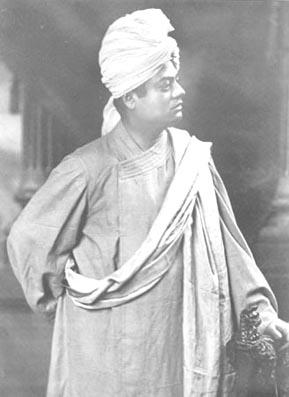 "Fitness"
and "yoga" were rarely mentioned in the same breath in
1893 when Calcutta-born yoga scholar Swami
Vivekananda addressed a world religions conference in
Chicago and yoga gained its first following in America. Yoga
never grew in popularity until the Vietnam War era, when the
counterculture of the '60s embraced Eastern influences.
Suddenly, yin-and-yang symbols were everywhere, and yoga was
cool among the rebellious. But yoga couldn't keep
pace with the Fitness Revolution, says Harvey Lauer, president
of American Sports Data, a New York research firm. By the new
millennium, a "new, kinder and gentler world of physical
fitness" was emphasizing stretching, flexibility, balance
and relaxation, says Lauer. Mind-body practices such as tai chi,
Pilates and yoga fit the bill. "Fitness"
and "yoga" were rarely mentioned in the same breath in
1893 when Calcutta-born yoga scholar Swami
Vivekananda addressed a world religions conference in
Chicago and yoga gained its first following in America. Yoga
never grew in popularity until the Vietnam War era, when the
counterculture of the '60s embraced Eastern influences.
Suddenly, yin-and-yang symbols were everywhere, and yoga was
cool among the rebellious. But yoga couldn't keep
pace with the Fitness Revolution, says Harvey Lauer, president
of American Sports Data, a New York research firm. By the new
millennium, a "new, kinder and gentler world of physical
fitness" was emphasizing stretching, flexibility, balance
and relaxation, says Lauer. Mind-body practices such as tai chi,
Pilates and yoga fit the bill.
Next,
yoga went Hollywood. In 1998, Madonna
released the CD "Ray of Light" with a Sanskrit chant,
touting her devotion to yoga. Two years ago,
supermodel Christy Turlington appeared in Vogue to introduce her
sexy line of yoga clothing. Yoga became
a regular mention in celebrity interviews, from Gwyneth Paltrow
to Metallica. By last summer, 15 million Americans
were practicing yoga, 28.5 percent more than the year before,
according to a Harris poll conducted for Yoga Journal. In 1998,
Lauer says, the number was just 5.7 million. With the masses
comes big business - trendy yoga
clothing with labels such as L.L.
Bean, Old
Navy, Nordstrom,
Land's End and the Gap,
meditative music, books and videos. Yoga
researcher Trisha Lamb, associate director of the International
Association of Yoga Therapists, in Manton, Calif., estimates
people are spending $20 billion annually on yoga.
Basically,
yoga future looks bright. At
Gaiam, one of the nation's biggest makers of yoga products,
sales have grown 41 percent over five years - despite giants
such as Nike
and Reebok
entering the market. According to
Barnes & Noble, five or six new yoga books are published
practically every month. "Yoga is such a huge category in
terms of people's interest," says editor Stephanie Tade at
Rodale Press, which last year paid a seven-figure advance for
world rights to yoga master B.K.S.
Iyengar's new
book, "Light on Life" (due out October 2005). If you
still need evidence that yoga has struck a nerve in Middle
America: Wal-Mart
and Target
now carry hefty lines of instructional videos, books and
paraphernalia.
 Yoga
Journal's circulation has
more than tripled, from 90,000 to 310,000. In the past year, the
magazine's national advertising has increased 35 percent -
including new advertisers such as Target,
Kellogg, Ford,
Johnson &
Johnson, Pfizer
and General Mills. Yoga
Journal's circulation has
more than tripled, from 90,000 to 310,000. In the past year, the
magazine's national advertising has increased 35 percent -
including new advertisers such as Target,
Kellogg, Ford,
Johnson &
Johnson, Pfizer
and General Mills.
"Yoga is mainstream,"
says Macy, "and they
want to reach the demographics of our reader - female, twenties,
thirties and forties, high median household income."Yoga
intersected with Madison Avenue when it expanded from
incense-scented studios to sweat-scented gyms, around 2000. Last
year, 2.2 million Americans were practicing yoga at commercial
health clubs, up from 400,000 in 1998, says Bill Howland,
director of public relations and research at the International
Health, Racquet & Sportsclub
Association, a trade group in Boston. Eighty percent of clubs
now offer yoga classes - twice that of six years ago.
(source: Om
sweet om: More people reaching out to yoga -
washingtonpost.com). For more refer to chapter on Yoga
and Hindu Philosophy.
Top of Page
Nine Indians in MIT's list
of top 100 innovators
Indian innovators are holding their own in
America's frontiers of science and technology. The prestigious
MIT Technology Review this year features as many as nine Indians
in its list of top 100 innovators, all of them under 35. They
include Srinidhi Varadarajan, who conceived and built the
world's third fastest supercomputer earlier this year. Director
of Terascale Computing Facility at Virginia Polytechnic
Institute, the 31-year-old Varadarajan worked with a cluster of
1,100 Apple Macintoshes and his creation cost a mere $5 million.
Other supercomputers of this class cost $100 million or more.
"The TR 100 represent the diversity of those using
technology to transform the world around us," says the
Technology Review. The handpicked ones are all "developing
technologies that defy easy classification, often fusing recent
advances in computing, medicine and nanotech".
Chaitali Sengupta, a systems architect at Texas Instruments, has
been recognised for her work on communications chips used in
advanced cellular systems now coming to market. These chips let
multimedia cell phones more easily handle Internet access,
videoconferencing and mobile commerce. Another Indian at Texas
Instruments to make it to TR 100 is Anuj Batra. A systems
engineer, he leads one of the industry's top teams advancing
ultrawideband wireless technology that provides high
transmission speeds needed for streaming media applications
while consuming little power.
Others recognised for their innovations include: Smruti Vidwans, a postdoctoral fellow at University of
California, for developing a new approach to develop anti-TB
drugs. Vikram Sheel Kumar, cofounder and CEO of Dimagi in
Boston, who has developed an interactive software that motivates
patients to manage chronic diseases such as diabetes and AIDS.
Ananth Natarajan, CEO of Infinite Biomedical Technologies in
Baltimore, Maryland, for developing a technology that will
enable implantable cardiac devices to detect incipient heart
attacks. Ramesh Raskar, a research scientists at Mitsubishi
Electric, for building large computer display systems that
seamlessly combine images from multiple projectors and for
image-processing and graphics research that may lead to new
applications in entertainment and image-guided surgery. Mayank
Bulsara, co-founder and chief technology officer of AmberWave
Systems, for developing strained silicon that makes computer
chips run faster and consume less power. Ravi Kane, an assistant
professor at Rensselaer Polytechnic Institute, for developing a
highly potent anthrax treatment.
(source: Nine
Indians in MIT's list of top 100 innovators -
hindustantimes.com).
Top of Page
Christian
Evangelism: Whither Decency?
-
By Harendra De Silva
Wiping
out World Cultures
The world (or more correctly, the west) appears infatuated
with "Muslim fanaticism." We are told over and over
again that Islam preaches fanaticism, and that Muslims are
allegedly violent and have a blind hatred of non-Muslims. But
really, how true are these vacuous claims? They are stories made
to justify violent attacks on the Muslim community around the
world, and take attention away from those who really harbour
ill-will against followers of other religions. The
media has not given enough attention to the insidious campaign
that is taking place this very minute to reduce and wipeout
Hinduism, Buddhism, Islam and the various other religious
traditions that are followed by large sections of humanity.
When
I look around, the only people I see trying to wipe out other
religions and other peoples' belief systems are the Christian
evangelists and their loud supporters. I have never ever
encountered a Buddhist, Hindu or Muslim preacher barging in on
my privacy and pushing their holy books in my face, nor have I
seen Buddhists, Hindus or Muslims set up organizations purely
for the sake of converting others through hook and crook. Despite having a similar religious
heritage, we can clearly see that it is the Christian
evangelists who are the real religious extremists, and not the
Muslims as loudly claimed by various sections of the media.
Christian
evangelism today does not appear to have any respect for
cultural and religious diversity. Its aim is to wipe out all
non-Christian cultural and religious traditions and replace them
with Christianity - more often than not the western version of
it, which has very little in common with the country or society
it is targetting. Many tribal societies across the world have
lost their heritage and are in the process of losing them due to
the activities of these evangelists. In refusing to see the good
in other religions and other ways-of-life, Christian evangelists
take on an extremely fundamentalist position that is an affront
not only to non-Christians, but to moderate Christians as well.
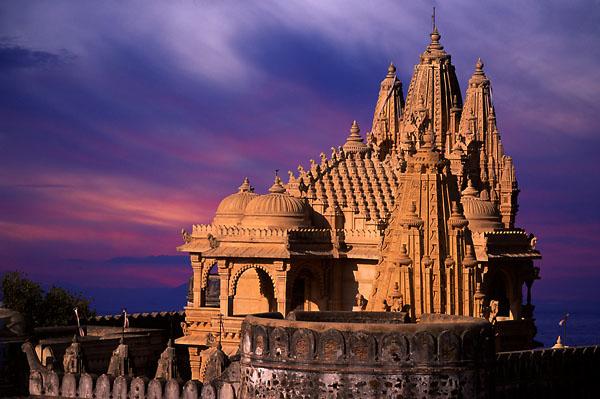
For
these Christian misionaries, the sooner all the non-Christian
"pagan" and "Satan-inspired" religions
perish or are annihilated, the better the world will be; a
rather fanatical, nazi-esque position if there ever was
one.
(For
more refer to chapter on Greater
India: Suvarnabhumi and
Sacred
Angkor).
***
I
am often quite amazed and plainly shocked at the fanatical zeal
shown by these Christian evangelists, who wish to convert the
entire world to Christianity through whatever means necessary.
Entire organizations, or more correctly enterprises, have been
set up with the sole purpose of "harvesting souls for
God," and there are many individuals whose job in life is
to convert non-Christians to Christianity, and they are paid
handsomely to do it. No expense is spared in this task of trying
to bring every single person on planet earth to the "light
of Jesus Christ," and no thought whatsoever is given to the
religious and cultural diversity that makes this world such a
wonderful place.
For
these extremists, the sooner all the non-Christian
"pagan" and "Satan-inspired" religions
perish or are annihilated, the better the world will be; a
rather fanatical, Nazi-esque position if there ever was one.
By sending evangelist teams around the world and setting up shop
in non-Christian majority countries, these evangelist
organisations work to destroy the pillars of religious
coexistence and tolerance and erect their own pillars of
religious supremacy and intolerance in those countries. And Sri
Lanka is just another one of their many targets - yet another
country "infested with evil pagans" who need to be
brought to the "light of Jesus Christ." And to them, all is
fair in war. Encouraging new converts to smash statues of the
Buddha and Hindu gods and godesses, burn pictures of the Buddha
and Hindu gods and godesses, burn Dharma books and renounce
"pagan" cultural activities are all considered
suitable methods of propagating Christanity. It is no wonder
that many Buddhists, Hindus, Muslims and moderate Christians are
simply apalled at the way the evangelists carry out their
proselytism, and are extremely worried about the impact it will
have on religious harmony in this country. It
can already be seen that the provocative activities of Christian
evangelists have led to the destabilsation of peace and harmony
among the various religious communities, and if these
evangelists continue with their unethical and iconoclastic
methods of proselytism the situation is bound to get worse.
(source:
Christian
Evangelism: Whither Decency?- By Harendra De Silva).
For more on Destruction
of Native Cultures - refer to chapter on India
on Pacific Waves and Criminal
History of Christianity
- By Prof Karl-Heinz
Deschner
and Manifest
Destiny and Thanksgiving-
a National Day of Mourning
and The
Stolen Generation and Destruction
of the Maoris of New Zealand. For
interesting article refer to to Bush's
Conversion Agenda for India: Preparing for the harvest
and Religious
freedom for Bush and for Christian
missionaries
– by Krishna
-
sulekha.com and Crisis
in the Catholic Church - Pope's
Contradictions – By Hans Kung
-
Spiegel.de
and
Religious
Conversion – Is it Anti-National? and
Their
Other "Dirty" Linen: Evangelism's Quest to Conquer the
World
- By S R Welch - secularweb.org
and The
Conversion Agenda - By Rajiv Malhotra). Refer to Attacks
on Christian
Churches are Self-Inflicted - By
Sarath
Bulathsinghala).
Top of Page
Biases in Hinduism Studies in the US - By Abhijit
Bagal
The
texts on Hinduism developed by Western scholars dwell lavishly
upon a certain set of topics that are a
big turn off to students interested in Hinduism –
These topics are Caste Discrimination, Tantric Sex, Animal
Sacrifices, Dowry Deaths, Polytheism, Hindu Fascism, Cult of
Kali, naked Naga Sadhus etc. -- which tend to give a biased view
of Hinduism as a tribal, primitive, misogynist cult that has
imprisoned millions of human beings. To add to this, many
anti-Hindu texts are prescribed reading in introductory classes
on Hinduism. A search on the Internet shows that there are some
introductory Hinduism classes in American Universities where
even books like “Why I am not a
Hindu” by Kancha Illiah are prescribed
reading!
Will anyone recommend
Ibn
Warraq’s “Why I am not a Muslim”
in an introductory course on Islam? Or how about Bertrand
Russel’s “Why
I am not a Christian” in an
introductory course on Christianity?
RISA
(Religion in South Asia)
scholars often hold the Hindu Diaspora in the United States in
utter contempt.
It
appears that the Indologists and RISA scholars often have a
problem relating to India and Hindus in general. They seem to
suffer from some kind of bias or phobia that prevents them from
portraying Hindus and Hinduism in a praiseworthy, sensitive or a
sympathetic manner. There seems to be this fear that if Hindus
or Hindu organizations are presented sympathetically, the author
might be perceived as a New Ager, a closet supporter of Hindu
Fascists and so on. Contrast this with the attitude of
Professors on Islamic studies. Even after the September 11
attacks, there is no dearth of scholars who rush to absolve
Islam of any wrong doing, or trying to understanding the psyche
of Islamic societies and their suffering under ‘Western
Imperialism’.
Another
student who took a class in Stanford
University in 2002 comments: "I
took a class in Indian history at Stanford last year. After
discussing the Ramayana, the instructor showed one
film: “We
are not your monkeys” by Anand
Patwardhan. I found myself in the strange
position of criticizing a film that I admire. I asked the
instructor if he would consider showing the
Robert
Mapplethorpe sculpture (the Crucifix immersed in
urine) in
an introductory course on Christianity as the only
example of Christian art. Needless
to say, he dubbed me a BJP sympathizer.”
Amongst
RISA studies and discussions, there is an overt
emphasis on the so called Hindu ‘F’ word --
Hindu-Fundamentalism, Hindu-Fascism, and Hindu-Fanaticism. RISA
scholars and other academics (turned into political
commentators) read selective literature by Marxists, Liberals,
Pseudo-Secularists, and other political commentators and churn
out articles and books by hundreds every year on this
phenomenon. The parties, organizations, and individuals
criticized are obviously never given a fair portrayal, and their
supposed misdeeds are described through critical secondary
publications by committed Hindu bashers and scholars with their
own political agendas. Any act of self assertion of Hinduism, or
even a questioning of some paradigms of South Asian Studies or
Indology is enough to draw the wrath of RISA scholars with
epithets like ‘Hindutva Oppressor', ‘RSS supporter’,
‘Caste Exploiter’, ‘Hindu Nazi’, ‘Bride Burner’
etc.
(source:
Biases
in Hinduism Studies Part I-IV - By Abhijit
Bagal - indiacause.com). For more on Biased Indology refer
to chapter on First
Indologists).
(For
more refer to chapter on Greater
India: Suvarnabhumi and
Sacred
Angkor).
Top of Page
Shri 108 &
Other Mysteries
The
number 108 is very auspicious for Hindus. It is the number of
beads of a rosary and of many other things in Indian cosmology.
But why is this number considered to be holy?
The
answer to this mystery may lie in the fact that the ancient
Indians took this to be the distance between the earth and the
sun in sun-diameter units and the distance between the earth and
the moon in moon-diameter units.
Two
facts that any book on astronomy will verify :
Distance
between earth and sun = 108 times sun-diameter
Distance
between earth and moon = 108 times moon-diameter
Indian
thought takes the outer cosmology to be mirrored in the inner
cosmology of the human. Therefore, the number 108 is also taken
to represent the 'distance' from the body of the devotee to the
God within. The chain of 108 'links' is held together by 107
joints, which is the number of marmas, or weak spots, of the
body in Ayurveda.
We
can understand that the 108 beads of the rosary must map the
steps between the body and the inner sun. The
devotee, while saying beads, is making a symbolic journey from
the physical body to the heavens.
108
is a number which resonates throughout the universe, as this
shows. There are also several other numbers which are repeated
throughout creation.
The reason why we do our mantra jap 108 times is because its a
symbol of our journey towards our higher/spiritual self (sun)
from our material self (earth).
(source:
Shri
108 & Other Mysteries - By Subhash Kak - sulekha.com
and http://www.cycleoftime.com/articles_view.php?codArtigo=58
).
Top of Page
On
Cultural Re-engineering of Indigenous History and Sacred Lore
In
all the lands that were ravaged by Imperialism, the Church tried
very hard for centuries (and also managed) to destroy records.
They did this in Armenia, Azerbaijan, turkey and the
middle-east, and then merged the local history into Biblical
angles. As many of you will be aware, it is documented history,
that the church destroyed historical records and sacred lore in
these lands, on the grounds that they were non-Christian.
The
records that were not destroyed (like the cuneiform records of
Mesopotamia) were reinterpreted in with non-original
pronunciations. As you may be aware, cuneiform records had been
deciphered by allotting biblical monikers to the signs
indicating Mesopotamian king names. This means that all the
cuneiform records of the Middle-East have only been interpreted
biblically. The entire Mesopotamian history is therefore suspect
(especially the names of the kings) - having been gleaned only
from the biblical perspective. All Assyrian king names are
interpreted to match Assyrian history mentioned in the Bible. To
be sure, even the word "Assyrian" is Biblical - the
Assyrians called themselves Asuras,
but historians insist on referring to them by biblical monikers.
The Asuras play a prominent part in Indic lore, and yet no
historian has interpreted the cuneiform records in a non-bibliocentric
perspective, taking Indic lore into account. This merely points
to a huge bias towards historical validation of biblical myths,
while completely disregarding
non-biblical sacred lore, even when it is very
pertinent. Even original Persian names were Hellenized and
changed from their original pronunciations, and forced down the
throats of the Persian populace. For example, original Persian
names of Cyrus and Darius are Kuroush
and Darayush - very
different from their westernized avatars. Again,
all historians (as well as many Zoroastrians themselves)
continue to refer to these kings by Western pronunciations.
If
you noticed, there have even been attempts to change the
spelling of Krishna to Chrishna, etc., to induce a subliminal
connection between Krishna and Christ, when there is none.
This may be understandable in a strait-jacketed, narrow-minded
age, where only biblical history was considered valid, and when Galileo
was considered evil to suggest things that were not mentioned in
the Bible. However,
even then, a large corpus of historical epics escaped such
cultural re-engineering, by an ingenious oral documentation
method invented by Brahmin priests. This is an absolutely
fascinating saga of human history.
Now,
prima facie, Fahrenheit
451 is supposed to be science fiction. But in
reality, it is the hidden story of how the Church
destroyed physical records everywhere (and
effectively usurped local history everywhere), and yet the Indic
literature and history survived in-toto, by a method of precise
oral documentation, devised by the Brahmin priests, down the
generations, lasting for thousands of years. Hence,
all of the original Vedic literature in India comes from precise
oral transmission.
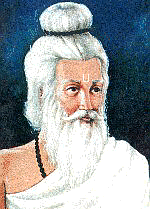
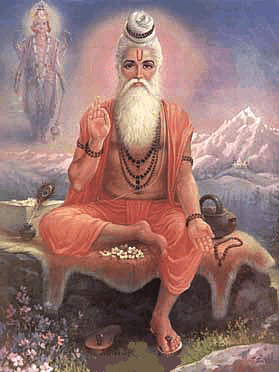
And
that, in short, is how Indic literature has resisted distortion
to a great degree from Eurocentric or biblio-centric scholars
with an agenda.
(For
more refer to chapter on Greater
India: Suvarnabhumi and
Sacred
Angkor).
***
Entire
volumes of Sanskrit literature (the four Vedas, the Mahabharata,
which is the world's largest epic-poem, and the Puranas were
memorized in-toto by Brahmin priests, in a highly defined and
accurate manner, and then passed on to their children and
grandchildren. Thus, there were Brahmin families who
had memorized either one veda, or two vedas or three or four
vedas and these families were accordingly named (Dwi-vedi, Tri-vedi,
Chatur-vedi, etc). It was considered a sacred duty of these
families to preserve this ancient literature, and they have
preserved it accordingly, within their neural networks, even in
very extenuating circumstances of persecution, often at the cost
of their lives. (In fact, the Hindus have the unique distinction
of having an entire mountain range named after Hindu genocide -
the Hindu-kush mountains - meaning, the place of "Killing
of Hindus").
Thus,
there was no physical literature for the Cultural re-engineering
hit-men to burn or distort. Nor could they check the
transmission of this literature. The
pronunciation of a word in Sanskrit will be exactly the same as
it was 3000 years ago -
there is no other linguistic system in this world that has this
kind of a built in accuracy. It may be noted that phonetic
sounds are the toughest thing to preserve in historical
archiving, and ancient Sanskrit literature managed even that,
for thousands of years.
It
means this - a Brahmin from southern India who has never even
stepped out of his village will be able to recite the Rig-veda
with exactly the same words, pronunciation, accents, and meter,
as another Brahmin from northern India, who has also never
stepped out of his village. Hence the accuracy of oral
transmission of sacred literature in India is unprecedented and
can be cross-checked at any given time from Vedic scholars, due
to the huge number of undistorted backups, preserved accurately
within the neural networks of Hindu Scholars. And
that, in short, is how Indic literature has resisted distortion
to a great degree from Eurocentric or biblio-centric scholars
with an agenda.
(source: On
Cultural Re-engineering of Indigenous History and Sacred Lore
- sulekha.com). For more refer to chapter on FirstIndologists.
Top of Page
Monotheists
clamor for Tribal harvest - By Sandhya Jain
Europe's civilian revolt against the stranglehold
of the Catholic Church was won by resurrecting its Pagan
heritage as exemplified in Greek philosophy and Roman law. The
resultant duality of religious and secular authority provided
space for individual liberty, science, and material progress.
Hindu society, despite civilizational stresses from hostile
invasions, managed to preserve its cosmic worldview and to
resist imposition of a mono-source of political and religious
power. Islam has been consistent in its advocacy of a single
religio-political authority.
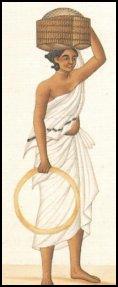 Of the three traditions, I consider the
White Christian the most treacherous because the First World,
despite wrestling personal freedom from the pulpit, uses the
Church as an instrument of imperialism. Secularism placed
Church aspirations for dominion under non-religious leadership,
which is why Western regimes aggressively promote
proselytization and the decimation of non-Christian faiths and
cultures. The US State
Department, as the Vigil public
forum rightly points out, views
religious freedom an integral part of its foreign policy, which
makes evangelization a political agenda. Of the three traditions, I consider the
White Christian the most treacherous because the First World,
despite wrestling personal freedom from the pulpit, uses the
Church as an instrument of imperialism. Secularism placed
Church aspirations for dominion under non-religious leadership,
which is why Western regimes aggressively promote
proselytization and the decimation of non-Christian faiths and
cultures. The US State
Department, as the Vigil public
forum rightly points out, views
religious freedom an integral part of its foreign policy, which
makes evangelization a political agenda.
In
my view, Western secularism resulted, not in separation of
religion and politics, but in Church subordination to politics.
The White Christian world is thus far more lethal than Islam,
which is openly against non-Muslims.
From this perspective, the All India Christian Council's
agitation at the rising stature of the Vanvasi Kalyan Ashram in
the tribal belt spanning Gujarat, Rajasthan, Madhya Pradesh,
Chhatisgarh, Jharkhand and Orissa, makes perfect sense. Ghar
Wapsi has succeeded to the extent that conversions have
virtually stopped and the 'homecoming' movement is gathering
momentum.
The All India Christian
Council has also picked up a quarrel with the
Chairman of the
National Commission for Minorities, Mr. Tarlochan
Singh, for
having asked Delhi Archbishop Vincent Concessao to refrain from
evangelization among the Sikh community.
The Archbishop smugly reiterated the Church's old
ideological deceits that conversion is an adult choice of a
chosen way of life; that nobody can convert another person; one
can only present a way of life to another person, who is then
free to decide his response.
If this is indeed true, conversions to
Christianity should normally occur in driblets of one and two,
and not in the form of the mass conversions that accompany
sustained pressure from evangelists. More often than
not, the neo-converts have little idea of Christian theology and
its anti-Jewish bias, the schisms and purges caused by fanatical
Popes and Bishops, and the myriad changes wrought in the Holy
Bible due to the political exigencies of prevailing elites.
Conversion of the illiterate and uninformed does not meet my
standard of a "free interaction between God and man in the
sanctuary of an individual's conscience," as the Archbishop
so loftily claims.
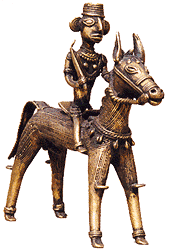
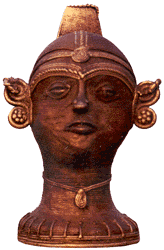
Tribal
art of India - Cast metal sculptures
***
That tribals on their own have little time for Christ or the
pious missionary can be seen from the fact that the merciful
exit of Mrs. Gladys Staines (widow of Australian missionary
Graham Staines) from India led to a massive homecoming of
converted tribals. In Orissa's Mayurbhanj district, seventy-five
Christians returned to the Hindu fold last month and more are
slated to re-embrace their native faith. The cognoscenti would
be aware that acute resentment at Graham Staines' conversion
activities had resulted in his sensational murder some years
ago.
(source:
Monotheists
clamor for Tribal harvest - By Sandhya Jain - dailypioneer.com -
October 18 2004). http://www.saag.org/BB/view.asp?msgID=8349).
Refer
to
Bush's
Conversion Agenda for India: Preparing for the harvest
and The
Moloch: A Critical History of the U.S.A. - By Prof
Karl-Heinz Deschner and
Their
Other "Dirty" Linen: Evangelism's Quest to Conquer the
World
- By S R Welch - secularweb.org and Religious
Conversion – Is it Anti-National?).
Refer to Attacks
on Christian
Churches are Self-Inflicted - By
Sarath
Bulathsinghala).
Tribal
origins of Hindu dharma - By Sandhya Jain
The
British claimed that India's Adivasi population lay beyond the
pale of mainstream Hindu society. Yet
even a cursory mapping of the spiritual-cultural landscape
reveals a deep symbiotic relationship between tribals and non-tribals,
which is amply reflected in the ancient literature and in
inscriptions. Indeed, it was also noted by colonial
anthropologists and ethnographers (mainly British officials),
who deliberately delinked tribals from Hindu society through
imposition of racial categories and Census classifications.
Tribals have made an
enormous contribution to India's civilization; all major gods of
the Indic tradition have tribal links. Shiva was worshipped by
forest-dwelling communities in large parts of the country, as
were Vishnu's incarnations as Varaha (boar) and Narasimha
(lion). Vishnu in fact evolved out of several distinct deities,
notably Vasudeva, supreme lord of the Vrishni/Satvata tribe;
Krishna of the Yadava clan; Gopala of the Abhira tribe; and
Narayana of the Hindukush mountains. Similarly, Gautama Buddha
hailed from the Sakya tribe; Vardhaman Mahavira was a scion of
the Jnatrikas.
There is to this day a close relationship between the Kurumba,
Lambadi, Yenadi, Yerukula and Chenchu tribes and Shri
Venkateshwar of Tirupathi. Lord Ayyappam in Kerala and Mata
Vaishno Devi in Jammu also appear to have tribal links. All
these gods and temples, as also that of Jagannath in Puri, enjoy
preeminent status in the classical Hindu pantheon. Mahatma
Gandhi insisted that tribals
are an inalienable part of Hindu society.
(For
more refer
to Adi
Deo Arya Devata. A Panoramic View of Tribal-Hindu Cultural Interface
- By Sandhya Jain).
Top of Page
Christian
Churches in Kerala Adopt Hindu Ceremony
Making it more palatable for Hindu Converts?
HPI note: The following is an example
of what the Christians call "inculturation," the
adoption of Hindu customs, beliefs and practices into a
Christian setting in order to make the church as a whole more
palatable to possible Hindu converts.
St. George Orthodox Syrian Church in Thiruvananthapuram
conducted Vidyarambham or the ceremony to initiate children into
the world of letters over the weekend. It
is essentially a Hindu tradition, which this Thirvananthapuram
church started following last year. This time many Christian and
non-Christian parents took part in the ceremony with their
children. "The Hindus take their children for this
ceremony. So we were also keen to get this ritual done through a
church leader," says Bindu, a parent. "We believe that
if it's done in the name of Jesus, the children will be
disciplined, they will respect their parents and listen to their
teachers," says another parent G K Soman. When this church
began the ceremony last year, it was opposed by a section of the
congregation who alleged the "Hinduisation" of the
church.
But this time the church Vicar got the backing of the Church
general body. The Vicar insists the church is adopting a
Malayalam tradition rather than a Hindu ceremony. But he admits
it could help soothe communal tension, specially since the
Kerala Christian community has been increasingly attacked by
right wing Hindu groups in the recent past. "Surely it will
lead to communal harmony. That is the main aspect. That's why we
are conducting it," says Father Geevarghese Erakkath,
Vicar. Taking a cue from the Thiruvananthapuram church, two more
churches and a mosque organized similar functions in the State. Although
Vidyambham is a traditional Hindu ceremony, the church leaders
here view it as an integral part of Kerala's rich cultural
heritage. They say they have set a precedent for other Christian
denominations to follow to strengthen the secular fabric of our
country.
(source: Christian
Churches in Kerala Adopt Hindu Ceremony - hinduismtoday.com).
http://www.christreview.org
newwindow]www.christreview.org
and http://www.saag.org/BB/view.asp?msgID=8575)
Refer to Attacks
on Christian
Churches are Self-Inflicted - By
Sarath
Bulathsinghala).
Top of Page
Svetoslav Roerich - The Russian artist who loved India’s soul
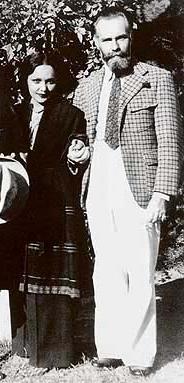 Few
foreigners
imbibed the spirit and ethos of India, especially of life in the
mountains, the way the Roerichs, father Nicholas and son
Svetoslav, did. They lived in India at a time of political,
social and cultural ferment. E. B. Havell, Sister Nivedita,
Helena Blavatsky and Ananda Coomaraswamy, among others, were
reviving and projecting the spirit of Indian art and cultural
heritage to the West. They believed in replacing western
influence with a romantic indigenous style inspired from the
traditions of Ajanta and Mughal schools. Few
foreigners
imbibed the spirit and ethos of India, especially of life in the
mountains, the way the Roerichs, father Nicholas and son
Svetoslav, did. They lived in India at a time of political,
social and cultural ferment. E. B. Havell, Sister Nivedita,
Helena Blavatsky and Ananda Coomaraswamy, among others, were
reviving and projecting the spirit of Indian art and cultural
heritage to the West. They believed in replacing western
influence with a romantic indigenous style inspired from the
traditions of Ajanta and Mughal schools.
Born on October 23,
1904 in St. Petersburg, Russia, Svetoslav Roerich received his
early schooling in his own country as well as in Sweden. In
1918, he went to England where he studied art for about two
years, followed by a stint in the USA, first at Columbia
University and later at the Harvard School of Architecture.
Svetoslav’s paintings were first exhibited in
India in 1936-37 in Lucknow. Nicholas Roerich was a mystic.
Dedicated to the Himalayas, he painted them as no one has.
Svetoslav was a romanticist to the core. His landscapes offered
glimpses of poetic India. They vividly brought alive the spring
in the Kulu valley, autumn trees and murmuring rivers as visions
of joy. In
1945, he married Devika Rani, the first lady of Indian cinema
and grand-niece of Rabindranath Tagore, a sublimely beautiful
woman. The people of Kulu celebrated the wedding. All 365
devtas
of the valley sent their representatives to meet Devika. The
locals sang and danced and threw flowers on to the palanquin on
which Devika was carried. Devika
comes across in many of his paintings depicted with flowers in
her hands. Svetoslav
prepared many of his basic colours himself, based on his
knowledge of Himalayan plants.
Svetoslav
adopted the tradition of Indian miniatures in applying striking
colours to evoke human moods. The Ragmala series of painting
inspired his spirit of romanticism, against the backdrop of
nature, season and human moods. His best-known paintings, the
series of The Sacred Flute, have their source in Krishna art.
Representation of the mortal shepherd boy and the immortal
Krishna, symbolically unifies man and nature with its synthesis
of expression and music.
After a journey to Tibet and Mongolia, the
Roerich family had settled down at Naggar in Kulu, which became
their Indian home. When Nicholas Roerich died in 1947, his elder
son Yuri went back to Moscow to join the Institute of Oriental
Studies of the USSR Academy of Sciences. The younger son, Svetoslav,
who had inherited his father’s passion for the art and history
of India, decided to stay back.
He dedicated himself to India and drew from this world
the subject matter for his canvases. He
considered Shiva’s temple at Bajaura as a unique example of
creativity in the Himalayas.
Svetoslav Roerich passed away on January 30, 1993.
(source:
Svetoslav
Roerich - The artist who loved India’s soul
- tribuneindia.com).
Top of Page
Asians facing racism in America
Having been born and raised in
apartheid-ridden South Africa, I am no stranger to racism. In
clusters, on student campuses and in dorm rooms, we discussed
the devastating consequences of racism all the while looking at
America as the model for a new social order. Little did my
idealistic counterparts or I realize that racism was alive and
well in America.
Little
did I realize that racism in South Africa was politically and
socially recognized,
while racism in America was far more insidious. Racism here
prevailed at all levels -- only, it was disguised by a veneer of
political correctness. Also,
I quickly learnt that while I was a non-European in South
Africa, which, for all intents and purposes, translated into
being Black, in America, I was a non-entity.
Popular
television shows like 'Seinfeld' and others portray Asians in a
negative light, mimicking accents and stereotyping the race.
I shudder to think of what my child goes through
in school to overcome these stereotypes. While
Blacks and Hispanics have challenged stereotypic portrayals of
their race, Asians have yet to develop the political or legal
clout to make similarly successful challenges.
Are
we going to raise a nation of ignoramuses who view people from
other cultures and countries as inferior?
These
are the challenges we face as we go forward in the new
millennium where the faces of those in power are changing color
and the cultures that are considered third world are dominating
high-tech fields.
(source: Asians
facing racism in America
- By Dr.
Praveena Singh Kaw).
Top of Page
Kalidas
- India's greatest
Sanskrit poet and dramatist
Kalidas,
the greatest poet, writer and the literary figure of his time,
living a pious life and sincerely devoted to his scholarly work,
was one of the nine gems of King Vikram’s court.
Kalidas
is
considered one of India's greatest Sanskrit poets and
dramatists. Known to be an ardent worshipper of Shiva, he wrote
his plays and poetry largely based around Hindu philosophy. He
was one of the so-called nine gems of Vikramaditya's court in
Ujjain. The earlier claim pointing to his existence around 1st
century BC, is supported by his play on the Sunga
king Agnimitra
who belonged to that period. It is very unlikely that he would
have made this obscure king the hero of his play unless he
belonged to that period. The Vikrama calendar also begins with
58-57 BC. However, not much is known about his personal life and
background, though there are several legends and tales about his
life.
Three
famous plays attributed to Kalidas are Malavikaagnimitra
(Malavikaa and Agnimitra), Vikramorvashiiya
(Pertaining
to Vikrama and Urvashi)and Abhigyaanashaakuntala
(The Recognition of Sakuntala). The work listed last is his most
famous play, and was the first of his to have been translated to
English and German.
Kalidas
is also known for his famous poems. His two famous epic poems
are Kumaarasambhava
and Raghuvamsha
(The Clan of Raghu), and two famous lyrical poems are Meghaduuta
(The Cloud Messenger) and Ritusamhaara
(The Exposition on different seasons).
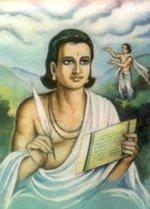
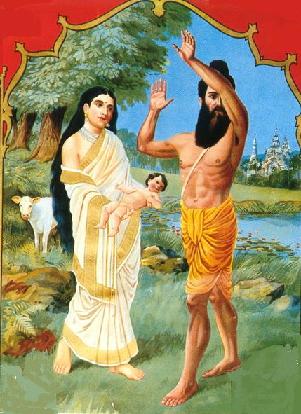
Kalidasa
made a distinct and glorious contribution to the sumptuous
Sanskrit literature. His works are an intellectual treat to
thinkers and common readers alike.
One
of the lyrics, Meghaduta (The Cloud Messenger), influenced the
German dramatist Friedrich von Schiller's drama Maria Stuart
(1800), and Shakuntala provided the idea for the prologue to the
German poet Johann Wolfgang von Goethe's
Faust (first part,
1808; second, 1832).
(image
source: Art
and Nationalism in Colonial India, 1850-1922
- By Partha Mitter).
(For
more refer to chapter on Greater
India: Suvarnabhumi and
Sacred
Angkor).
***
His best-known
play, Abhigyana Shakuntala,
named after its heroine, is based on a romantic story from the
Mahabharata. Kalidasa was also a master of the epic poetry form
called kavya. In this tradition, literary style and form tend to
assume more importance than the theme of the story. Kalidasa's
narrative poem Meghaduta (The Cloud Messenger) describes how a
cloud acts as a go-between for two separated lovers. It contains
many elaborate descriptions of love and nature.
Professor
Sylvain Levi,
French scholar
(1863-1935) Orientalist who wrote on Eastern religion,
literature, and history. He said:
'
Le
nom de Kalidasa domine la poesie indienne et la resume
brillamment. Le drama, l'epopee savante.'
A poet who has
made a distinct and glorious contribution to this sumptuous
Sanskrit literature is Kalidasa. He has pictured in his works
the beauty in life and pondered upon how we can give pleasure to
others by generous and graceful behavior. His portrayals are
vivid and heart- warming; his word power is unique. In a few
words he is capable of bringing out the entire meaning intended.
His writings touchingly show up a noble, meaningful mode of life
for the people to pursue. His works are an intellectual treat to
thinkers and common readers alike.
(source: Kalidas
- India's greatest
Sanskrit poet and dramatist
- wikipedia.org).
For more on Kalidas refer to chapter on Sanskrit).
China
installs Kalidas statue in Shanghai
Shanghai now has a statue of Sanskrit poet Kalidas on one of its most
important streets, something that few
Indian cities can boast about. A bronze bust of the
poet was unveiled at the Shanghai Theatre Academy on a street
called the ‘Shanghai theatre way’, which is being developed
as the cultural and artistic hub of the eastern metropolis.
Shanghai is one of the few world cities outside India, if any,
to sport a statue of the great 5th century poet. The statue of
Kalidas is the first to be set up. He may be the only Asian
literary figure to be given this honour as the other statues
will depict writers and poets from non-Asian countries, sources
said.
(source: After
Gandhi, China installs Kalidas statue
- By
Saibal Dasgupta).
Top of Page
The
Kalidas Festival
Ramtek's glorious Heritage
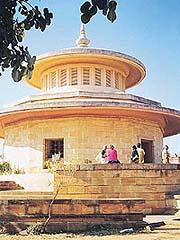 Ramtek
is a small tehsil town that is well known for a number of
reasons: it is a place of pilgrimage and tourist attraction; its
orchards produce high-quality betel leaf; it is known for its
sprawling lakes and scenic grandeur; and, above all, it is
venerated as the birthplace of a great literary work, for it was
here that Kalidas wrote his masterpiece Meghdoot. On the
first day of Ashad, the monsoon month, lovers of
literature gather at the Kalidas memorial, built recently on
Ramgiri mound, to pay their homage to the great poet. Ramtek
is a small tehsil town that is well known for a number of
reasons: it is a place of pilgrimage and tourist attraction; its
orchards produce high-quality betel leaf; it is known for its
sprawling lakes and scenic grandeur; and, above all, it is
venerated as the birthplace of a great literary work, for it was
here that Kalidas wrote his masterpiece Meghdoot. On the
first day of Ashad, the monsoon month, lovers of
literature gather at the Kalidas memorial, built recently on
Ramgiri mound, to pay their homage to the great poet.
Meghdoot
has an uncanny quality of leaving the reader mesmerised as
much by the delicacy of its romantic theme as by the sheer
beauty of its sensuous imagery. The cloud’s journey from
Ramgiri to Alkapuri, mapping the terrain from central India to
the northern most area in the Himalayas, is also a travelogue
forging the geographical unit of India. When Yaksha
stands enchanted on a hilltop and, looking wistfully at the
dark, bulbous clouds, weaves his magic web, the reader is
transported to a different world and wonders where could Kalidas
have written this work? Is the description imaginary or does
such a place exist on this earth?
Indeed,
it is at Ramgiri, a dwarf hill standing at about 500 ft above
the town (Ramtek), where the poet stood and gazed longingly at
the sky and thought of Ujjaini and his beloved. The first four
lines of Meghdoot give a clear indication of Yaksha
living in Ramgiri after his exile. Ramgiri and Ramtek towns have
a long historical past. Ramgiri signifies "the hill of
Ram" and the name Ramtek means both the hill (tekri in
Marathi) of Ram or the place where Ram rested for a while before
proceeding down south. It is also believed that Ram killed
Sambuk here. Older names of the area are ‘Sinduragiri’ (the
vermilion mount) and Tapogiri (the hill of penance); and both
these have been found on an inscription on the 14th century
Lakshmana temple. According to the legend, Vishnu, in his
Narsimha incarnation, had slain the demon Hiranyakashyap whereby
the stones on the hill were coloured red by his blood. Whatever
the myth, it is a geographical fact that the rocks and stones
appear almost blood red in the sunlight.
Now a
significant question arises how and why Kalidas went to Ramtek
from Ujjaini? There is little doubt that the exiled Yaksha
is Kalidas himself and Alkapuri is Ujjaini and that Kalidas is
pining for his beloved.
History has
it that during Emperor Chandragupt
Vikramaditya’s time Nagpur and the adjoining area,
which is now known as the Vidarbha region of Maharashtra, was
under the Vakatak dynasty
and Rudrasen was ruling over the kingdom with his capital at
Nandivardhan, now called Nagardhan. In 395, King Rudrasen got
married to Chandragupt Vikramaditya’s daughter Prabhavati.
Historians aver that the marriage was solemnised in Ujjaini with
great pomp and show and that Kalidas’s Malvikagni Mitra was
first staged on this occasion. Unfortunately, Raja Rudrasen died
in 405 AD, in a military exploit, leaving the young Prabhavati
with two sons to look after. However, instead of going back to
her mighty father, she decided to stay on and manage the kingdom
till the sons matured. It was at this time of trial that Emperor
Chandragupt Vikramaditya thought of sending a few experienced
and trusted courtiers to help his daughter. Kalidas was one of
them. Another version is that jealous of Malvika’s love for
Kalidas, Vikramaditya banished the poet-lover to Ramgiri.
Nandivardhan is just five km from Ramtek. It is possible that
the poet often trekked nostalgically to Ramtek, drawn by its
religious aura, serenity, the cool huge lakes, thick jungles and
verdant valleys, and struck upon the plot of Meghdoot
there.
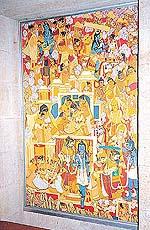 The
Kalidas festival is held at Ramtek, Nagpur in the month of
November for two days. Ramgiri, or Ramtek as it is popularly
known today, is the place that inspired Kalidas and its beauty
features predominantly in his literary work.
The Kalidas Festival brings back memories of the
golden period of the Vidarbha region
Some
of the greatest exponents of music, dance and drama perform in
the picturesque setting of Ramtek, celebrating its glorious
heritage. The
Kalidas festival is held at Ramtek, Nagpur in the month of
November for two days. Ramgiri, or Ramtek as it is popularly
known today, is the place that inspired Kalidas and its beauty
features predominantly in his literary work.
The Kalidas Festival brings back memories of the
golden period of the Vidarbha region
Some
of the greatest exponents of music, dance and drama perform in
the picturesque setting of Ramtek, celebrating its glorious
heritage.
The nearby
hills of Ramgiri are steeped in legends. As you drive up you are
surprised to see vast silver patches shimmering in the sun.
These are the lakes that abound in Ramtek. Your first stop is at
a round structure known as Kalidas Smarak. It is simple and
pleasantly coloured. You have to take off your shoes to go in.
Inside, scenes from plays of Kalidas are painted on the walls.
One can recognise Shakuntala with her deer and Yaksha watching
the clouds.
A
furlong or so away from the memorial, a flight of steps leads
you atop a huge but crumbling citadel. Here are a number of
temples dedicated to Dhumreshawar Mahadev, Rama, Lakshmana, Raja
Dashrath as also to Varah (Vishnu in his incarnation as a boar).
This figure is referred to in the inscription as "The
Primeval Boar". Visitors
try to slide under its belly and if one successfully comes out,
one is considered lucky. Monkeys play tricks to amuse
you as go up the steps. At the top there is an eyelet called Ram
Jharokha, which gives a panoramic view of the surroundings. The
Bhosles of Nagpur, during their rule, took good care of the fort
and maintained it well but it is in a dilapidated condition at
present.
(source: Ramtek
— Where Kalidas wrote Meghdoot and
The
Kalidas Festival).
Chronicling
Krishna's life - to the last second
Ahmedabad, Sep 10 (IANS) It was Feb 18, 3102 B.C. Friday at
02 hours, 27 minutes and 30 seconds in the afternoon when the
Hindu god Krishna left his earthly body for his heavenly abode -
or so claims an ascetic after intensive calculations.
Swami Gyananand Saraswati of the Varanasi-based Adi Jagadguru
Shankaracharya Vedic Research Institute also claims to have
calculated exactly how many hours Lord Krishna spent on earth
and his precise age when the epic battle Mahabharata ended.
He says Lord Krishna, one of the
prime deities in the Hindu pantheon, spent 125 years on earth
and departed for his heavens precisely 5,106 years ago.
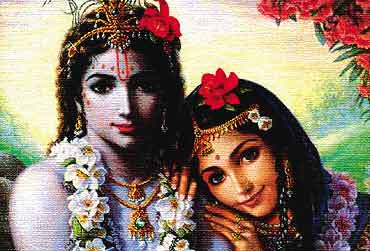 The ascetic scholar presented a detailed timeline of the life
of the blue-skinned god before a gathering of scholars at
Somnath temple in Prabhas Patan, 350 km from this Gujarat city.
He says his calculations are based on the study of various
Indian scriptures, including Skand Purana, Shrimad Bhagawat
Purana, Shri Vishnu Mahapurana, Matsya Parva and the epic
Mahabharata. The ascetic scholar presented a detailed timeline of the life
of the blue-skinned god before a gathering of scholars at
Somnath temple in Prabhas Patan, 350 km from this Gujarat city.
He says his calculations are based on the study of various
Indian scriptures, including Skand Purana, Shrimad Bhagawat
Purana, Shri Vishnu Mahapurana, Matsya Parva and the epic
Mahabharata.
He also referred to the astrological treatise Bhrigu Samhita
for dating various events in Krishna's life.
(Artwork
courtesy of The Bhaktivedanta Book Trust International, Inc. www.krishna.com).
He fed the data into a computer and used a special software
to determine the longitude and latitude of various places
mentioned in the texts. He says Krishna
died 36 years after the war of Mahabharata.
"His age on the last day of the war was 89 years, two
months and seven days. That tallies with the estimate of 125
years," Saraswati asserts. He claims that Krishna was born
the 22nd day of the fourth month of the 863,874th year of Dwapar
Yug, which was the eighth day of the second half of the Hindu
calendar month of Shravan, the day Janmashtami, or the birth of
Krishna, is celebrated.
Saraswati, who is at the Somnath temple complex for a
traditional four-month sojourn of Chaturmas, declared his
findings Tuesday to coincide with Janmashtami celebrations.He
has also worked out a chronology of the temple, one of the
Dwadasha Jyotirlingas or the 12 most important temples of Lord
Shiva. The temple has been reconstructed many times in its
history. The present temple was constructed in 1951 at the
behest of Sardar Vallabhbhai Patel, the first home minister, and
the idols were installed by India's first president Rajendra
Prasad.
(source: Chronicling
Krishna's life - to the last second
- yahoo.com).
Top of Page
Alexander the bloody brutal
?
In Alexander the Great: The Hunt for a
New Past - Paul
Cartledge exposes the Macedonian as an uncultured
gangster whose genius lay in luck.
The appeal,
of course, is infinitely romantic. An amazingly young, amazingly
brilliant warrior king conquers the world and, in myth at least,
becomes godlike. Mary Renault and Valerio Massimo Manfredi write
bestselling novels about him. Leonardo DiCaprio signs up to play
him in yet another screen version. His
victories are the serious stuff of military history. But the
question lingers, sourly insistent among so much sweet
adulation: was he Alexander the Great - or Alexander the Rather
Appalling?
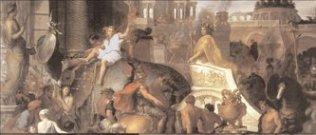 He
was unnaturally ruthless, even psychotic, from the start. He may
well have had his father assassinated. He assuredly bumped off a
formidable array of erstwhile friends and possible rivals.
Brutality marched with him every step of the journey. He could
have saved the glory that was Thebes; instead, he burnt it to
the ground and slaughtered its inhabitants. There was no mercy
on display when he captured fellow Greeks who had fought against
him. The Indus was yet another river of blood. He
was unnaturally ruthless, even psychotic, from the start. He may
well have had his father assassinated. He assuredly bumped off a
formidable array of erstwhile friends and possible rivals.
Brutality marched with him every step of the journey. He could
have saved the glory that was Thebes; instead, he burnt it to
the ground and slaughtered its inhabitants. There was no mercy
on display when he captured fellow Greeks who had fought against
him. The Indus was yet another river of blood.
Alexander
ruled by fear and intimidation. He may have left a few
quasi-democratic satraps behind on his headlong march, but that
was realpolitik not conviction. Left to himself he would always
put his foes to the sword. Some of his biographers have seen a
touch of Napoleon or Hitler in his make-up, but put that the
other way round. let the rancid stew boil merrily. He was an
appalling human being. The lust for conquest seemed insatiable.
The art of compromise was lost on him. Diplomacy, at best,
involved marrying the daughter of some hapless monarch and
adding her to his collection. My old chemistry teacher used to
lecture us lads about the virtue of having 31 ties, one for
every day of the month, so they never wore out. Alexander kept
365 women in his harem but never stood in any danger of wearing
any of them out; he preferred boys anyway.
There
is, in short, very little to be said for him. Unreasoning
ambition drove him on, but he left nothing by way of philosophy
behind him. The spread of the Greek way owed nothing to
Alexander. He defeated the Athenians and rolled them into his
tatty domain. He was a gangster, a hoodlum, a thug: much less
creative than his dad.
(source: Alexander
the bloody brutal
? - guardian.co.uk - For more refer to
chapter on India
and Greece).
Top of Page
African
American converts at ISKCON find solace
For years, an African American, now called Murari
Caitanya Das, had been in search of salvation. He says he has finally found
answers to his spiritual quest at the
International Society for
Krishna Consciousness
(Iskcon).
Born into a Lutheran family, the former high school teacher is now
the assistant administrator of the Iskcon temple here.
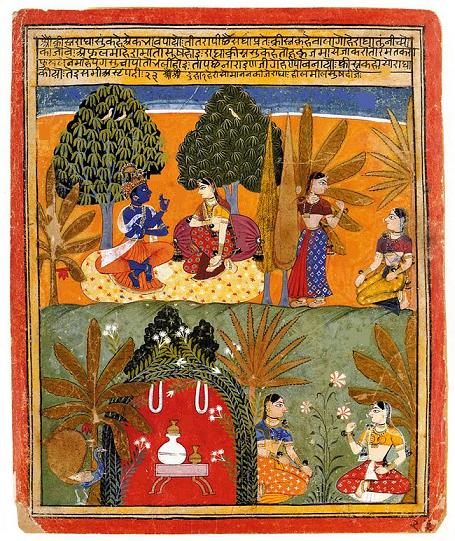
"I
found the Bhagavad Gita answered all the questions I had been
asking all my life," he says.
The
Hindu concepts of karma and reincarnation also attracted him.
(For
more refer to chapter on Greater
India: Suvarnabhumi and
Sacred
Angkor).
***
After trying transcendental meditation, new age spiritual ventures
and tarot cards to quench his spiritual thirst, Caitanya chanced
upon the Bhagavad Gita, one of Hinduism's popular scriptures, at
a library.
"I
found the Bhagavad Gita answered all the questions I had been
asking all my life," he says.
Caitanya is not the only American at the temple. Increasingly, more
and more Americans, even Hispanics, are thronging the temple
that was first opened in a Chicago suburb in 1971 before moving
to its current location in 1979.
Another enthusiastic convert to the Iskcon movement is Sunil Madhav
Das, now the president of Chicago centre. According to Sunil,
the four basic tenets of the sect - no meat, no intoxication, no
illicit sex and no gambling - is "not easy" to follow.
"To follow these principles in our society is very
difficult," Sunil says."All your associates (in the
outside world) eat meat, drink or gamble. Those of us who are
here have the support of the congregation." There are 20
full time devotees residing in the temple - three Americans, six
Hispanics and the rest Indians. They all follow a strict regimen
- getting up before sunrise for prayer rituals. Sunil says he
chants the beads 16 times every day. "The chanting focuses
the mind on god. Otherwise one could be easily caught in 'maya'
(material world)."
The administrator of the temple, Abhimanyu Das, is an American who
converted from Christianity in 1978. Abhimanyu says he was
attracted by the teachings of Swami Prabhupada, founder of the
Iskcon movement. "I found his message of 'You can change
your life' more compelling than the biblical message -'As you
sow, so shall you reap'," he says.
The
Hindu concepts of karma and reincarnation also attracted him.
"When we have been given the opportunity to serve god in this
life, we should take it. After all, there is no guarantee that
one will be born as a human in the next life. I want to liberate
myself from the material world in this life itself."
Abhimanyu, who looks after the temple gift shop and assists in
fund-raising, says he is impressed with the Indian American
professionals' "ability to balance their spiritual life
with the demands of materialism".
(source:
African
American converts at ISKCON find solace - Indo-Asian News Service - Chicago, September 21).
The Magnificent
temple of Pashupatinath of Nepal
Skanda
Puran the ancient holy text of the Hindu religion,
describes the fame of Nepal as -"in
the Himalayas there is a most auspicious blessed place, where
Shanker (the giver of joy) in the form of Pashupatinath
resides."
***
The
magnificent temple of Lord Pashupatinath about 5 kms north-east
of Kathmandu, is situated amidst many other temples on the right
bank of the river Bagmati. Pashupathinath is the guardian
spirit and the holiest of all Shiva shrines in Nepal.
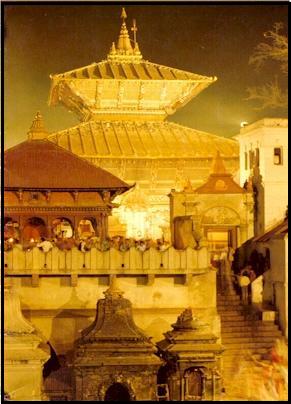
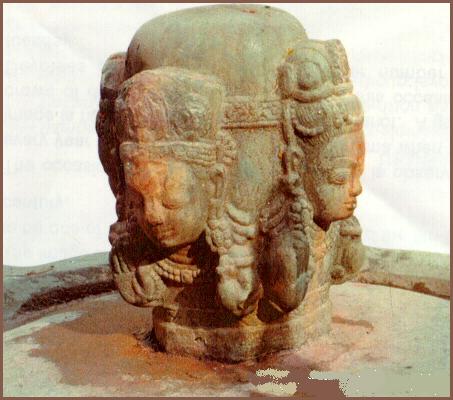
Lord
Shiva is known by many different names; and Pashupati is one. Pashupati
is the master of all living beings of the universe. This
is how lord Pashupati is eulogized in the Vedas, Upnisada and other
religious books.
(For
more refer to chapter on Greater
India: Suvarnabhumi and
Sacred
Angkor).
***
Lord Shiva
is known by many different names; and Pashupati is one. Pashu
means leaving beings, and Pati means master. In other
words Pashupati is the master of all
living beings of the universe. This is how lord Pashupati
is eulogized in the Vedas, Upnisada and other religious books.
Legends are
numerous as to how the temple of Lord Pashupatinath came to
existence here. As stated in chronicles, the image of Lord
Shiva in the form of Jyotirlinga was covered with earth over the
years, and soft green grass sprouted over it. Further, as
the legend goes, a cow used to come here mysteriously every day
and offer her milk to this holy but hidden Linga of Lord Shiva.
When the Gwala (owner) saw that the cow had stopped giving milk
since the last few days he started keeping eye on her; and
finally came across the place where the cow used to offer her
milk. With a natural curiosity to know the importance of
the place, where his cow used to make offering of her milk, the
gwala dug the place and found the Jyotirlinga of Lord Shiva.
After this number of gwalas gathered to worship this Linga
according to religious conformity, starting the tradition of
worshipping this Linga. As the time passed Lord
Pashupatinath started gaining more and more popularity and
reverence of the devotees as a guardian spirit and gradually the
temple of Lord Pashupatinath became a great place of pilgrimage.
The
rulers of Nepal, over centuries made contributions in enriching
and beautifying this holy temple. According to
Gopalraj Vamsavali, the oldest ever chronicle in Nepal, this
temple was built by Supus Padeva, a Linchchhavi King who
according to the stone inscription erected by Jayadeva 11 in the
courtyard of Pashupatinath in 753 AD happened to be the ruler 39
generation before Manadeva (464-505 AD). Yet, there is
another chronicle which states that this temple was in the form
of Linga shaped Devalaya before Supus Padeva constructed a five
storey temple of Pashupatinath in this place. As the time
passed, the need for reparing and renovating this temple arose.
It is learnt that this temple was reconsturcted by a mediaeval
King named Shivadeva (1099-1126 AD). It was renovated by
Ananta Malla adding a roof to it.
As
described in the history, this temple was attacked and badly
destroyed by Sultan Samsuddin of Bengal in the mid 14th Century.
This plunder caused so much damage to the temple that it needed
reconstruction. It was only after ten years, in
1360 AD, that it could be reconstructed and renovated by
Javasimha Ramvardhana. Another renovation work here after
was taken up by Jyoti Malla in 1416 AD.

The
present architectural nature of Pashupatinath temple came into
existence as a result of renovation by queen Gangadevi during
the reign of Shivasimha Malla.
Being
one of the most important Hindu temples, it was declared a World
Heritage Site by UNESCO.
***
The
present architectural nature of Pashupatinath temple came into
existence as a result of renovation by queen Gangadevi during
the reign of Shivasimha Malla (1578-1620 AD).
Pashupati area is regarded as one of the most
important places of pilgrimages for the followers of
Hinduism. Thousands of devotees from within and outside
the country come to pay homage to Pashupatinath every day.
And on special occasions like Ekadasi, Sankranti, Mahashivratri,
Teej Akshaya, Rakshabandhan, Grahana (eclipse), Poornima (Full
moon day) people congregate here in far greater number.
Being
one of the most important Hindu temples, it was declared a World
Heritage Site by UNESCO. The temple roofs are gilded and the
four doors are made of silver and intricate carvings cover the
windows. Many Hindu pilgrims from India as well as
from other Asian countries also visit Pashupatinath temple every
year. The temple complex has countless shrines and images along
with ghats, resthouses and parks that dazzle all those pilgrims
who come here to visit. There are also hundreds of Shivalayas,
many sadhus and statues all around the temple. Nobody knows the
actual number of statues in Pashupatinath temple area.
All
ancient Hindu religious text has described Himalayas as the
abode and activity of Lord Shiva in which Nepal remained the
nucleus.
To the west
coast of river Bagmati, which arises from a sprout in the
Himalayas, is the revered seat of Lord Pashupatinath. It is said
that a holy bath in the Bagmati river at this spot, praying with
hymns of 'Rudri Mantra', followed by worshipping Pashupatinath
Lingum with Panchamrita - curd, ghee (purified butter) sugar,
honey and milk, will render the person free from the cycle of
births.
So is the
magnanimity of Lord Pashupatinath in the minds of Hindus the
world over.
(source: The
Magnificent temple of Pashupatinath of Nepal - http://www.pokharel.com/pashupatinath_temple.htm
and
http://members.tripod.com/nepalee/pashupatinath.html
and http://www.nepal-traveller.com/mayjun2001/pashupatinath.htm
and http://www.shripashupatinath.org/thelegend.asp
Top of Page
Sanskritised tribals of
Chhattisgarh
Besides
Sanskrit, the Samaaj is introducing English in these five tribal
schools of Chhattisgarh. “Sharanam. Aham Tav Abhivadanam
Karomi.” Clad in white dhoti and kurta with a long tilak on
forehead and nicely combed hairs, students of Samarbar Sanskrit
Vidyalaya enthral the newcomer by greeting them in Sanskrit.
The tribal dominated village Samarbar
in Raigarh district has this Sanskrit school where small
children converse in Sanskrit with each other. What is more
astonishing is that these kids are not Brahmin but tribal. Years
ago an enlightened tribal person, Swami Rameshwar Kanwar, known
popularly as Gahira Guru, began to change the tribal world by
spreading spirituality.
Having read many ancient scriptures,
Gahira Guru used Ramcharit Manas, written by Goswami Tulsidas,
as a mean to teach people the essence of ‘Sanatan Dharma’.
Gahira Guru used to meditate everyday at Kailash Gupha (Kailash
cave) at Samarbar, which is now a place of tourists’ delight.
Later Gahira Guru formed a group of 20 persons to start his
organisation Sanatan Dharma Sant Samaaj at Gahira to elevate the
standard and intellect of tribal people and change the way they
were living in for centuries. In turn, this group constituted
the Sanskrit Vidyalaya at Samarbar and Gahira where small kids
frequently talk in Sanskrit, but within the school premises.
Gahira Guru’s son Chintamani, who has been appointed as the
chairperson of the Chhattisgarh Sanskrit Board says, “Sanskrit
is a sweetest language and one who practices it, can never
behave in an uncultured manner. We have heard of Kannada
speaking villagers of Mattur in Karnataka speaking in Sanskrit
and we want to bring Sanskrit in routine.”
Chintamani showed a hilly Korava tribal boy, a student of this
school, who recited aloud the Sanskrit prayer. Koravas are the
most backward community in Chhattisgarh. The Sanatan Dharma Sant
Samaaj has five Sanskrit schools at Gahira where Gahira Guru was
born, Kailash Natheshwar Gupha in Raigarh district where Gahira
Guru used to meditate, Samarbar — the place chosen by Gahira
Guru to change the tribal world, Srikote and Ambikapur, both in
Sarguja districts. Besides Sanskrit, the Sanskrit board is now
introducing English in these Sanskrit schools to keep pace with
the latest trends in the world. Recognising the works done
by the Sanatan Dharma Sant Samaaj, this year the BJP government
awarded this organisation with Gahira Guru Samman. At least one
can say that if things go on in the same pace, a miracle is
going to happen soon at Samarbar and adjoining areas to dazzle
the world.
(source: Sanskritised
tribals of Chhattisgarh - Deccanherald.com).
Top of Page
Ancient
Martial arts form of Kalaripayattu and Phillip
B. Zarrilli
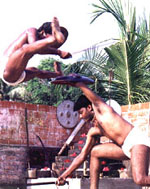 After a seven-year stint on the sub-continent,
Phillip B. Zarrilli developed a system of actor training from
the ancient martial arts form of kalaripayattu.
In 1977, a young American went to India to train alongside
boys as young as nine years old at the Kerala school of
kalaripayattu master Gurukkal After a seven-year stint on the sub-continent,
Phillip B. Zarrilli developed a system of actor training from
the ancient martial arts form of kalaripayattu.
In 1977, a young American went to India to train alongside
boys as young as nine years old at the Kerala school of
kalaripayattu master Gurukkal
Theatre
director Phillip B. Zarrilli, who was 29 at the time, was the
first Westerner to immerse himself in the 800-year-old South
Indian martial and healing arts form. He would go on to
experience a culture shock more profound than that of the lack
of television sets in 1970s Kerala.
Used
to the straightforward aggression of American football, which he
had played in high school, he struggled to relax his mind and
centre his energies - processes crucial to mastering the
graceful yet potentially lethal martial arts form. Now
57 and based in Britain where he is professor of drama at the
University of Exeter, Zarrilli executes kalaripayattu's
(pronounced kalaree-payater) complex acrobatic combinations of
steps, kicks, turns and leaps with serpentine fluidity.
Reputed in international theatre circles for having developed a
system of contemporary actor training from the exercises and
techniques of kalaripayattu, Zarrilli is here at the Jurong
campus of the Theatre Training and Research Programme (TTRP) to
steer its latest production, The Water Station.
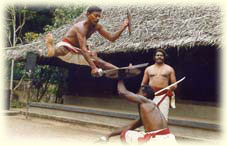 Once
a rising Minneapolis director working in the conventional
American repertory style of auditions and rehearsals leading
directly to theatre productions, Zarrilli's life and work
changed after going to India.
The reason for turning East, he says, was a
dissatisfaction with the dominant psychologically-based acting
style in the West,
Once
a rising Minneapolis director working in the conventional
American repertory style of auditions and rehearsals leading
directly to theatre productions, Zarrilli's life and work
changed after going to India.
The reason for turning East, he says, was a
dissatisfaction with the dominant psychologically-based acting
style in the West,
A
year after he began intensive formal training in kalaripayattu,
he won his teacher's confidence and permission to teach the art.
No
other Westerner since has received training in the art form
direct from an Indian guru, or achieved the kind of regard
Zarrilli has both in Asia and the West.
(source: A
passage from India - straitstime.asia.com). http://www.kalari-koeln.de/
and http://www.kalaripayattu.org/).
For more refer to chapter on War
in Ancient India and Hindu
Culture).
Top of Page
The art of
Nail drawing in Ancient India
 Art has many
dimensions. Every artist tries his level best to express his
aesthetic sensibility by using some particular medium. One such
medium is called nail-art. Nail-art, known since the time of
legendary Kalidasa is the casual art of drawing on paper by
using fingernails in place of a pencil, brush, pen, or any other
conventional tool. This art technique is being practised in
parts of Karnataka, Andhra Pradesh, Kerala, Tamil Nadu, and
Madhya Pradesh. Art has many
dimensions. Every artist tries his level best to express his
aesthetic sensibility by using some particular medium. One such
medium is called nail-art. Nail-art, known since the time of
legendary Kalidasa is the casual art of drawing on paper by
using fingernails in place of a pencil, brush, pen, or any other
conventional tool. This art technique is being practised in
parts of Karnataka, Andhra Pradesh, Kerala, Tamil Nadu, and
Madhya Pradesh.
Nail-drawing is an ancient art which is now lost in antiquity.
Possibly, it was practised in many civilisations in different
eras. Kalidasa referred to it as nakshta in his famous drama,
the Abhijnanasakuntalam (Recognition of Shakuntala).”
Abhijnan-asakuntalam, where the playwright Kalidasa depicts a
picture in which Shakuntala, the heroine of the play, is shown
using her forefinger to scratch when the hero Dushyanta, after
knowing that Shakuntala is daughter of damsel Menaka, describes
her beauty. He says: “Indeed, could such a rare beauty be
mortal? Can the radiance of the tremulous lightning, ever spring
upward from the womb of the earth?” And, Shakuntala makes a
reproving gesture with her forefinger.
The art of nail-drawing was passed on from generation to
generation in an isolated manner, and people nurtured it more as
a pastime rather than as a serious aesthetic endeavour. That is
why it could not come out of its rudimentary stages; it was
practised on leaves until paper came into existence.
(source: The art of
Nail drawing in Ancient India - organiser.org).
Top of Page
Indian
virtues pre-date ‘secularism’! - By Chinmay Bajekal
Swami Vivekananda at
the Parliament of Religions in Chicago (1893) mentioned in his
speech that he was proud to belong to a nation that gave safe
refuge to several persecuted communities of the world. In
history we find examples of the Jews, Syrian Christians,
Zoroastrians, and in recent times, the Tibetan Buddhists who
after being driven out of their homeland sought safe refuge in
India. The native Indians backed them—the Hindus not only
accommodated these refugees but also gave them the freedom to
practice their respective faiths.
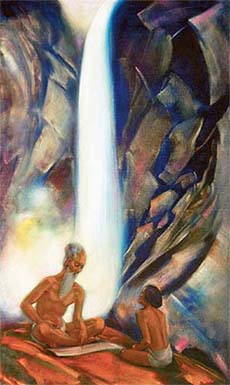 Long ago, even before the birth of the Greek and Roman Empires,
our Vedic seers had declared ‘vasudaiva kutumbakam’—‘the
world is one family”. Long before the modern world came out
with the concept of ‘universal welfare’ our Vedic prayer
throughout the ages has been ‘loka samastha sukinau bhavantu’—‘may
the entire world attain bliss’. Even the modern concept of
freedom of thought is respected in the Vedic verse, ‘ekam sat
vipraha, bahudha vadanti’—‘truth is one, the wise call it
by various names’. The verse expresses a mature understanding
of the human mind that the ancient thinkers of India possessed. Long ago, even before the birth of the Greek and Roman Empires,
our Vedic seers had declared ‘vasudaiva kutumbakam’—‘the
world is one family”. Long before the modern world came out
with the concept of ‘universal welfare’ our Vedic prayer
throughout the ages has been ‘loka samastha sukinau bhavantu’—‘may
the entire world attain bliss’. Even the modern concept of
freedom of thought is respected in the Vedic verse, ‘ekam sat
vipraha, bahudha vadanti’—‘truth is one, the wise call it
by various names’. The verse expresses a mature understanding
of the human mind that the ancient thinkers of India possessed.
Centuries ago when sects like Buddhism, Jainism and Sikhism came
as reformist movements to correct what their founders perceived
as wrong or unwanted in the society, the Hindus did not suppress
these reformers but gave them the freedom and space to grow. Sri
Adi Shankaracharya brought many back to the Hindu fold not
through force, coercion, incentives or threat but by preaching
in the form of debates.
Thus, Indian virtues like ‘pluralism’, ’tolerance’,
’freedom of thought’ and ‘universal welfare’ pre-date
the arrival of the ‘secular’ concept in India. This point
needs to be emphasised as in today’s India ‘secularism’ is
unjustifiably credited for all these Indian virtues and the term
is being misused to suppress the movement of ‘national
renaissance’, also known as Hindutva that aims at preserving
the very culture which actually deserves credit for these
age-old virtues of India.
Secularism originated in Europe centuries ago when the kings
revolted and overthrew the theocratic hegemony of the Pope from
over their kingdoms and established their own rule. But India
has never known such a conflict; thus the Western concept of
secularism was never relevant for India. However, today many
Indians perceive ‘secularism’ to be a synonym of
‘pluralism’ and ‘tolerance’; they also perceive the very
culture that blessed the Indian society with these noble
features from the Western perspective of being a ‘religion’.
The pseudo-seculars in India who swear by secularism would like
to have us believe that any threat or challenge to the concept
of secularism in India would endanger the age-old pluralism of
the country. Little do these self-proclaimed defenders of
secularism realise that wherever in the Indian sub-continent
Hinduism declines, with it declines the support for secularism
too (whichever kind of secularism that may be). Pakistan and
Bangladesh, two of our neighbouring countries, were formed out
of the same territory and people of undivided India, yet they
are far from being secular.
The need of the hour for India is the recognition of the fact
that India does not owe its great virtues of pluralism,
diversity and tolerance to any Western concept or ideology, but
to the influence of Vedic culture and philosophy over India. And
also to be understood is the fact that India’s age-old virtues
shall not be endangered by questioning the relevance of
secularism to the world’s oldest and most pluralistic
civilisation.
India
has always been a country that has welcomed reforms and
encouraged new ideas. It has never resorted to prejudicial
behaviour. Unfortunately, the manner in which the
self-proclaimed seculars in India spew venom over the movement
of ‘national renaissance’ and call for
‘de-saffronisation’ is in reality an act that is ‘de-Indianising’,
as it does not go well with the ethos of our ancient country
which tolerated different views.
(source: Indian
virtues pre-date ‘secularism’! - By Chinmay Bajekal
- indiacause.com).
(For
more refer to chapter on Greater
India: Suvarnabhumi and
Sacred
Angkor).
Top of Page
We are in
denial -
By Sri Sri Ravi Shankar
If
you come across a Communist, with a Hindu name, and ask him
about his identity, he will deny being a Hindu. Yet, a Muslim
Communist often claims his identity without hesitation. One
wonders what causes this difference in attitude.
It is
interesting to probe into the psyche of identity, which often is
a source of security, insecurity, conflict and comfort. Perhaps
the following reasons would answer the identity crises of the
Hindus. The broadmindedness of
Hinduism, its inherent inclusiveness and secularism, makes
Hindus feel guilty about claiming their identity, as it is
embedded in their philosophy that it is wrong to exclude others.
Claiming a religious identity makes them feel they are excluding
others and so they shy away from doing so.
Hindus have
been traditionally groomed by the Vedanta to drop all
identities. This has deeply influenced the Hindu psyche. Hindu
philosophy is woven around egolessness. Let alone their
religion, some sadhus don’t even say their name; they would
say, “What’s in a name?” Sanyasis are even shy to talk
about their parentage. A renowned ascetic in Rishikesh would
meet with everybody, but not his own mother and family. When
asked, he would say, “I am Vedanti; once I have taken sanyasa,
I have dropped all my identities.”
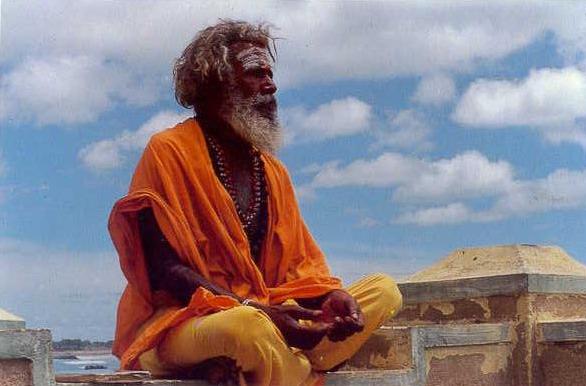
Hindus
feel ashamed of the ills of Hinduism — its superstition,
untouchability, and practices like sati are usually highlighted
in the media, rather than its unparalleled
philosophy and scientific
temperament. Thus, for several centuries Hindu bashing has
been a fashion.
(For
more refer to chapter on Greater
India: Suvarnabhumi and
Sacred
Angkor).
***
Hindus
feel ashamed of the ills of Hinduism — its superstition,
untouchability, and practices like sati are usually highlighted
in the media, rather than its unparalleled
philosophy and scientific
temperament. Thus, for several centuries Hindu bashing has
been a fashion.
The media
seems to have given the prerogative of Hindu identity to the RSS
and VHP and secular-minded Hindus would not like to associate
with these two organisations. As a result they shy away from
their own identity. Within India
itself, we witness a great deal of ignorance about the Hindu
religion and its scriptures. Although Hindus form 80 per cent
population of India, there is still only one university which
teaches Hinduism — whereas there are five which teach Islam,
five which teach Christianity, two which teach Sikhism and one
that teaches Jainism. You would find every Muslim would know a
couple of verses from the Quran; you can hardly find a Christian
who has not read the Bible.
But Hindus who know Sanskrit or a few shlokas are rare. Most
educated Hindus know the Bible; they know Christmas carols. When
they know nothing about their religion, how can they take pride
in it?
There
are 1.25 billion Hindus in the world, a little over one-sixth of
the world’s population, but you hardly find a single Hindu
lobby at international forums. You will find a Christian lobby,
a Muslim lobby or a Jewish lobby, but you can’t find a Hindu
lobby. Just 12 million Jews in the world are such a powerful
voice. Buddhists also have a voice and make their
presence felt at world forums. In countries of south and central
America and in Europe, although they are secular democracies,
they are not shy to proclaim their allegiance to Christianity.
You will find the religious symbol of the Cross placed in their
parliaments; chaplains offer prayer before every official
dinner. While associations like YMCA (Young Men’s Christian
Association) have gained wide acceptance. Why then is it that
Hindu associations are viewed with scepticism?
An identity is related to an action. Denial of
identity will dump you in inaction, sloth and lethargy and hence
Krishna reminds Arjuna of his Kshatriya identity even while
giving “Brahma gyan” to remind him of his duties and
responsibilities. Otherwise while giving this High knowledge of
the Self, why would Krishna remind him again and again of his
limited identity. The limited identity in no way contradicts the
universal one. A policeman cannot perform his duties — steer
the traffic — if he fails to acknowledge his identity.
Similarly, if a businessman shies away from his identity, he
cannot function. The same is the
story of Hindu identity. India cannot make a distinct mark on
the world if it ignores its religious and spiritual heritage.
(source: We
are in denial - By
Sri Sri Ravi Shankar -
indianexpress.com).
For more on
Sri Sri Ravi Shankar
refer to chapter on Quotes.
Top of Page
Secular brigade and the National anthem
After
the issues of tricolour and Veer
Savarkar, the Bharatiya Janata Party has stumbled
upon another 'anti-national' issue of 'deletion' of word
'Gujarat' from the national anthem in State Council of
Educational Research and Training (SCERT) textbooks in Kerala. "For
two consecutive years, the Kerala government has omitted mention
of 'Gujarat' from the national anthem printed in school
textbooks,"
"It is not an isolated case but is a part of a definite
vilification campaign, which has reached such a perverse level
where they can even distort the national anthem," He added
a message is being sent out that even 'nationalism is not
sacrosanct'.
The issue is being linked with Uma Bharti case of hoisting
tricolor and removal of Savarkar's
quotations from Andaman Cellular jail.
Incredibly, till yesterday, it
seemed it was the national anthem's turn to fall prey to the
'secular' brigade's programmatic iconoclasm. The
Kerala Education Department had omitted "Gujarat" from
the anthem printed in school textbooks for two consecutive
years. Last year, Standard V English textbooks carried the
jarring line: "Punjab, Sindh, Maratha, Dravida, Utkala,
Banga..." Agitation over Gujarat's omission at the time
died down after assurances on the required rectification.
For, here was a controversy that suggested that even
sacrosanct symbols of national identity were not immune to
vengeful point-scoring.
Rabindranath Tagore's Jana Gana Mana
is a patriotic celebration of unity-in-diversity. That
the song-first sung in the Indian National Congress's Calcutta
session in 1911- should have appeared to become a tool in the
hands of political axe-grinders seems an assault on all that
Indians hold precious. Habitual BJP-bashers may have thought
Gujarat's exit could be forced from India's collective
consciousness by turning it into an unsung cipher. But Gujarat,
as part of the soil the anthem sacralises, preceded its
latter-day denigrators. The "land of the Mahatma" will
also outlive them.
(source: Secular brigade and the National anthem
- Editorial – dailypioneer.com
- Sept 18 2004).
(For
more refer to chapter on Greater
India: Suvarnabhumi and
Sacred
Angkor).
Top of Page
Jews flock to Moses and Jesus tomb in
Kashmir
Srinagar, Sept. 11: Israeli citizens seem to be ignoring the
caveat issued in Jerusalem in August on Jammu and Kashmir and
are flocking to see the graves that some believe are that of
Jesus Christ and Moses.
More than 100 Israeli tourists have arrived here after Israel
instructed its citizens to leave Kashmir immediately. Only a few
of the visitors were unaware of the edict, say the officials
looking after the foreign tourists. With the increase in Israeli
arrivals, a number of houseboats on Srinagar’s Dal and Nagin
Lakes have put up boards and menus in Hebrew.
Official statistics show that more than 1,500 Israeli tourists
visited the Valley in 2003 while 1,623 Israelis spent their
holidays in Kashmir in the first eight months of the current
year alone. A sizeable number of Japanese, Korean, Malaysian and
other Sout-heast Asian tourists,
besides Britons and those from the continent, figured
prominently in the list of over 12,000 foreign arrivals so far
this year.
The main attractions in the Valley for the Israelis are two
graves, believed by some to be that of Jesus Christ and Moses.
The tomb said to be that of Jesus is located in Rozabal locality
in central Srinagar, and Moses’ near Bandipore town in North
Kashmir.
(source:
www.deccan.com/home/homedetails.asp
and http://p081.ezboard.com/fhinduunityhinduismhottopics.showMessage?topicID=21243.topic).
Top of Page
Angreziyat or Whiteness Study - By
Rajiv Malhotra
Demise of Non Western Cultures?
What
Marco Polo observed in the late CE 1250s (Travels of Marco Polo)
as cited in his observations from the "province of Maabar"
seems to be holding even today in most villages of Kerala and
Tamil Nadu...."In this province the natives, although
black, are not born of so deep a dye as they afterwards attain
by artificial means, esteeming blackness as the perfection of
beauty. For this purpose, three times every day, they rub their
children over with oil of sesame. The images of their deities
they represent black, but the devil they paint white and assert
that all the demons are of that color".
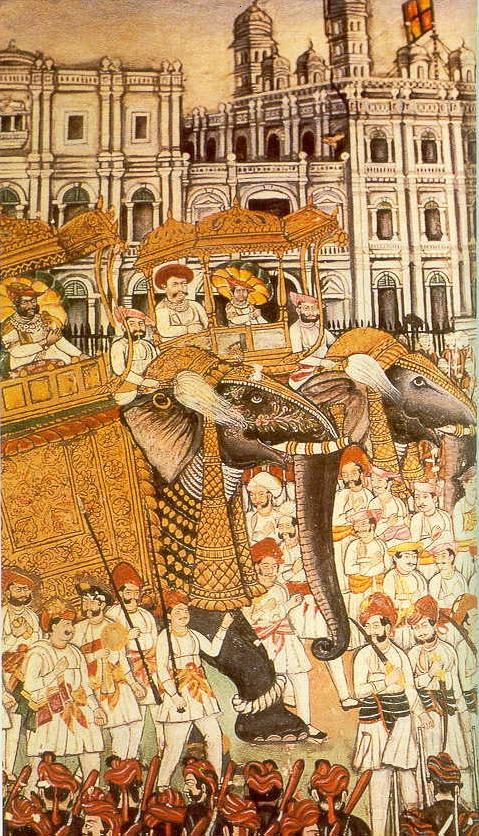
Indian
royalty.
(For
more refer to chapter on Greater
India: Suvarnabhumi and
Sacred
Angkor).
***
Angreziyat
was a local manifestation (in India) of global western cultural
dominance just as whiteness is a local manifestation (in the US)
of global western cultural dominance. These two concepts are
definitely related.
The
importance of western cultural studies (whether you call it
locally Angreziyat or Whiteness studies) is undeniable not just
because of western dominance in science, technology and economy
for about 200 years. It is absolutely essential to study it
because it is the only culture that has systematically studied
and passed judgments on every single other culture in the world
and has tried to influence and reshape every other culture in
the world. The only other culture that has tried to do something
like that is Islam. Islam did reshape entire North Africa and
parts of the Indian subcontinent culturally. It's effect,
however, pales in comparison to the western effort. Western
culture is the only culture in the history of man to dissect and
even to destroy (if possible) every single non-Western culture
with a ferocity and relentless that is without parallel. It has
tried and is trying even now to uproot the thought patterns of
non-western cultures. When Pope wants Christianity to reap a
rich harvest in Asia in this millennium, he is merely carrying on
that particular western tradition.
What
makes people from this culture behave like that? What makes this
undeniably great and probably the first global culture tick?
What can non-western cultures do to get their place in the Sun
in view of the relentless, ferocious, pity less onslaught of the
western culture? It is for seeking these answers that study of
western culture (Angreziyat or Whiteness or Westology) is so
important and in fact essential. The very survival of
non-western cultures depends on knowing the answers to these
questions.
(source:
Dialog
on Whiteness - By Rajiv Malhotra - sulekha.com). Also
refer to Myth
of Hindu Sameness - By Rajiv Malhotra - sulekha.com).
Top of Page
Hindus
of Kerala - A
race destined to be refugees in its native land
By
Dr C. I. Issac
That the Hindus of Kerala are getting to be a minority community
in their native land is not a secret any more. When India became
a republic, the Hindus of this land had a population share of
61.5 per cent. Today it has progressively and gradually declined
to reach the level of 55 per cent. This numerical decline in the
Hindu community cannot be treated as an inadvertent phenomenon.
If it is the state of the art of economic condition of the
Hindus, it is too pathetic and disastrous considering the
challenges they are facing in the cultural scenario of Kerala.
The cultural domain of Kerala is fast getting Christianised as
well as Islamised. Most of the visual and print media of the
state is either directly under the ownership/control of minority
communities or under their influence. This state of affairs is
favourable to create an atmosphere in favour of the minorities
in the cultural scenario. As a result, in the State School Youth
Festival, certain items of exclusive minority art with little
cultural value were included and non-Muslim students were
prohibited from participating in the State Arabic Youth
Festival. These are the best examples of the threat that the
Hindus are facing.
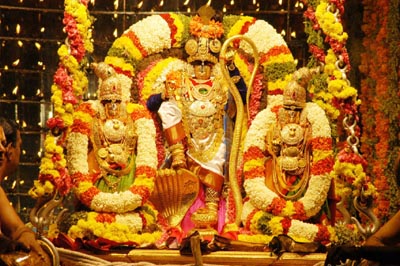
The cultural domain of Kerala is fast getting Christianised as
well as Islamised.
Through generations, Hindus have been worshipping the cow. The
only state in India which legitimises cow slaughter is Kerala.
According to official data available with the government,
5,00,000 cows were slaughtered in the state during 2002 and
2,49,000 tonnes of beef was sold (see The New Indian Express,
Kochi, August 13, 2003). In reality the real statistics of cow
slaughter are far from the official accounts. It is true that a
conspiracy is going on to force the younger generation of Hindus
to become beef-eaters. In the name of friendship, the minorities
are compelling Hindu boys to share beef preparations with them.
All these are indications of Hindu alienation and distancing
from its cultural domain.
(source:
Hindus
of Kerala - A
race destined to be refugees in its native land - By
Dr C. I. Issac -
organiser.org). Refer to Attacks
on Christian
Churches are Self-Inflicted - By
Sarath
Bulathsinghala).
Top of Page
Afghanistan
and It's Vedic Culture
"Indian
history is based on a strong foundation and I do not think its
fundamentals will ever be altered. New information will only
confirm what we have always believed"
-
Historian
R C Majumdar (1888 -- 1980).
Afghan"isthan"
was once center of Vedic Culture. The Indo Aryans definitely
lived in that region before migrating further either upwards or
downwards. For the Aryans Afghanistan was the land of the
Gandharvas or the celestial beings. The Gandharvas were depicted
in the Vedic scriptures as celestial beings, skillful in music,
with magical powers, and beautiful forms. In status they were
not equal to the devas, but regarded as higher beings with
divine powers, mischievous at times, but mostly friendly and
reliable.
In ancient times, the valleys of Afghanistan must have resonated
with the sounds of many caravans crisscrossing the country. The
Indus valley people conducted their overland trade with
Mesopotamia through Afghanistan. Their caravans carried a
variety of goods that included rare and precious stones,
minerals, food grains, resins, gold, silver and bronze, incense,
Pistachios and more. After the expansion of the Vedic culture
and the decline of the Indus valley civilization Afghanistan was
invaded and occupied by the Persian army headed by Darius, the
Great, (522 to 486 BC). We have little information as to who
were ruling Afghanistan at that time. Probably it was part of an
Indian kingdom from the Punjab region or was ruled by local
chieftains.
When Alexander marched towards India, he passed through the
mountainous territories of Afghanisthan and had to subdue many
native tribes in the region. In the course of multiple battles
he fought with them, his army was put to enormous strain and
loss. Since his army was not familiar with the territory and his
soldiers were not that skilled in mountain warfare, his army was
literally exhausted by the time they reached the Indian borders
and lost much of their motivation to fight further and march
deeper into the subcontinent. The tired and frustrated soldiers
insisted Alexander to return to their homeland. On their way
back, Alexander had problems once again in the region and had to
remain cautious till they crossed the borders of Afghanistan.
Alexander appointed Seleucus I as the viceroy of the Asian
territories he conquered, which comprised of a vast area that
stretched from the northwestern borders of India to most of
Anatolia and parts of Syria-Phoenicia. Selucus I was not able to
maintain his hold on the region for long. A few years after he
took over the reign, about 303 BC,
Chandragupta Maurya, the
founder of the mighty Mauryan Empire from eastern India waged a
war with Seleucus and defeated him.
As a part of the agreement, Seleucus I gave his daughter in
marriage to Chandragupta Maurya and also ceded him Afghanistan
and surrounding areas. For a few centuries from then on,
Afghanistan remained under the control of the Mauryan Empire and
enjoyed some degree of stability. During the Mauryan rule,
Buddhism spread into Afghanistan and became a dominant religion
there.
The Mauryan emperor who made this possible was Ashoka. He was
the son of Bimbisara and the grandson of Chandragupta Maurya.
During his reign the Mauryan empire reached its zenith. (See the
Map). Perhaps under no other ruler before him or after him, so
much of the country owed allegiance to one power.
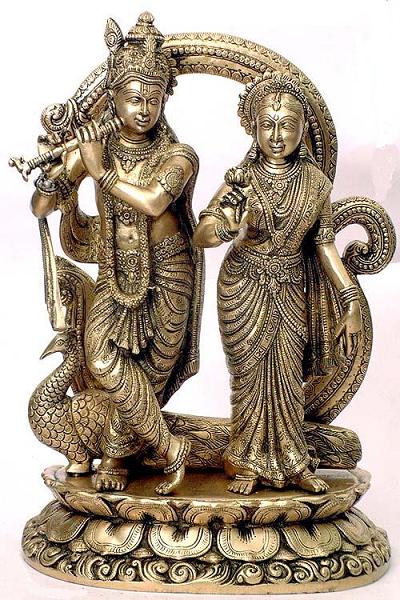
Radha Krishna
Afghan"isthan"
was once center of Vedic Culture. The Indo Aryans definitely
lived in that region before migrating further either upwards or
downwards.
(For
more refer to chapter on Greater
India: Suvarnabhumi and
Sacred
Angkor).
***
Ashoka had a special relation with Afghanistan. When he was
still a young prince, his father Bimbsara appointed him as the
viceroy of this region, with Taxila (Org.SK. Takshasila,
currently located in Pakistan near Rawalpindi ) as his
headquarters.
Taxila was then a great religious and trade
center. It was a great seat of Vedic learning, where flourished
the study of Vedic scriptures, many arts, crafts and ancient
sciences.
With the emergence of Buddhism in the region this
region started attracting Buddhist scholars too.
Originally a cruel king, who allegedly ascended the throne after
killing nearly a hundred of his own brothers, Ashoka underwent a
life transforming experience at the height of his career. In the
course of his conquests, which were many, he waged a bitter and
bloody war against the people of Kalinga. This kingdom existed
in those days in south eastern India, comprising the present day
Orissa. The people of Kalinga were equally ferocious and
stubborn people. Hence a bloody battle ensued in which there was
a huge bloodshed on both sides and thousands of innocent people
were killed, while materially nothing much was gained. The
tragedy of the war and the ruin it brought upon so many people
disturbed the emperor severely and changed his thinking forever.
From a ruthless and ambitious ruler, he became converted to
Buddhism and the ideals of compassion and non violence it
preached.
With in a few years after the war, he developed a
philosophy of his own called the law of piety or dhamma, which
was a hotch potch of Buddhist philosophy, Vedic dharma and the
prevailing social and moral values of his times.
He spent the rest of his life in pious activities and spreading
his dhamma, which he got carved into stone inscriptions in the
form of edicts. He appointed a task force to get those edicts
planted all over India as a reminder to the people of the moral
life he cherished them to follow. Encouraged by his patronage
and protection, the Buddhist monks traveled to various parts of
India and outside also to spread the teachings of the Buddha and
bring people to the path of righteousness.
The Mauryan empire declined after Ashoka and for sometime
Afghanistan was left to itself. But it came into lime light once
again with the invasion of the Bactrian Greeks. They invaded the
subcontinent during the second century BC and established their
power from the Oxus river in the west upto the Punjab in the
east. Afghanistan was under their control. Not much is known
about these new rulers. But we know that in matters of religion
and social life they adopted some local practices. While some
rulers turned to Hinduism for spiritual solace, some became
devout Buddhists and patronized Buddhism.
(source: http://www.afghanhindu.com/vedic.asp
and http://www.india-forum.com/forums/index.php?showtopic=2&st=150
). Refer to
My
People, Uprooted: "A
Saga of the Hindus of Eastern Bengal"
- By Tathagata Roy
Top of Page
Indian
Christians to become Hindu again
Dozens of former Hindu families in India are to be converted
from Christianity to back to Hinduism by Hindu
nationalists. The conversions are occurring today in an area
where a murdered Australian missionary lived with his wife.
Australian Christian missionary Graham Staines spent 30 years
of his life living and working with lepers in Baripada, in the
eastern Indian state of Orissa, before he and his two sons were
burned to death in their car by a hardline Hindu mob in 1999.
Today, under the guidance of the World Hindu Council known as
the Vishwa Hindu Parishad or VHP, dozens of converted Christian
families are to be reconverted to Hinduism.
The VHP's State Secretary Gouri Prasad Rath has said that it
would be "wrong to describe is as re-conversion".
"We call it homecoming," he said. Christian activists
in India oppose the reconversion ceremonies, claiming that
people are pressured into reverting to Hinduism.
(source:
http://www.abc.net.au/news/newsitems/200409/s1202306.htm).
Top of Page
Iowa Town Booms On Eastern Ways
- By Kari
Lydersen
Vedic City, Iowa -- When Eric Schwartz decided to move
his financial services business from Silver Spring here to
southeastern Iowa so he could join other practitioners of
Transcendental Meditation in 1992, he worried that clients and
colleagues might think he was a little crazy.
"Some people think TM
(Transcendental
Meditation) is some kind of cult or
devil worship," he said. "I thought it might be
negative for my business, that customers would freak out."
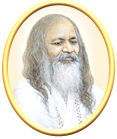 Things turned out just the opposite. Many other people
in Vedic City and neighboring Fairfield feel the same way. The
community founded by followers of the Maharishi
Mahesh Yogi, the Beatles' meditation guru, has become
an entrepreneurial mecca of the Midwest. Followers began
flocking to Fairfield after the establishment of the Maharishi
University of Management in 1974, and Vedic City just outside
the limits of Fairfield was incorporated in 2001, the first new
Iowa city to be incorporated since 1982. Residents estimate that
one-fourth of the 10,000 people in Fairfield and Vedic City
practice TM. Things turned out just the opposite. Many other people
in Vedic City and neighboring Fairfield feel the same way. The
community founded by followers of the Maharishi
Mahesh Yogi, the Beatles' meditation guru, has become
an entrepreneurial mecca of the Midwest. Followers began
flocking to Fairfield after the establishment of the Maharishi
University of Management in 1974, and Vedic City just outside
the limits of Fairfield was incorporated in 2001, the first new
Iowa city to be incorporated since 1982. Residents estimate that
one-fourth of the 10,000 people in Fairfield and Vedic City
practice TM.
Vedic is a Sanskrit word
meaning "totality of knowledge." Residents live in
spacious homes designed with entrances facing east, small onion
domes called kailashes on top and rooms oriented to correspond
with the cycles of the sun and moon. Practitioners of TM
generally meditate for 20 minutes twice a day.
Mario Orsatti, a Philadelphia native who studied with
the Maharishi in Europe and moved to Fairfield in 1978, noted
that the growing acceptance and popularity of alternative
medicine and Eastern philosophy are also key to the area's
success.
"It was a lot different
30 years ago," he said. "There was a lot of suspicion
of things that are foreign, things from India. Today lots of
people are doing yoga and meditation, looking at our tradition
and saying, 'That is so cool.' Lots of small midwestern towns
are dying, but Fairfield and Vedic City are thriving. People are
moving here instead of moving away. Iowa would love to see this
happening everywhere."
(source:
Iowa
Town Booms On Eastern Ways - washingtonpost.com).
Top of Page
Beyond
the legend ... A
badge of identity
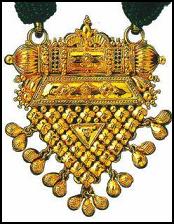 When
he was Deputy Prime Minister, Morarji Desai visited the Gulistan
Palace in Iran and stood before the fabled Darya-i-Noor diamond.
It was the glittering prize of the fabled collection of jewels
in the Shah of Iran's treasury that included at the far end of
an underground museum the even more exotic Peacock Throne. As
the delegation of Indians stopped at each one of the glass
displays, each person could only feel a sense of exalted pride
and intense sorrow. When
he was Deputy Prime Minister, Morarji Desai visited the Gulistan
Palace in Iran and stood before the fabled Darya-i-Noor diamond.
It was the glittering prize of the fabled collection of jewels
in the Shah of Iran's treasury that included at the far end of
an underground museum the even more exotic Peacock Throne. As
the delegation of Indians stopped at each one of the glass
displays, each person could only feel a sense of exalted pride
and intense sorrow.
"These
are treasures that really belong to us," was the general
feeling. "This is part of the wonder that was India."
In case after case, emeralds, rubies, gorgeously made items of
enamelware in gold, daggers and swords hilts, even the
Shahbanu's favourite crown with its pink diamonds had originally
been in India, taken for the most part by Nadir Shah during his
sack of Delhi in 1739.
Indeed,
in most of the jewellery displays around the world, whether at
the Tower of London, where the Kohinoor is displayed in the
Crown jewels of the Queen of England, or at the Smithsonian in
Washington, where the blue tinged Hope Diamond beckons the
visitor with the full mystery of its curse still intact, among
other pieces that once formed part of the French
"Emperor" Napoleon's collection, it's difficult for
most Indians not to exhibit a sense of intense nostalgia.
The
Rig Veda mentions the custom of using coins as ornaments.
Or as Usha T. Bala Krishnan records in her gorgeous compendium
on "Indian Jewellery Traditions" (Dance
of the Peacock. Jewellery Traditions of Indian, with
Meera Sushil Kumar) the Mahabharatha
mentions, "an ornament for both men and women a round piece
of gold tied at the neck in a string or chain, at times several
such pieces strung into a necklet".
The
famous Dancing Girl of Mohenjadaro wears a piece of string
around her neck on which dangles three leaf-shaped pendants.
Even today, whether among the tribal communities who might use
silver coins or the richer strata of people, this necklace, or
chain made up of coins (with each coin strung together with a
decorative clasp) is one of the most popular forms of jewellery.
Of
course the fabled mineral wealth of the country was a good
reason why there were so many visitors in the first place, as
the many stories of plunder and looting by famous invaders
testify.
Just
as the legends of serpent kings and nagas living at the
foothills of impregnable mountains, in secret temples hidden in
dark forests, guarding a precious gem might still be said to
hold the imagination of the public in the many types of
ornaments that are fashioned in the form of serpent coils and
serpent heads, or nagapadams. Obviously, many of the
legends were meant to deter people from plundering wealth from
ancient temples and fortresses.
Or
as Oppi Untracht who has written the most exhaustively examined
account of Indian jewellery traditions, ("Traditional
Jewellery of India") observes in the book, "Rarely is
an Indian ornament simply decorative and devoid of inherent
meaning or symbolic value". He
also goes on to comment, "At the same time, jewellers of
the Western world fed upon the creative design concepts of the
Indian jewellery and created a synthetic Indo-Western style by
adapting several of its characteristic elements. Once these
entered the lexicon of the Western design resources, their
Indian origin was often unacknowledged or over-looked".
(source:
Beyond
the legend - hindu.com).
For more refer to chapter on Islamic
Onslaught and European
Imperialism).
Top of Page
Yarn of the
priceless pearl carpet that has vanished
Indian princes
were well-known for their exotic jewels and treasures. But, even
among such potentates, the pearl carpet, once owned by the
Maharaja of Baroda, was a rare item, and it ranks with the Peacock Throne as a symbol of fascinating India.
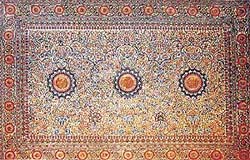 In
the early 1860’s, Maharaja Khande Rao
of Baroda, who owned
fabulous diamonds like the Star of the South, became possessed
with a strange desire, that he must offer a priceless pearl
carpet at the shrine of Prophet Mohammad in Medina. We do not
know as to what made him take this vow. It appears that he
wanted a pearl carpet, or chaddar, as it is reverentially
called, to be gifted by him and spread over the Prophet’s tomb
in the mosque at Medina in Arabia, just like the pearl carpet
which was spread over the tomb of Mughal Empress Mumtaz Mahal in
the famous mausoleum of Taj Mahal at Agra. But, this idea
of a grand gift to an Islamic shrine by a Hindu sovereign was
not liked by his palace officials and other courtiers. After
all, Baroda was a Hindu state. But the Maharaja was adamant and
by 1865 the carpet was ready. But after Maharaja Khande Rao
died, the pearl carpet was not sent to Medina, and was retained
as a state treasure in Baroda. In
the early 1860’s, Maharaja Khande Rao
of Baroda, who owned
fabulous diamonds like the Star of the South, became possessed
with a strange desire, that he must offer a priceless pearl
carpet at the shrine of Prophet Mohammad in Medina. We do not
know as to what made him take this vow. It appears that he
wanted a pearl carpet, or chaddar, as it is reverentially
called, to be gifted by him and spread over the Prophet’s tomb
in the mosque at Medina in Arabia, just like the pearl carpet
which was spread over the tomb of Mughal Empress Mumtaz Mahal in
the famous mausoleum of Taj Mahal at Agra. But, this idea
of a grand gift to an Islamic shrine by a Hindu sovereign was
not liked by his palace officials and other courtiers. After
all, Baroda was a Hindu state. But the Maharaja was adamant and
by 1865 the carpet was ready. But after Maharaja Khande Rao
died, the pearl carpet was not sent to Medina, and was retained
as a state treasure in Baroda.
It
was a carpet made of diamonds, pearls, rubies and emeralds and
measured, roughly, seven and half feet by six feet.
In 1879, Sir George Birdwood, the eminent connoisseur of Indian
jewellery, called it "The most wonderful piece of
embroidery ever known." Composed entirely of wrought pearls
and precious stones disposed in Arabesque patterns, it was
valued at Rs 6 million when made in 1865. Although the richest
precious stones were worked into it, the effect was harmonious.
When spread out in the sun, it seems suffused with an iridescent
glow, as gratifying to the eyes as were the exquisite forms of
its Arabesques. Its base was made of deerskin and silk stitched
together. The design is mostly made of pearls with a restrained
effect and with dignified, classic Arabesque-Mughal-derived
designs".
The last time the public saw it was during the
Delhi Durbar of 1903, when the then Maharaja of Baroda, Sir
Sayaji Rao Gaekwad, allowed it to be displayed, as a mark of
respect for the British sovereign. This
pearl carpet was in India till the early 1940’s. One does not
know, as to when it was taken out of the country. But till 1947,
the maharajas were free to take their treasures in and out of
India during their frequent trips to Europe and America. In
1943, the then Maharaja of Baroda, Sir Pratap Sinh Gaikwad,
married a beautiful woman known as Sita Devi, who became his
second maharani. Sita Devi took up her residence in Europe and
soon, most of the Baroda treasures were transferred to her
mansions in Monte Carlo in southern Europe. But in 1947, the
state of Baroda was merged with India. Outraged by the
anti-India activities of the Maharaja, the Government of India
deposed him and forced him to return to India some of the most
precious items, like the seven-strand diamond necklace and the
fabulous seven-strand pearl necklace. But the pearl carpet
continued to be in the possession of Sita Devi.
Her marriage
with the Maharaja ended in a divorce in 1956 and the Gaikwad
himself died in London in 1968. Sita Devi survived him by 18
years. By then the fabulous Baroda treasures had been
dissipated. But, it appeared, that the pearl carpet was intact,
and it was thought to have been kept in a bank vault in Geneva.
Eminent Indologist Stuart Welch, in his book, Indian Art A.D.
1300 to 1900, ascribes the picture of the pearl carpet in the
book to "Sita Devi collections".
The
treasure’s history was updated in January, 1994, when a news
item appeared in Indian and Arabian newspapers, describing the
Baroda pearl carpet as a 400-year-old prayer rug. A report
quoted a Saudi-based agent, Hisham-al-Baroodi, as saying that he
was currently negotiating with relevant Saudi officials to take
the rug to the kingdom, where he was confident of funding a
buyer. The account described the rug as being decorated with
three shining diamonds in the middle, laced with pure gold and
surrounded by blue, red and turquoise-blue pearls. According
to eminent Mumbai jewellers, this Indian national treasure has
now vanished into the vaults of one of the multi-billionaire
Arab oil magnates, and the outside world may not see it again.
(source: Yarn
of the priceless pearl carpet that has vanished -
tribuneindia.com).
Top of Page
Muslims Join in Durga Festival in
Germany
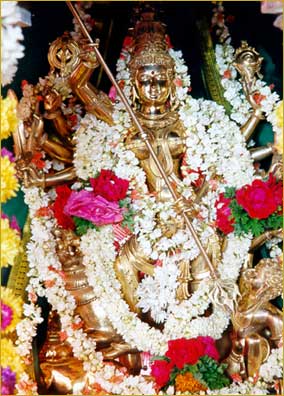 Cologne,
Germany, October 22, 2004: This year's Durga Puja festival,
celebrated here by the Germany-based Bengali community with much
fanfare and devotion, has turned into a veritable show of
Hindu-Muslim amity. Many Muslims are taking part and lending a
helping hand in the organization of the Oct 19-23 festivities at
the Buergerzentrum Chorweiler - the local town hall - of this
city on the banks of the river Rhine. The festival has been held
under the aegis of the Indischer Kulturverein - or the Bharat
Samiti - a Cologne based Indian cultural association dominated
by people of Bengali origin, though it also claims other Indians
and even Muslims from Bangladesh amongst its members. Cologne,
Germany, October 22, 2004: This year's Durga Puja festival,
celebrated here by the Germany-based Bengali community with much
fanfare and devotion, has turned into a veritable show of
Hindu-Muslim amity. Many Muslims are taking part and lending a
helping hand in the organization of the Oct 19-23 festivities at
the Buergerzentrum Chorweiler - the local town hall - of this
city on the banks of the river Rhine. The festival has been held
under the aegis of the Indischer Kulturverein - or the Bharat
Samiti - a Cologne based Indian cultural association dominated
by people of Bengali origin, though it also claims other Indians
and even Muslims from Bangladesh amongst its members.
Association president D.K. Bannerjee, a businessman, said the
festival reflected the "true spirit of reconciliation and
brotherhood among people of all faiths." "We have had
Muslim volunteers from Bangladesh helping out in our kitchen and
cooking food for five days on a voluntary basis," he told
IANS. Many of the volunteers have taken leave of absence from
their work for several days to help in organizing the program.
The organizers have set up huge icons of Durga, as well as of
Laxmi, Saraswati and Kartika, on an elevated pedestal at the
Buergerzentrum Chorweiler.
As part of the festivities, the organizers have arranged for
Indian classical music and dance performances, as well as modern
Indian dances and music in the evening, besides serving free
food to the guests, who usually number between 300 and 400 each
evening. Many Germans have also been present at the Durga Puja
celebrations. "Our German guests are impressed by the
dazzling colors, the food and culture but, more importantly,
they are interested in the philosophy of Durga's fight against
injustice and the evils in this world," Bannerjee
explained. Peer Steinbrueck, minister-president of the state of
North Rhine Westphalia, in which Cologne lies, is the patron of
the Durga festival.
(source: Muslims
Join in Durga Festival in Germany - hinduismtoday.com).
Top of Page
Mother
Teresa was used by India: says Author Dr Gezim Alpion
In
what many are calling a controversial revival of a 30-year-old
debate about the diminutive nun’s real worth, Teresa’s
compatriot, Dr Gezim Alpion, tries to find out why she was
supported by nearly all Indian governments after 1950.
This,
despite her being a white western Catholic female and despite
India’s minuscule Christian population totalling just two per
cent, points out Alpion, in his forthcoming volume, ‘Biased
Discourse: The Case for Mother Teresa’.
Alpion
insists he is less carping critic than bemused admirer of his
fellow Albanian who was hailed worldwide for her selfless work
among the sick and poor in contemporary Calcutta’s black
holes. “How come we don’t know much about Mother Teresa when
she wasn’t in India; her ‘sainthood’ started in
Albania,” he told TOI on Friday. He
claimed that the nun was “used” by the Indian government to
promote an image of unity in diversity, after India's recent,
bitter experience of Partition. “The Indian establishment
felt, we have a white, European, Catholic”.
Alpion’s
study, the first by someone of Mother Teresa’s ethnicity,
offers an interesting twist in the nun’s extraordinary saga. It
says the world’s media deliberately refused to recognise her
Balkan roots, after Malcolm Muggeridge discovered Mother Teresa
in 1968. He says it’s time to take an informed and impartial
look at how the tiny nun went on to become an iconic image
embraced by royalty and rough-sleepers alike. There could have
been no Mother without the media. Her myth was carefully crafted
over the years by the Roman Catholic Church, numerous Indian
governments and several White House administrations, he
declares. Somewhat controversially for the nun’s legions of
admirers worldwide, he adds that Teresa was hardly passive in
this international image-making process. She always had a say in
what should and should not be said about her.
(source: Mother
Teresa was used by India: says Author Dr Gezim Alpion
- By Rashmee Z Ahmed/TNN - The Times of India
Date: October 16, 2004).
Mother
Teresa of Calcutta was a powerful propaganda machine and public
relations guru who manipulated the media to mould her public
image, a Birmingham academic claimed today. Dr
Gezim Alpion, an English and Cultural Studies lecturer at the
University of Birmingham, argues that the image of the
Albanian-born nun, who died in 1997, was carefully crafted by
the Roman Catholic Church.
(source: Mother
Teresa 'was a PR guru'
- icbirmingham.co.uk.
For more refer to chapter on Conversion).
Top of Page
Dalits:
Kanchi leads the way - By Sandhya Jain
The Shankaracharya
of Kanchi, Swami Jayendra Saraswati, broke a
critical stalemate in the current controversy over the merits of
the Tamil Nadu ban on conversions by force, fraud or inducement,
by offering worship at a Dalit-run temple in Madurai (The Hindu,
12 Nov. 2002). The Veerakali Amman temple, which serves the
religious needs of eighteen villages and has a Dalit priest,
lies in the Melur region where 250 Hindus were converted en
masse by a Canadian priest of the Seventh Day Adventists on 25
August 2002. Previously, about fifteen hundred Hindus were
converted in the neighbouring areas in January 2001. By
giving the villagers an unexpected darshan, the Shankaracharya
gracefully shattered several myths and assumptions about
inequality and divisiveness in Hindu society.
Speaking with his legendary
forthrightness, the seer told the gathering what many of us have
always known, namely, that Hindu dharma does not promote or
envision discrimination and regards people of all sections of
society as equals. He rightly stressed that Hindus have an
age-long tradition of living amicably as a "family",
as brothers and sisters. Candidly accepting that there are
always differences in society, he advised the people not to
foster discrimination on this count, as unity has ever been the
hallmark of the dharma.
The
Shankaracharya has truly led by example, with a view to blunting
the criticism of evangelizing faiths that social discrimination
compels Dalits to embrace other faiths. Swami
Jayendra Saraswati, however, has risen above this cacophony to
remind us that we cannot seek refuge in such specious arguments,
and that it is our duty to uphold the principle of the
brotherhood of man in our own lives. It is now enjoined upon
each one of us to be worthy followers of a worthy leader. Tamil
society in particular must rise to the occasion and accord the
Dalits the personal dignity they crave for; a beginning must be
made by doing away with the degrading two-glass system at
village dhabas. In this regard, it may be worth noting that the
Swamiji's choice of temple was singularly apt. The Veerakali
Amman temple attracts devotees from all castes and is also a
locally renowned symbol of communal harmony as Muslims regularly
join the celebrations of its annual festival in January.
What is most exciting about this new call from the bastions of
the mainstream tradition is that it cannot be set aside lightly
as a maverick or fringe movement. Swami
Jayendra Saraswati followed up the Madurai initiative at
Tirunelveli by categorically asserting that Dalits have the
right to enter any temple across the State, individually, and
offer prayers. This may not make sense to many
urban citizens. But what it means is that at many
important temples, Dalits from outside the region do enter
anonymously along with other pilgrims, but local Dalits who
might be recognized would be barred or beaten for entering the
precincts.
Now an orthodox Hindu leader with unparalleled knowledge of the
shastras has ruled that "appropriate action" would be
taken against those trying to prevent a Harijan from entering a
temple. And as the cosmic vision of the Hindus does not envisage
the shallow separation of religion and the public sphere, as
Mahatma Gandhi had intuitively understood, the Shankaracharya
has rightly asserted that religious leaders must increasingly
participate in public life to foster a social renaissance
Nonetheless,
much water has flown under the bridge, and communities have
grown to the point that many individuals wish to stake claim to
a larger Indic heritage. Hindu tradition is by definition
inclusivist rather than exclusionary, hence deference to the
sentiments of non-Hindu devotees would be highly appropriate.
The present move is the result of the hurt felt by many at a
perceived injustice to celebrated singer K.J. Yesudas, a great
bhakta of Guruvayurappan, who has been denied temple entry on
account of being born in a Christian family. The poet Yusufali
Kecherry, who has written some of the best songs in honour of
Lord Krishna, has also been excluded from Guruvayur because of
his Muslim origins.
(source:
Dalits:
Kanchi leads the way - By Sandhya Jain - daily pioneer. com - November
19 2002).http://www.hvk.org/articles/1102/135.html
(For
more refer to chapter on Greater
India: Suvarnabhumi and
Sacred
Angkor).
Top of Page
UN and Religious
Proselytization Petition
Stop the destruction of Indigenous
cultures.
The petition is at: http://www.petitiononline.com/unchr900/petition.html
Hindu Council launches anti-conversion
petition
The Hindu Council UK is spearheading a campaign for people to
sign an anti-conversion petition to be presented to the UN High
Commission for Human Rights and the United Nations General
Assembly. The petition will request that proselytization must be
eliminated in the interest of promoting world peace and harmony
and respectful coexistence of all religions.
Addressed to Soli Sorabjee, Chairman, UN Sub-Commission on
Promotion and Protection of Human Rights, Louise Arbour, UN High
Commissioner for Human Rights, Kofi Annan, Secretary-General,
United Nations and Heads of States of all Secular Nations, the
petition says there are deep concerns about inter-religious
conflicts fomented by the proselytizing activities of certain
sects.
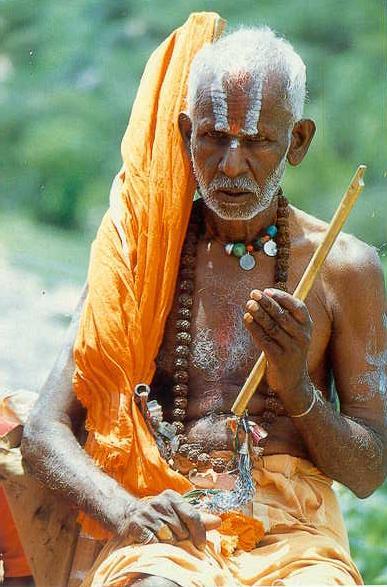
"We are troubled by the likelihood of major clashes of
civilizations resulting from the exclusive truth claims of
monotheistic religions. We also anticipate such conflicts will
weaken the social fabric of many countries by pitting religions
against one another and destroying indigenous cultures."
(For
more refer to chapter on Greater
India: Suvarnabhumi and
Sacred
Angkor).
***
It points out that large majority of Muslims and Christians do
not harbour such grand aspirations and are opposed to the
proselytizing schemes. It says:
"We are troubled by the likelihood of major clashes of
civilizations resulting from the exclusive truth claims of
monotheistic religions. We also anticipate such conflicts will
weaken the social fabric of many countries by pitting religions
against one another and destroying indigenous cultures."
"Further, we are firmly convinced that we should act now to
prevent all inter-religious conflicts and the occurrence of
greater misery, death and destruction than what we have
witnessed thus far in the course of human history, most brought
about by the evils of proselytization."
(source: UN
and Religious Proselytization Petition. For
more refer to
Bush's
Conversion Agenda for India: Preparing for the harvest
and chapter on Conversion
and Their
Other "Dirty" Linen: Evangelism's Quest to Conquer the
World
- By S R Welch - secularweb.org).
Refer to Attacks
on Christian
Churches are Self-Inflicted - By
Sarath
Bulathsinghala).
"Conversions are
objectionable because they invariably involve loss of identity.
This is unavoidable because the religions that proselytize are
those that have aggressively destroyed the heritage and roots of
the societies whose adherence they won, usually by violence. A
cursory glance at the European, African, North and South
American and Australian continents will testify to the veracity
of this statement." says columnist Sandhya Jain.
Top of Page
Hindus
in Arabia : The Durjas Tribe ?
Then
65 years ago and now. The world today is quite familiar with the
presence of expatriate Indians in large numbers in the Islamic
countries of West Asia. Naturally, a large proportion of the
repatriates comprise of Hindus.
That, in 1940 itself, there had been a precedent for such a
presence may come as something of a surprise to our readers
today. More so, when those Hindus were reported to have been
present in Arabia for some centuries then!
Extracts from a communication sent to this newspaper by Shri
T.S. Vinayaka Rao, an advocate of Madras:
Hindus in Arabia
“At this juncture, when the war threatens to spread to the
Near East, it will be interesting to learn that a community of
people who are Hindus, and who are idol-worshippers, have been
existing in Arabia for several centuries. They live surrounded
by Muslim tribes.
“This Hindu community, which is well-organised, almost on the
patterns of a little tribal state, was originally under the rule
of Turkey. But, after the Great
War of 1914,
it came to be held under the mandate of France...
“The people of the above Hindu community speak Arabic, and
they call themselves the ‘Durjas’. Their full name in Arabic
is ‘Davil Dal Duruj’ which means ‘people of the Durja’.
“The Durjas are divided into two notable classes, one group
comprises those who wear the orthodox tuft, and those who do not
do so. Those who do not wear the tuft are in greater number... The
Durjas are worshippers of Siva and Ganapati and they have idols
installed in temples for their worship. Some of their shrines
are actually built very much on the lines of Hindu temples in
India. Many others have adopted the pattern of mosques. Whatever
the construction of the shrines, they all have priests who
perform sequences or rituals including that of arati.
“The religious books of the Durjas are found to be in Arabic
script. They are written in the form of poetical lines and the
priests have committed most of the books to their memory. Both
the men and the women have modelled themselves on the Arab
tribes and therefore display extremely war-like qualities and
manners. Hence, repeated efforts over several centuries to
convert them to Islam have failed. Similarly, strenuous efforts
by the Muslims to exterminate them altogether have also been
frustrated... A significant difference marking the Durjas out is
the refusal of their women to wear purdah. The survival of this
freedom from their ancient Hindu origins is another surprising
fact.”
(source: The Hindu, August 5,
1990)
http://www.saag.org/BB/view.asp?msgID=6321
Top of Page
 Did You Know? Did You Know?
Stamp
Issued to Honor Sanskrit Grammarian Panini
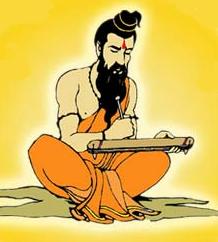 Panini was an
Indian grammarian who was believed to have flourished around. c.
400 B. C. His AshtAdhyAyI [eight books] (tr. 1891) is one of the
earliest works of descriptive linguistics and is also the first
individually authored treatise on Sanskrit. He was born: about
520 BC in Shalatula (near Attock), now Pakistan Died: about 460
BC in India . Panini was an
Indian grammarian who was believed to have flourished around. c.
400 B. C. His AshtAdhyAyI [eight books] (tr. 1891) is one of the
earliest works of descriptive linguistics and is also the first
individually authored treatise on Sanskrit. He was born: about
520 BC in Shalatula (near Attock), now Pakistan Died: about 460
BC in India .
Panini's
Sanskrit grammar, produced in about
1300 B. C. E. is the
shortest and the fullest grammar in the world. Panini composed a
Sanskrit grammar called the Ashtadhyayi.
In 4,000 short verses, it
revealed the inner mechanics of Sanskrit - how the language worked
and how new words evolved.
Sir
Monier-Williams (1819-1899) Orientalist,
professor of Sanskrit at Oxford in 1860. He made a lengthy and learned introduction to his monumental work:
Sanskrit-English Dictionary. He wrote:
"The Panini grammar reflects the
wondrous capacity of the human brain, which till today no other country has been able to
produce except India."
"The
grammar of Panini is one of the most remarkable literary works that
the world has ever seen, and no other country can produce any
grammatical system at all comparable to it, either for originality
of plan or analytical subtlety."
Walter Eugene
Clark writes in The
Legacy of India, p. 339-340:
"Panini's
grammar is the earliest scientific grammar in the world, the
earliest extant grammar of any language, and one of the greatest
ever written.
Delhi, India August 30, 2004:
The Department of Posts has released a postage stamp today in
commemoration of India's Heritage in Grammar and Mathematics
which was influenced by the accomplishments of Panini, one of
the greatest grammarians of all time whose work revolutionized
the use of language not only in India but also in the rest of
the world. The stamp is in the denomination of Rs. 5. Panini,
whose lifetime was believed to be between 520 BC and 460 BC, was
born in Shalatula, a town near Taxilla on the Indus river in the
present-day North-West Province in Pakistan. Panini's brilliant
account of the structure of the Sanskrit language seeks to
provide a complete, maximally concise and theoretically
consistent analysis. It unfolds a theory of human language where
the infinite language is generated by finite grammar which
modern linguistic acknowledges as the most complete, generative
grammar of any language yet written.
(source: http://www.pib.nic.in/release/release.asp?relid=3583).
For more on
Panini refer to chapter on Sanskrit).
(For
more refer to chapter on Greater
India: Suvarnabhumi and
Sacred
Angkor).
Top of Page
|